
Wildlife Photo Diary 2024
November 2024
Scoters and Egret hunting......
A trip along the Norfolk coast with Jason Nichols (7th) began as usual at Beach Road, Salthouse where a couple of Stonechats were seen.
Two more Stonechats were seen along the fence at the top of the Eye Field at Cley before we had a look out to sea. Here we found 7 Velvet Scoter and approximately 70 Common Scoter, plus a Red-throated Diver on the sea.
Morston Quay provided us with 2 Rock Pipits around the boats along the channel edge and a Little Egret and several Brent Geese were of note too.
At Wells Pools there were plenty of Wigeon and Grey-lag Geese and a Redshank but little else, so we continued to Brancaster Staithe for lunch.
A good variety of waders, albeit in small numbers were seen here including; Curlew, Turnstone, Ringed Plover, Dunlin, Grey Plover, Black-tailed and Bar-tailed Godwits, Oystercatcher, Redshank and Jase found a Greenshank at the far end of the channel.
7 Little Egrets were here including one hunting for food fairly close by, so an opportunity to try and get some behavioural photos in between eating lunch. The egret was successful in catching the occasional ‘small’ meal’ and one of the photographs revealed what looked like a 10-spined Stickleback. The egret was very territorial, especially towards Gulls but pretty much chased every bird that came anywhere close.
Approximately 100 Brent Geese flew in and Jase spotted a Rock Pipit at the far side of the channel.
At Thornham Marsh Harrier and a Red Kite were seen before heading towards Choosley.
Driving along the road towards the barns a Red Kite floated over and back across the road and 6 Redwings were seen in the Hawthorns. A Brown Hare was seen at the back of quite a few Red-legged Partridges where there were also a couple of Yellowhammers and a total of 4 Chinese Water Deer were seen, a species, up until a few years ago were absent from the area.
A look from the lay-by along the A149 at Burnham Overy saw skeins of Pink-footed Geese flying in, before a stop at Holkham found a Great White Egret join a Grey Heron amongst the black and white cattle and a Common Buzzard was seen perched on a telegraph post and a Red Kite was over the Freshmarsh.

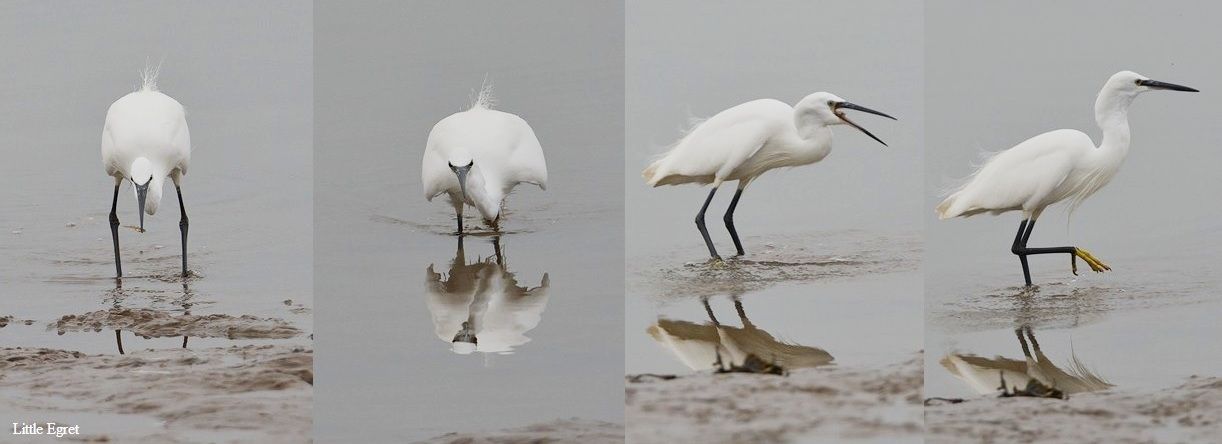
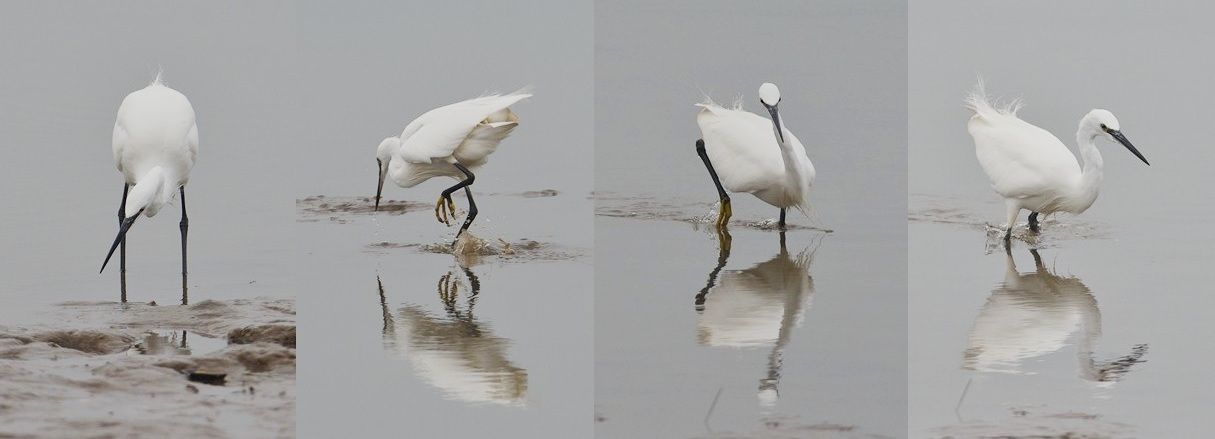
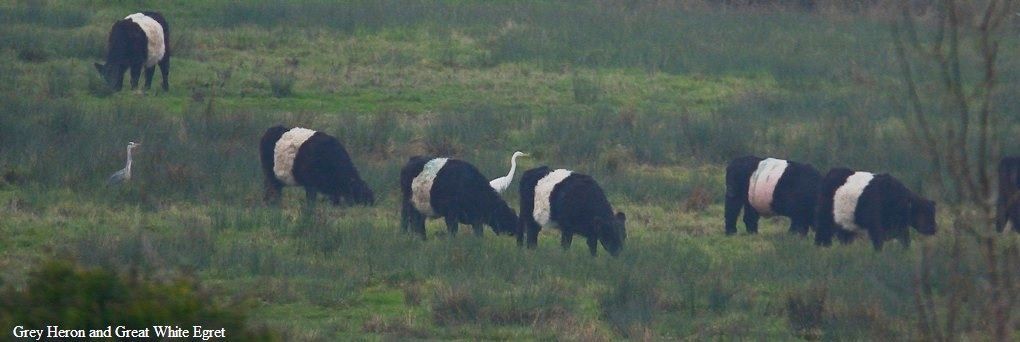
October 2024
Mill pond Yellowlegs, Great Whites and Cranes......
Another short day out with Jason (28th), but this time mainly down to some of my computer editing problems!
Anyway, we headed to Buckenham Marshes and after seeing a variety of wildfowl: Canada, Grey-lag, Pink-footed Geese, Mallard, Wigeon, Gadwall, Teal and Shoveler we began the walk to the ‘Mill Pool’ where there was reported to be a Lesser Yellowlegs.
Apparently the yellowlegs had been commuting between the main pool and the mill pool but we could not see it on the main pool and as the last place it had been reported was just past the mill we headed there.
Along the way we came across a ‘pair’ of Stonechats before reaching the mill pool, where sure enough was a Lesser Yellowlegs feeding close to a Common Gull. Although far away a few images were taken and later the yellowlegs was joined by a Ruff on the pool. A Chinese Water Deer could be seen in the distance, where there were more Pink-footed Geese.
We headed back to the car and heard a Water Tail screeching from the riverside reeds and saw the Stonechats again.
After replenishment at a well-known American drive through we headed back through Acle and once over the bridge looked for the 4 ‘white birds’ seen on the way to Buckenham. Sure enough they were still there and as suspected were Great White Egrets. 4 in a field together; wouldn’t have thought that possible in the UK a relatively short while ago!
We pulled in at the barn and over the reeds two of the Great Whites were still visible and to our right were Pink-footed Geese, constantly on the move and a Common Buzzard flew up from a nearby field.
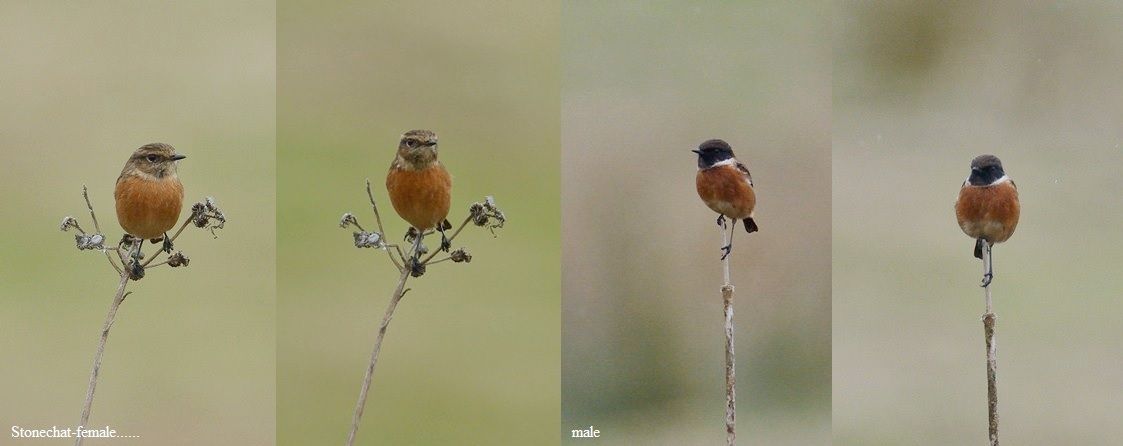

We headed back to Martham, but on the way took an excursion around ‘the block’ between Clippesby and Ashby. Stopping at our usual pull-in I happened to look up to see a flock of Cranes flying over. A few ‘snaps’ of these ensued as all 15 of them headed for pastures new; a fitting end to a very rewarding few hours.
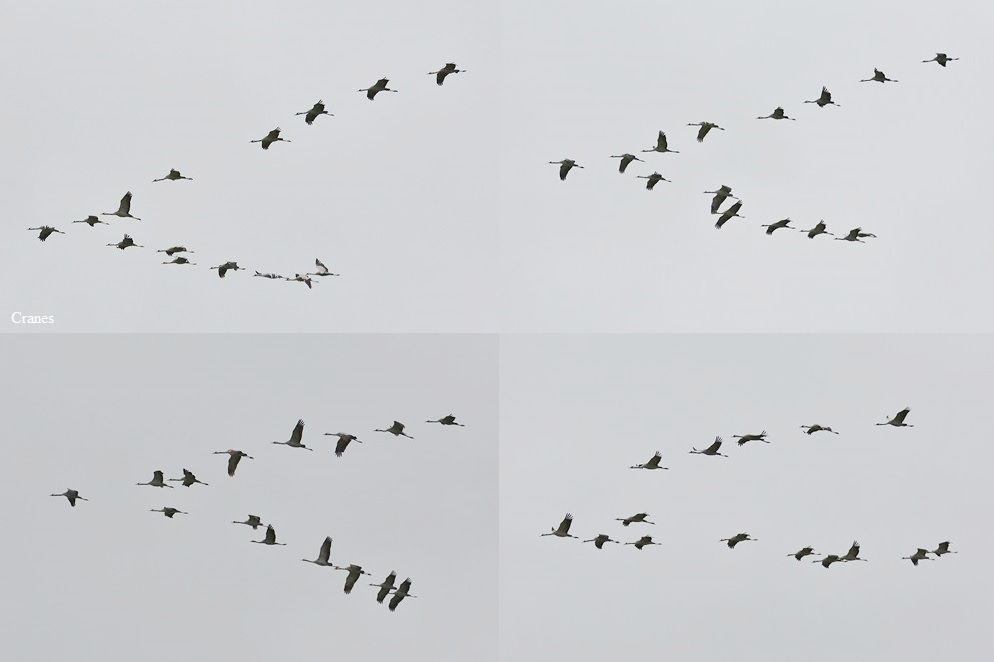
Cley and other coastal venues......
2 Red Kites were over the fields at Beach Road, Salthouse (24th) as Jason and I began our shortened day out.
From the middle-middle hide at Cley we saw a substantial flock of Golden Plovers, which occasionally flew up, but for no noticeable reason. Lapwings were here too, along with a single of both Ruff and Black-tailed Godwit and several species of Duck. Also here were both Migrant Hawker and several Common Darters.
Deciding to go back along the coast road, at Horsey we encountered a Great White Egret in the distance, 40+ Pink-footed Geese, Common Buzzard and a Chinese Water Deer.

Back from Luangwa and a Hat-trick of Egrets......
After spending the first 12 days of October in South Luangwa, Zambia, it was back to relative normality and Jason Nichols and I travelled along the Norfolk coast (17th).
First stop was along Beach Road, Salthouse, where whilst I was away a juvenile Bluethroat was seen by the bridge, a point at which we always stop! A Stonechat was perched on the fence, a Song Thrush was the other side of a nearby gate, a Reed Bunting was present and there seemed to be more House Sparrows here than normal.
On the way through Salthouse Cattle Egrets were seen with cattle. There was nowhere to safely park so a few drive-by photos were taken of the Cattle Egrets (at least 10) with the cattle.
There was not much to mention along Beach Road, Cley, but a few birds of interest were on the sea off coastguards. 4 Velvet and a similar number of Common Scoters were on the sea along with an Auk sp. probably a Razorbill and 8 Teal flew past, followed by 2 Brent Geese.
On to Morston, where there were a few Redshanks, a couple of Oystercatchers and 2 Little Egrets and Brent Geese were on the saltmarsh.
A Great White Egret was seen from the ‘gate’ at Holkham, giving us a hat-trick of egrets!
A spot of lunch at Wells Pools found a Red Kite and a couple of Common Buzzards, before carrying on to Brancaster Staithe, but our progress here was thwarted by ‘boat-moving’ in the car park so we headed for Thornham.
Whilst Jase perused through my phone videos from Zambia, I spotted a Rock Pipit perched on a post stump and the same or another later on at a different place near the channel. Two Great White Egrets, several Curlews, small flocks of Starlings and a charm of Linnets were also seen.
A drive around Choosley Barns followed with Kestrel, Common Buzzard, Red Kite and a Song Thrush and a couple of Yellowhammers were of note.
A stop in the lay-by along the A149 at Burnham Overy marshes found at least 16 Barnacle Geese and another stop overlooking Holkham Freshmarsh found a flock of Pink-footed Geese but there was no sign of the two Snow Goose reported the previous day.
On the way back, through Salthouse we found the Cattle Egrets still present with the cattle. A quick count again as we drove past found 10 birds present once again.
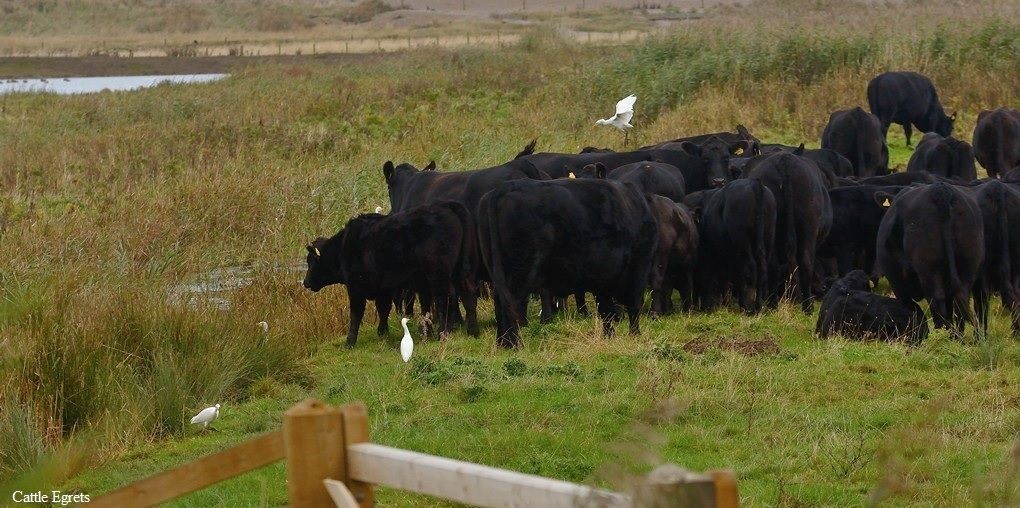

September 2024
Local Wildlife......
A shorter day out (26th) with Jason Nichols having work commitments but a drive around the local area still found some interesting wildlife.
The area between Clippesby and Ashby found 7 Common Buzzards in the air together over some woodland and another was seen down on a field at Sea Palling.
Several Turnstones were at Walcott looking for food along the sea wall and some unidentified Divers and Auks were also seen at distance.

At Waxham, some Pink-footed Geese could be seen on a field from near the church, but could not be seen from the main road.
Just south of Horsey Mill, I caught sight of a large white bird along a dyke. Turning around and parking off the road nearby, as expected the bird was a Great White Egret, hunting for prey along the dyke. From the ‘lay-by’ a little further on we saw 1-2 Great White Egrets, Little Egret, Kestrel and a Chinese Water Deer.
A Kestrel hovering a short distance from the car along Cess Road, Martham gave some good photo opportunities to Jase and arriving back home a Green Woodpecker flew up from the grassed areas.

A Cattle Egret day......
Starting off at Beach Road, Salthouse (19th), Jason Nichols and I began our usual journey along the North Norfolk Coast, but the only bird of any note here was a Swallow flying across the road!
Leaving Beach Road we headed towards Cley and on the way I spotted some ‘white’ birds amongst the black cattle. We stopped nearby and found as expected there were 2 Cattle Egrets and a Little Egret was also seen there.
Not too much to write about along Cleys'' Beach Road, or at coastguards and only a Little Egret was of note at Morston.
Geese were abundant at Wells Pools with at least 600 more Pink-footed Geese arriving. 2 Common Buzzard, Red Kite and Marsh Harrier were also seen here.
At Brancaster Staithe birds were also in short supply, but 3 Black-tailed Godwit. 2 Curlew, Oystercatcher, Redshank, several Little Egrets and the first 4 Brent Geese of the autumn were seen.
2 Spoonbill were at Thornham and a drive around Choosley found 2 Common Buzzard, Red Kite, Marsh Harrier, Yellowhammer, many Red-legged Partridges (probably raised to be shot at!), 30+ Canada Geese on a stubble field and Small Whites and Red Admirals flying along the road verges.
On the way back along the coast, I once again saw ‘white birds’ amongst the cattle at Holkham Freshmarsh. We managed to find somewhere to view the area from and found in excess of 25 Cattle Egrets with the cattle, along with a Little Egret and a juvenile Marsh Harrier on the ground.

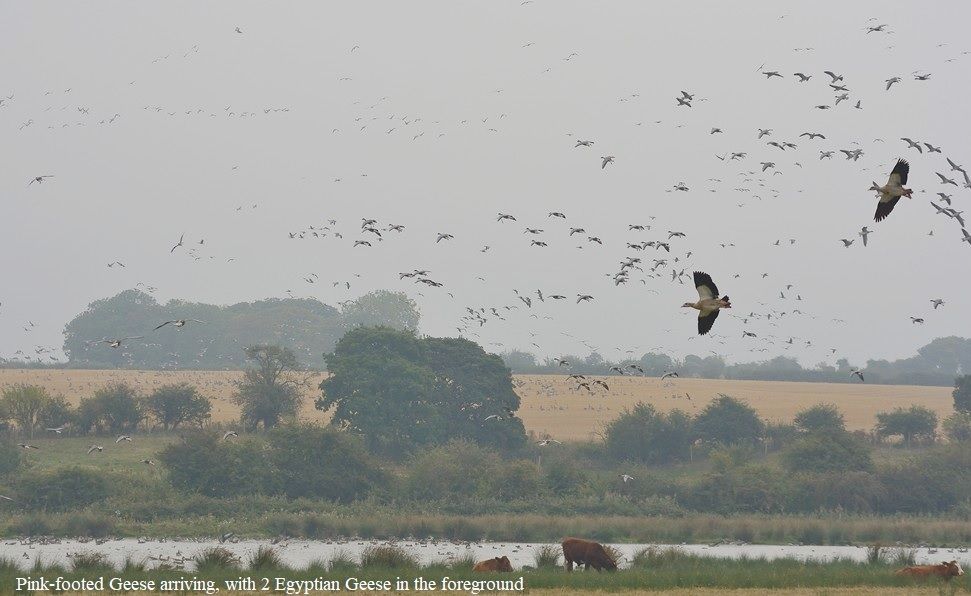
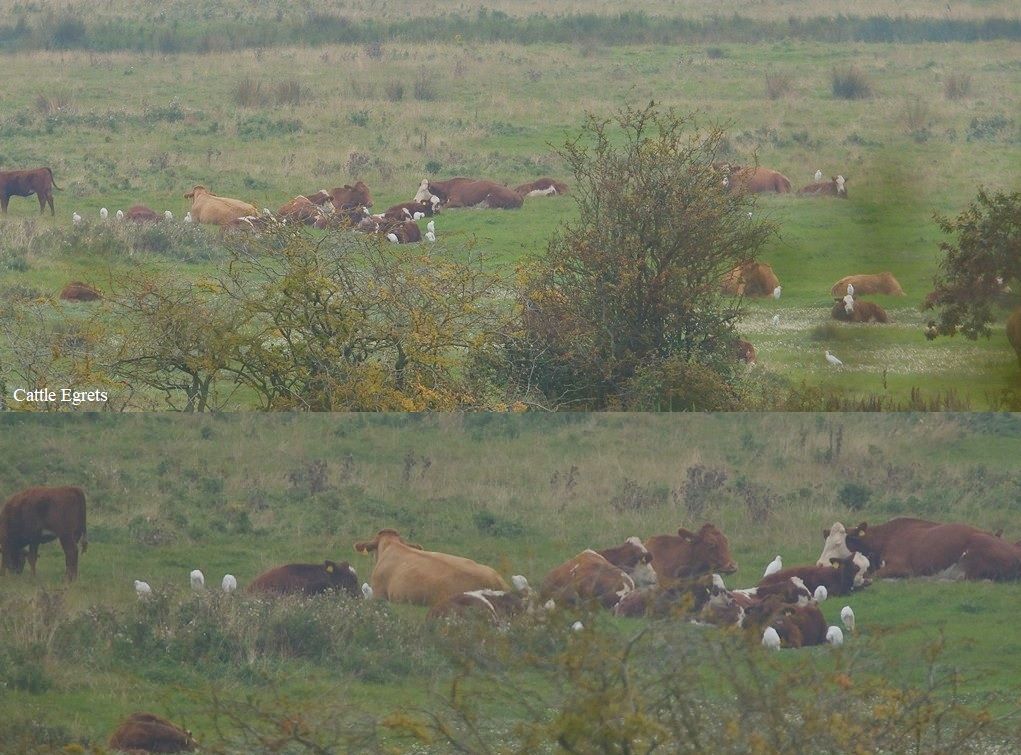
First Ivy Bees at Wells......
Two Cormorants fishing along the river, crossing Beach Road, Cley were the highlights from Jason Nichols and my first port of call today (12th).
With Morston overrun with people and a high tide we moved on to Wells Pools, where a walk along the hedgerow there found our first Colletes hederae Ivy Bees. Also here were Red Admirals and 2 Noon Flies Mesembrina meridiana.
The first record of the autumn of Pink footed Geese were heard but not seen and so was a Golden Plover.
There were very few birds at Brancaster Harbour with the tide still high, but several Turnstones, Black-tailed Godwit and a Little Egret were seen.
At least 15 Spoonbills were once again out on the saltmarsh at Thornham and a Little Egret was also present.
Choosley Barns was our next port of call and a little way up the road opposite a barn we stopped to look at a bird perched on the telegraph wires. Jason always stops for anything on the wires here and in this instance it was a good thing.
The bird in dull hazy light was obviously a Dove and Jase remarked about the pale ‘bars’ on its upperparts. I suggested it was probably a juvenile Collared Dove with pale feather edges but when it flew down from the wire, just by ‘giss’ alone, it clearly wasn’t and once on the concrete in front of the barn it was confirmed as a juvenile Turtle Dove. After several photos we continued on our way, but very pleased with our find; a far from common bird now.
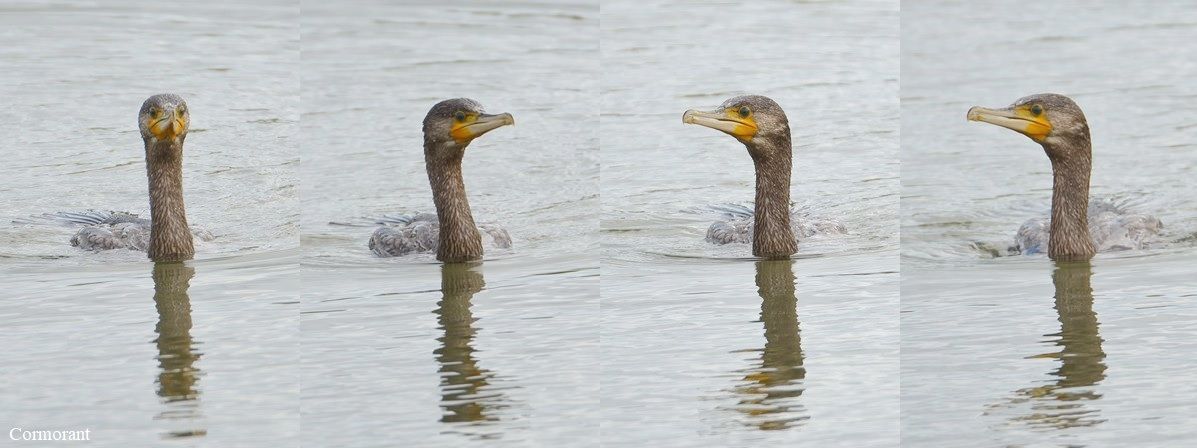
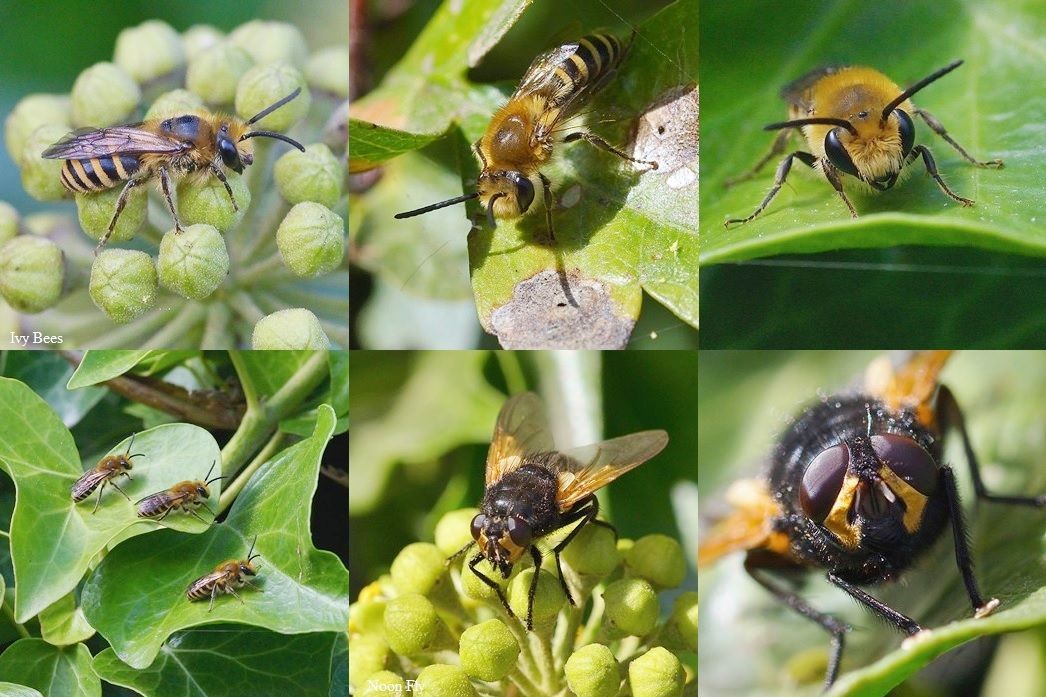

Duck crossing and a few 'white birds in North Norfolk......
The day (5th) began in Martham as it usually does! However, on this occasion Jason’s and my first task was to make sure a Mallard duck and her ducklings got safely across the road to the pond and green.
The Mallard family were first seen as they crossed the island in front of the takeaways, but I knew they were not going to stop there and indeed they didn’t and began to cross the road with cars approaching at speed. Jase and myself flagged down the traffic and waited until the duck family were safely (for now!) across the road.
The road through Martham is now extremely busy, far, far more than it ever was when I went to school here, many years ago and fatalities of ducks, not surprisingly happens with reports of cars deliberately trying to run them down and tales of ducklings being abducted and Mallard killed and stored in freezers. Whilst none of these ‘deeds’ I have actually witnessed; what I have seen is people feeding them bread and their leftovers, treating the ducks as wildlife garbage recyclers with even the local kebab shop being cited as using the ducks for that purpose, by a local councillor.
Talking of the local council; I was asked, when I made enquiries about the Mallard to write a ‘rejuvenation plan’ for the area of water, which is called a pond and usually gets blue-green algae, but despite sending this plan to them, I was then completely ignored by Martham Parish Council! As most people in the village have told me; ‘they are as much use as a chocolate fire-guard’ and their deeds, or lack of them leads me to believe no different
Despite the ducks being here for decades, probably before I was alive there are no village signs to warn traffic about the ducks presence, when nearly every other village pond has signs!
So why bother; they are only ducks and people have always fed them with bread etc. However, there is evidence that bread affects bone growth and stale bread can be contaminated and give birds Avian Botulism.
This is also not a natural population; in that Mallard are congregating here because of the additional food supply. Some more scientific people can relate this situation to Optimal Foraging Theory (where food is selected on the basis of ease of attainment and calorific value); E/H values (energy divided by handling time).
Basically, people are the reason there are so many Mallard around the pond/s (another pond exists opposite Martham Fish and Chip shop) feeding the ducks with bread allowing a far higher population to exist where without this ‘helping-hand’ from the public they would not be there in such numbers. This is in no way shape or form is helping the ducks, which are a sentient being, after all said and done. It is not their fault they mass around Martham village green, but the fault of Homo sapiens!
If you have anything you would like to add to this please contact me.
So, with nothing of note at Beach Road, Salthouse we went to Cley Coastguards where at least 10 Gannets were seen and 4+ Sandwich Terns.
A Little Egret was the only bird of note at Morston Quay, so we moved on to Wells Pools where we found 5 Spoonbill and 2 Little Egret.
Lunch at Brancaster Staithe produced; 4 Curlew, Grey Plover (still in summer plumage), Ringed Plovers, Oystercatcher, 3 Turnstone, Redshank and a Little Egret.
A visit to Thornham followed and we found at least 6 Spoonbill out on the saltmarsh and 2 Little Egrets.
A drive around Choosley didn’t find too much, but a Muntjac crossing the road and a 35+ Linnet charm were of note. A Great White Egret was seen amongst the Belted Cattle at Holkham Freshmarsh with another with ‘brown cattle’ from Lady Ann’s Drive, where 2 Red Kite were also present.

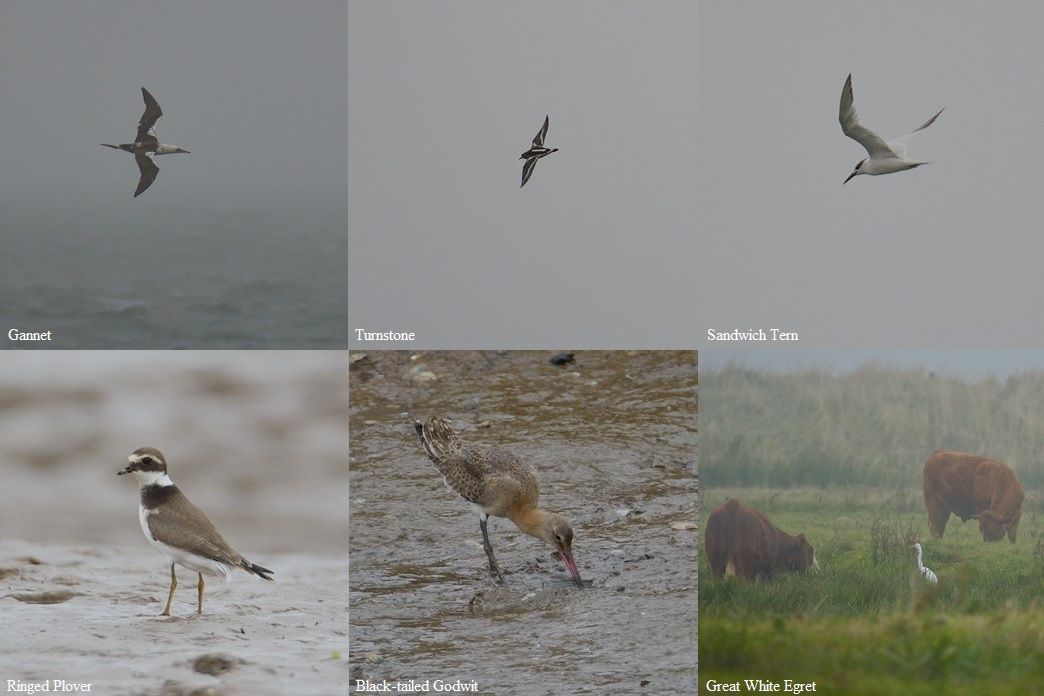
August 2024
Egrets and Spoonbills and Swallows on a boat!
Jason Nichols and my day (29th) began at Beach Road, Salthouse where a sub-adult Gannet just offshore was the highlight.
A Red Kite was seen along Beach Road, Cley before heading for Morston where Swallows had collected on the boats, with both adults and juveniles present. A Spoonbill flew over followed by 4 more and a Greenshank was in the channel.
A good number of Red Admirals were around the Ivy along the track to Wells Pools and 4 Spoonbills were present on the edge of the east pool and Golden Plovers were heard flying over at the same time a flock of Lapwings and Starlings arrived. Jason then noticed a Cattle Egret amidst the bullocks on the field, which finally came out into full view before flying to the edge of the pool.


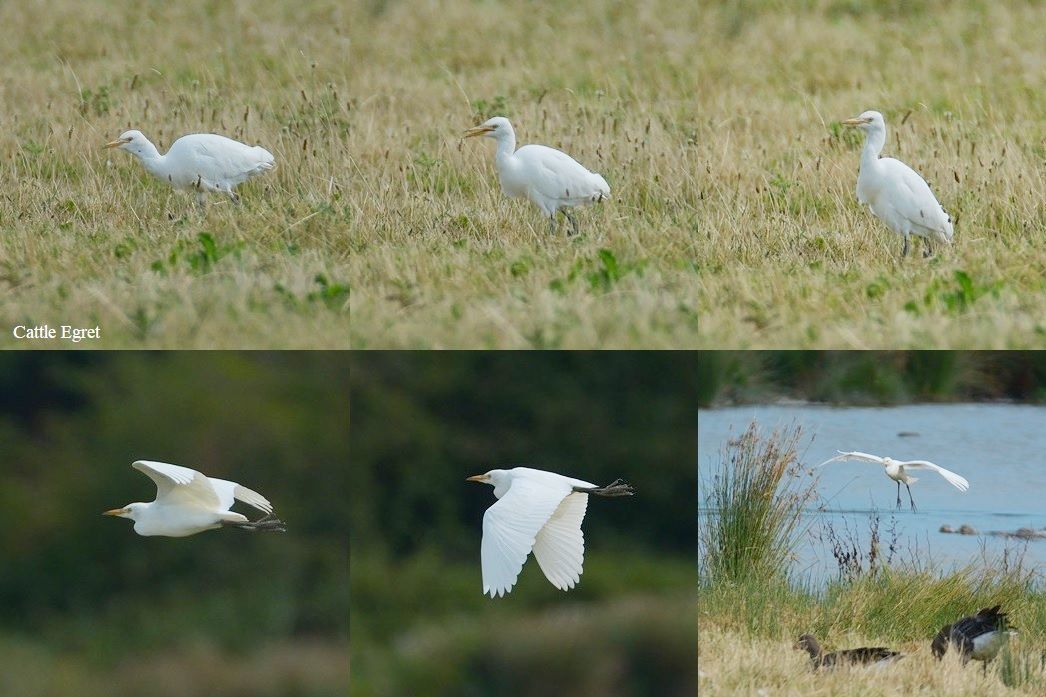
26 Ringed Plover were seen at our usual stop at Brancaster Staithe, along with 3 Turnstone, Black-tailed Godwit, 3 Redshank and 2 Little Egret. A Grey Seal swam along the channel, submerging periodically, which alarmed a Little Egret when it surfaced close to the egret!
5 Spoonbill were out on the saltmarsh at Thornham and the same number of Little Egrets was seen.
A drive around Choosley Barns didn’t find too much, but a Marsh Harrier and a Common Buzzard were of note.
On the way back along the coast, a stop at Holkham Freshmarsh found two groups of Cattle Egrets with two different breeds of cattle.

Cley all sorts and Beeston Yellow Loosestrife Bee......
Jason and I started the day (21st) at Cley. As we walked along the footpath to the middle hides, a Kingfisher flew over the reedbeds and abruptly turned in flight and landed in one of the dyke sides. Meanwhile on the path ahead of us was a Wall, which was duly photographed.
The first most westerly hide held very little to observe, with the scrape dried out and the other viewable scrape pretty well devoid of birds, apart from a juvenile Shelduck and then Jase found two Little Ringed Plovers.
We moved to the most easterly hide where Swallows had nested again and saw 9 Ruff, a couple of Avocet and 7 Plovers; 3Ringed Plover and 4 Little Ringed Plover. Most of the other birds present were viewed against the sun and best viewed from Bishop’s hide.
A dead Cormorant was in front of the hide and a couple of other avian corpses could be seen out on the scrape; more avian flu casualties? Then Jason spotted a juvenile Yellow Wagtail perched on some reeds just to the left of us, which was (or another) seen again at the edge of the scrape. Spotting a Ruff and Green Sandpiper in front of the middle hide, I moved there.
Once, seated I photographed both the Ruff and Green Sandpiper and later, a Common Sandpiper came into view. Two Hobby’s were over the scrape and then landed on the dry part of the scrape but behind some reeds, so were only viewable by standing up.
A Swallow was sitting on one of the nests in the hide and was obviously on another clutch of eggs or indeed offspring. A Great White Egret flew over the far reeds and waders came and went including a Common Snipe which landed at the muddy edge but then was went out of view behind the near bank. What appeared to be a White Wagtail was with several Pied Wagtails and a juvenile Marsh Harrier flew over the far reeds.
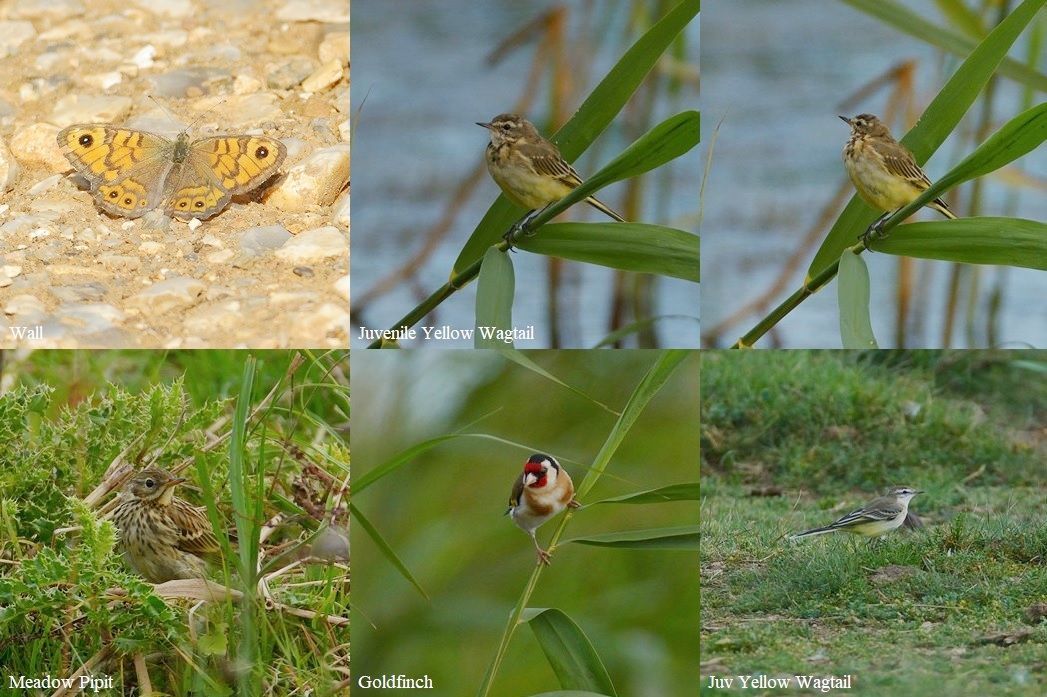

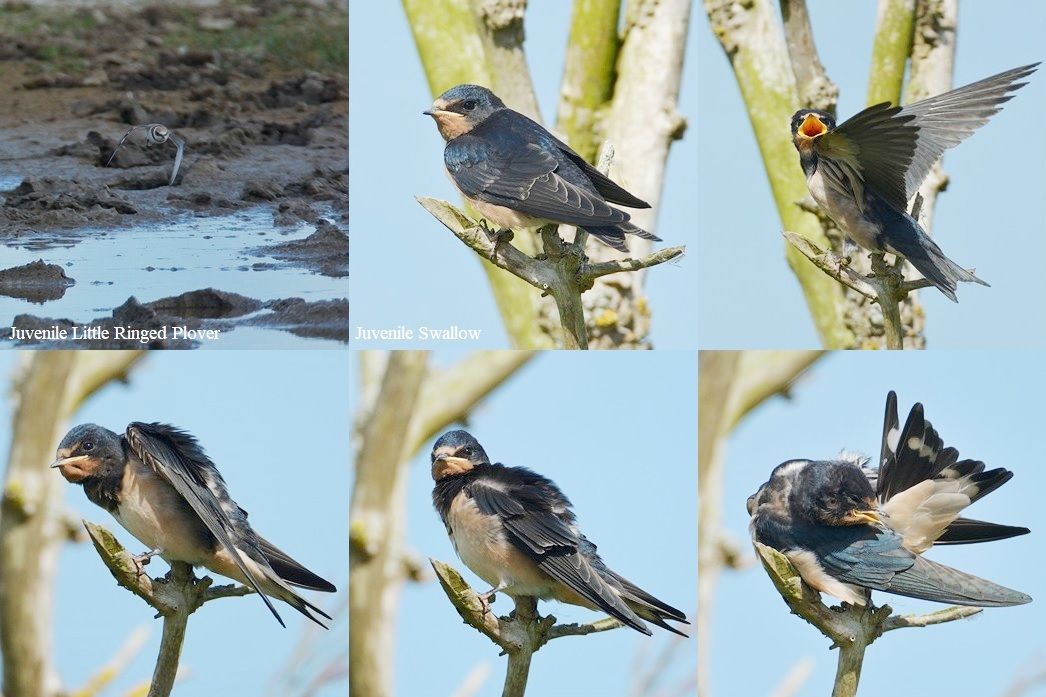
On the way back down the boardwalk we came across a small group of people watching and photographing three juvenile Swallows perched on a dead tree, so we did likewise, attempting to capture the feeding when an adult returned with food. A Common Lizard was on the edge of the boardwalk and a few images were taken.
We had lunch at Cley Coastguards, but bird-wise that was fairly uneventful so we left and headed back down the coast to Beeston.
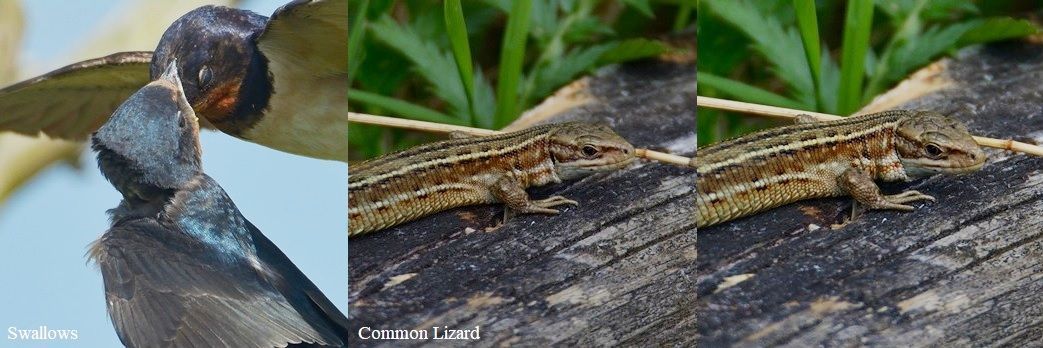
At Beeston Common we went in search of insects, but whilst there were plenty of Fleabane, Peppermint and other plants out in flower there was very little insect life.
A few Carder Bumblebees were around and then we came across our first of about 4 Bee-wolves. Despite looking through the grass we didn’t find any Crickets, which we had found in these areas before and looking amongst the Red Bartsia flowers we failed to find any Red Bartsia Bees Melitta tricincta. However, I did spot a Bee on the Yellow Loosestrife flowers and was a female Macropis europaea Yellow Loosestrife Bee with its hind tibiae covered in pollen.
Turning along the path back towards the car we started to find some Crickets at last with Jase finding a Speckled Bush Cricket along with at least four Roesel’s Bush Crickets and Long-winged and Short-winged Coneheads.
Several Dock Bugs were seen but only two butterflies, both Meadow Browns and a single Migrant Hawker near the car.
A good and enjoyable day out, but animals are getting harder and harder to find and I don’t just mean the rarer creatures!
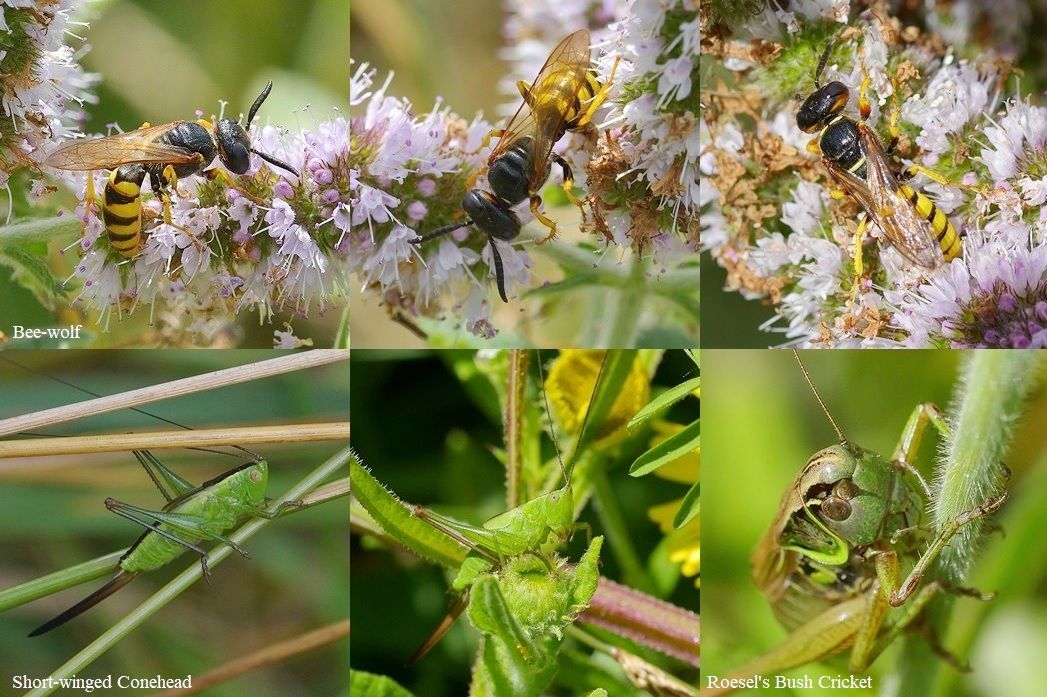

Waders and a missed Mustelid with prey photo!
With nothing of note from Beach Road, Salthouse (15th) Jason and I decided to have a look from Bishop’s hide on the Cley reserve.
Following the path towards the hide, we came across a gentleman looking at something on the ground and at which point I saw a small rodent run across the path. However, this was not what the man was looking at, it was a Common Toadlet (thought to be a Frog by the man), which Jason encouraged to safety at the edge of the reeds.
There were no Spoonbills or Egrets, from the hide, on this occasion, but there was a mixture of waders. The first wader I saw turned out to be a Wood Sandpiper and another of this species was to the right of the hide, where there were also 3 Green Sandpipers. 2 Common Sandpipers were seen to the left of the scrape.
Other waders seen here were: 4 Ringed Plover, 4 Black-tailed Godwit, 3 Avocet, 2 Common Snipe, 4 Ruff, several Lapwings and approximately 10 Dunlin. At least 3 Marsh Harriers quartered the reeds on the far side of the scrape and several Swallows were perching on one of the middle hides.
We headed back along the path towards the car park seeing several Ruddy Darters and a couple of Brown Hawkers, but then something was coming along the path towards us! As it turned out both Jase and me were bemused to what it was and none of us managed to get any photographs of what turned out to be either a Weasel or a Stoat carrying a small rodent in its mouth!
A drive along Beach Road, to Cley coastguards turned out to be pretty non eventful, but we had lunch there.
A walk down the ‘Iron Road’ at Salthouse found a lone Golden Plover on ‘Swan Lake’ a faded Gatekeeper and several Ruddy Darters.


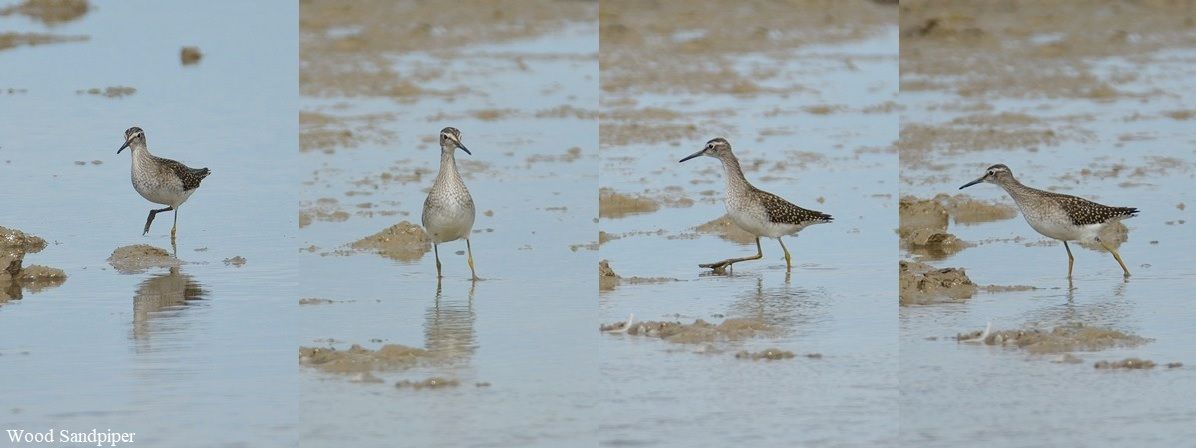

Bees and Wasps at Weybourne and Cattle Egrets and Sandpipers at Cley......
Jason Nichols and I began our day out (1st) at Weybourne Cliffs and although a bit breezy for finding and photographing insects we managed to find a few nevertheless.
A male and 3 female Dasypoda hirtipes Pantaloon Bee were found as were several Andrena thoracica Cliff Mining Bee, female Megachile leachella Silvery Leafcutter Bee, Epeolus variegatus Black-thighed Epeolus and several Philanthus triangulum aka Bee-wolves. A Sarcophagid Fly Miltogramma germari was also present; the cleptoparasite of the Pantaloon Bee.
Whilst talking to a couple about ecological matters, Jason had found and photographed, what he thought was an Ant (opposite). But the way he described it and the blurred view without my glasses on his camera suggested something else to me!
Jason, through some research found the insect to be a Black-headed Velvet Ant Myrmosa atra. Despite its name it is a female wingless Wasp.


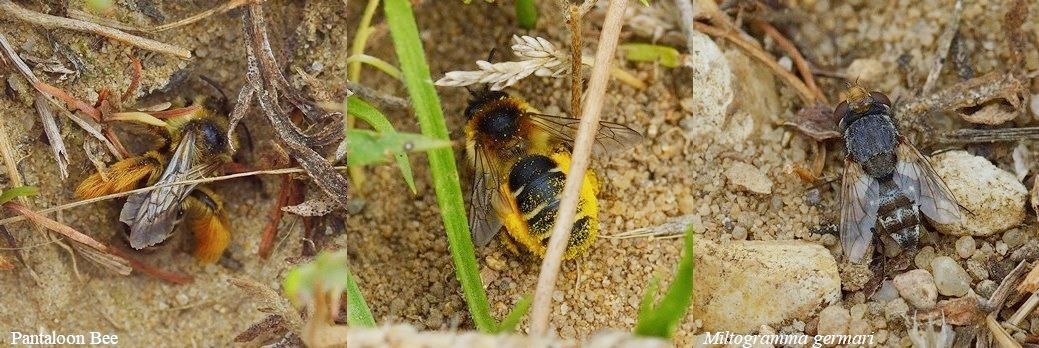
A visit to Bishop’s hides on Cley reserve found a variety of birds including 4 Spoonbill, 4 Little Egret and at least 16 Cattle Egrets.
3 Green Sandpipers were good to see with two of them coming reasonably close as did a Common Snipe when it wasn’t obscured by reeds. A Common Sandpiper, 2 Little Ringed Plover, 6 Dunlin, 2 Ruff, a Golden Plover with Lapwings and several Avocet were also present and 8 Black-tailed Godwits were seen in flight when the scrape was disturbed by a Marsh Harrier.
A Grey Heron with what looked like a small Eel, a juvenile Little Grebe was on the dyke in front of the hide, Bearded Reedlings were heard on several occasions and a juvenile Yellow Wagtail was a bonus, seen around the cattle with Pied Wagtails.
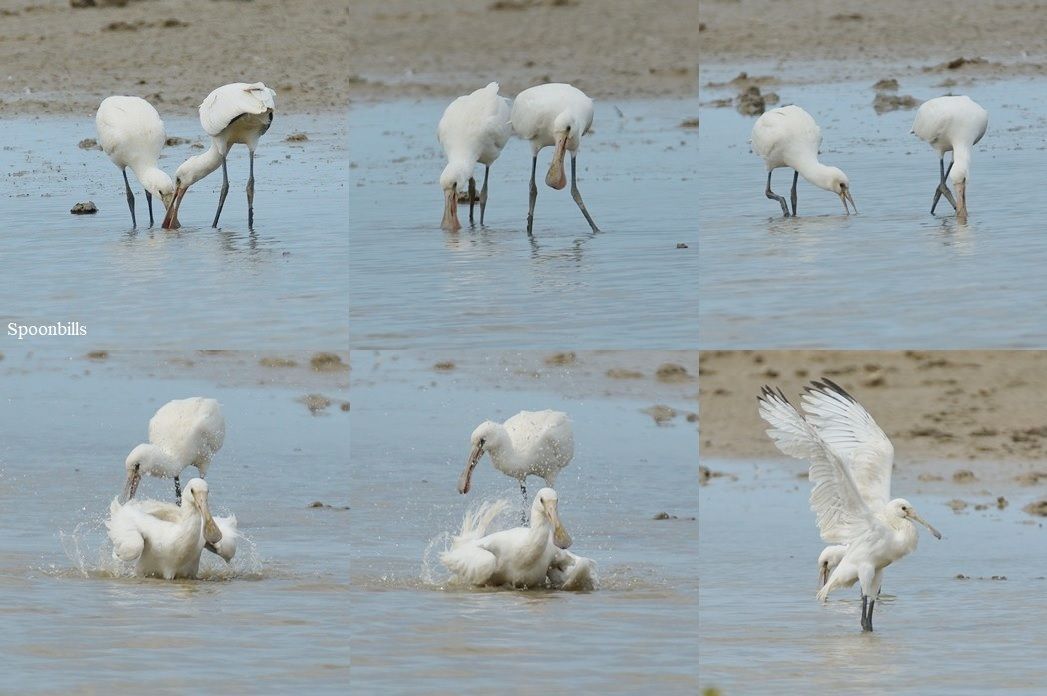
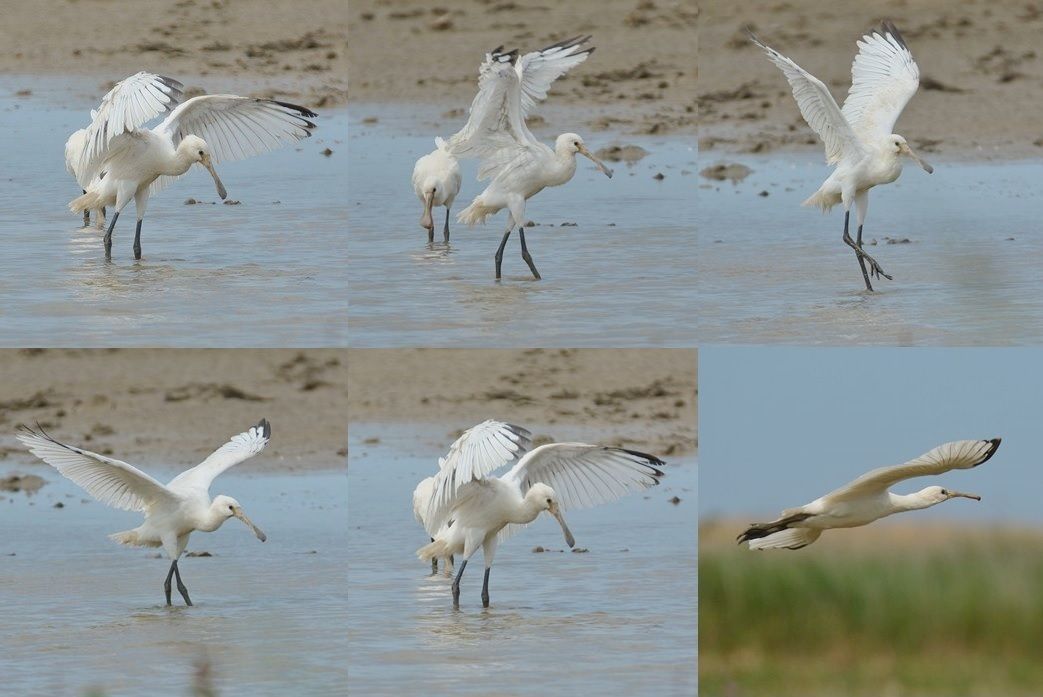

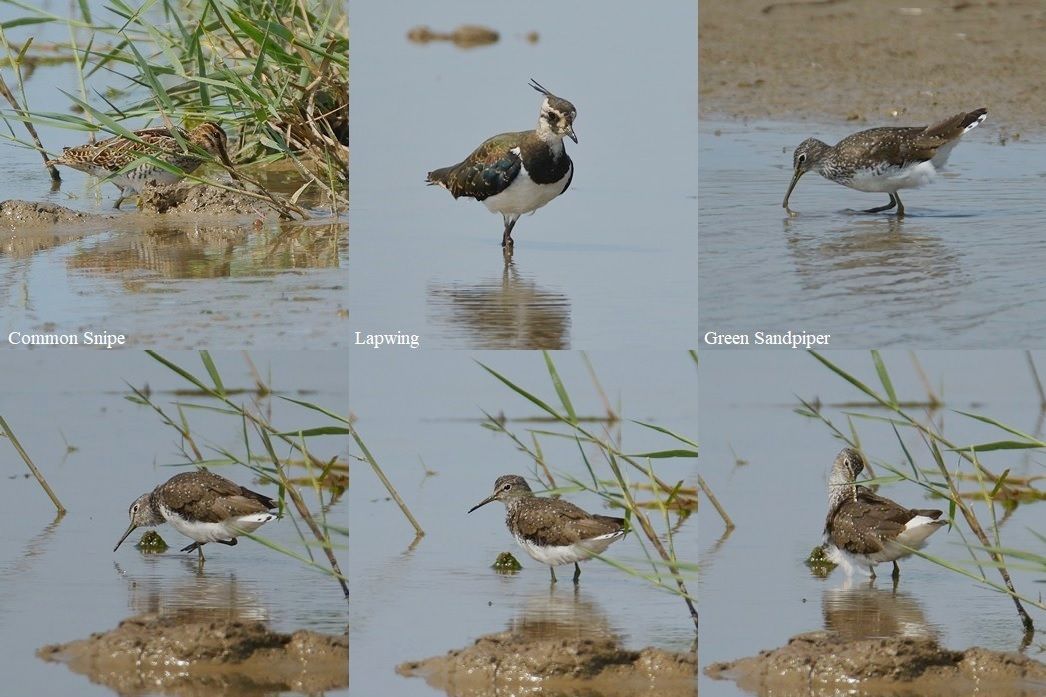


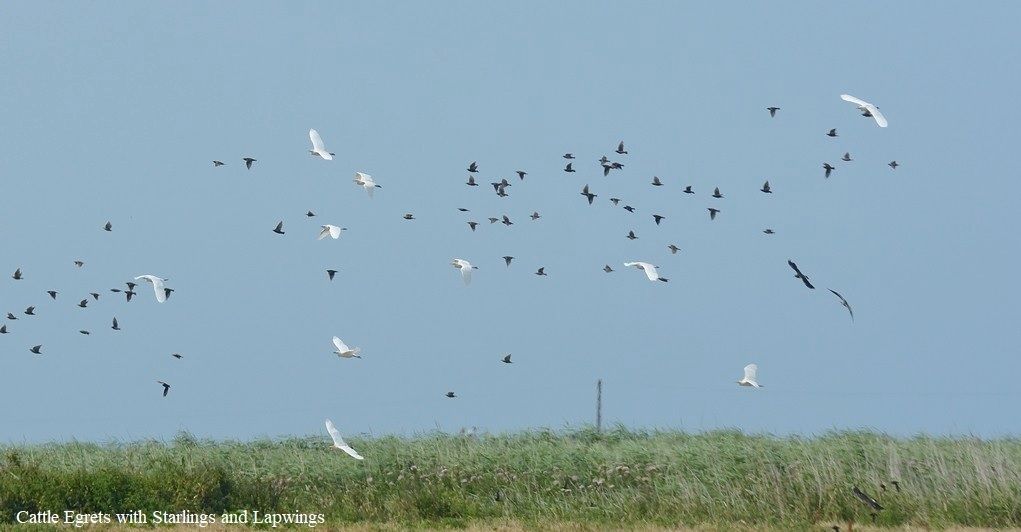
July 2024
White birds at Cley; 3 Egrets and Spoonbills......
We began at Beach Road, Salthouse (25th) where 2 Avocet, 2 Curlew, 3 Little Egret, Sandwich Tern and Reed Warbler were recorded.
On to Bishop’s hide on the Cley reserve where very noticeably were 4 Spoonbills having a sleep. A Little Egret was present and then 2 Great White Egrets flew in and stayed a while long enough for the third egret to fly in and land; a Cattle Egret still in good summer colours.
2 Little Ringed Plovers were seen followed by a Green Sandpiper, which was joined by another. A single Black-tailed Godwit, 2 Ruff, 19 Dunlin and good numbers of both Lapwing and Avocet were also present.
Several Sandwich Terns were seen from Cley Coastguards before continuing west.
However, after Morston was aborted due to high tide and many Homo sapiens we continued along the coast only to find our journey thwarted by yet again more road works at Stiffkey and not being able to divert at the junction (well done North Norfolk Council!) we decided to head back and visit the middle hides at Cley.
There was very little from the first two hides (apart from 2 Great White Egrets in the distance), but the eastern hide overlooking the same scrape (as from Bishops earlier in the day) produced an addition to earlier in the form of 2 Common Sandpipers. The Spoonbills were still there as was the Cattle Egret and the inhabitants of the scrape were disturbed on several occasions, once by a Peregrine seen by Jason.
A Common Lizard was seen on the edge of the boardwalk and a Hobby was seen on the walk back to the car park, which ended an interesting day mainly centred on Cley.
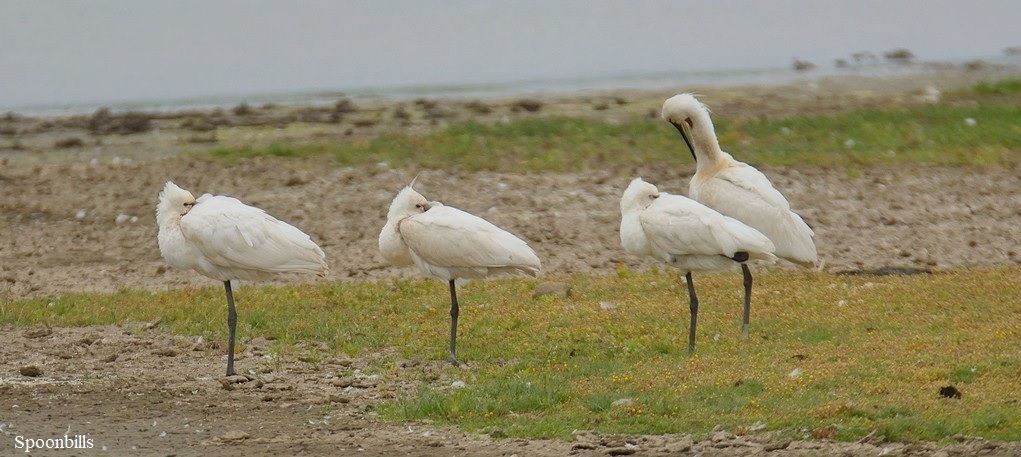
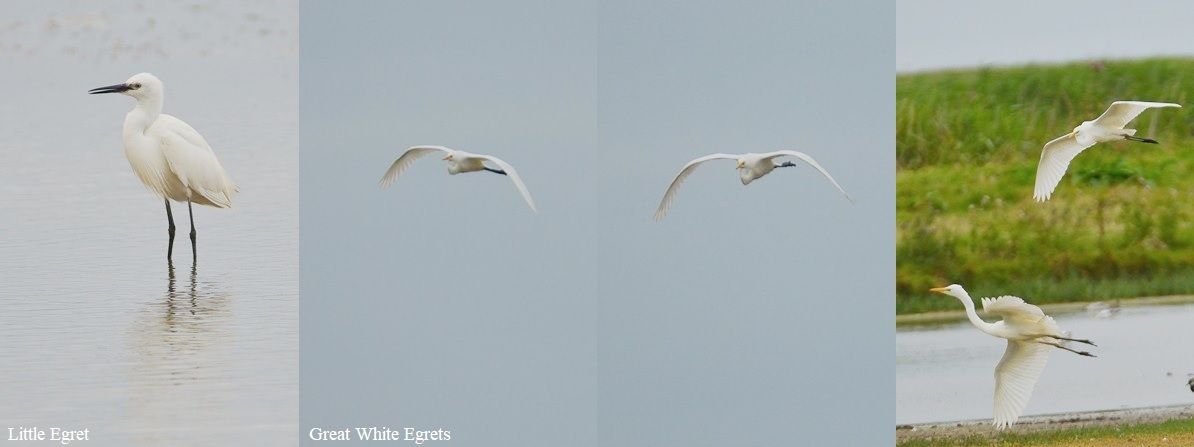

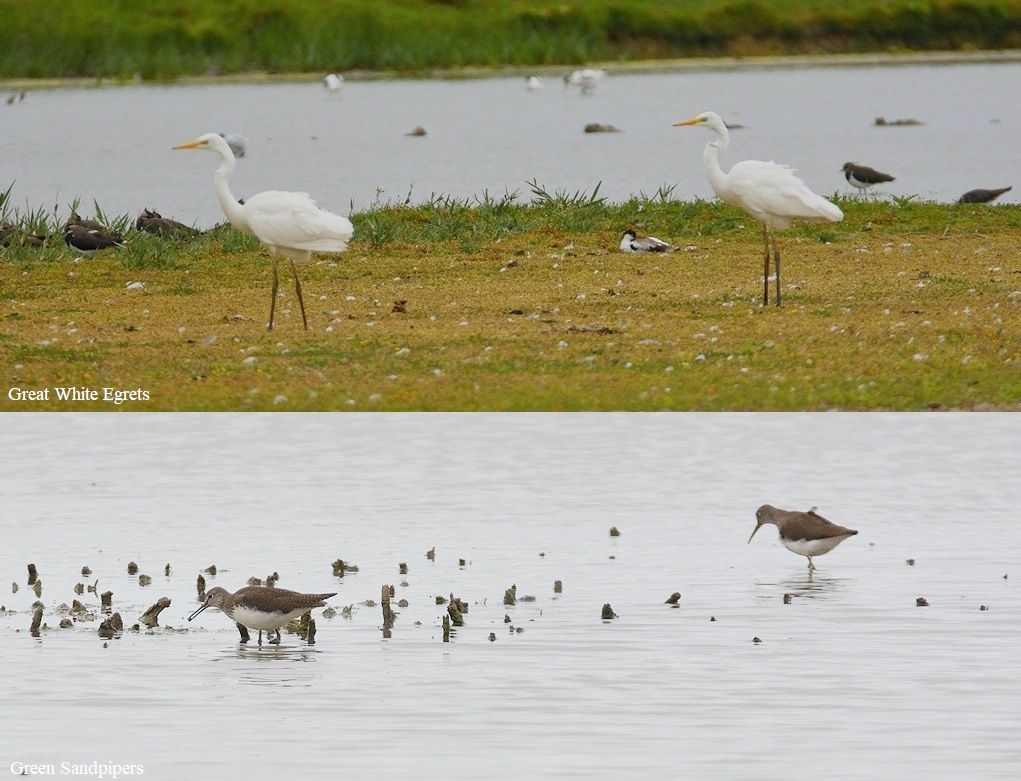
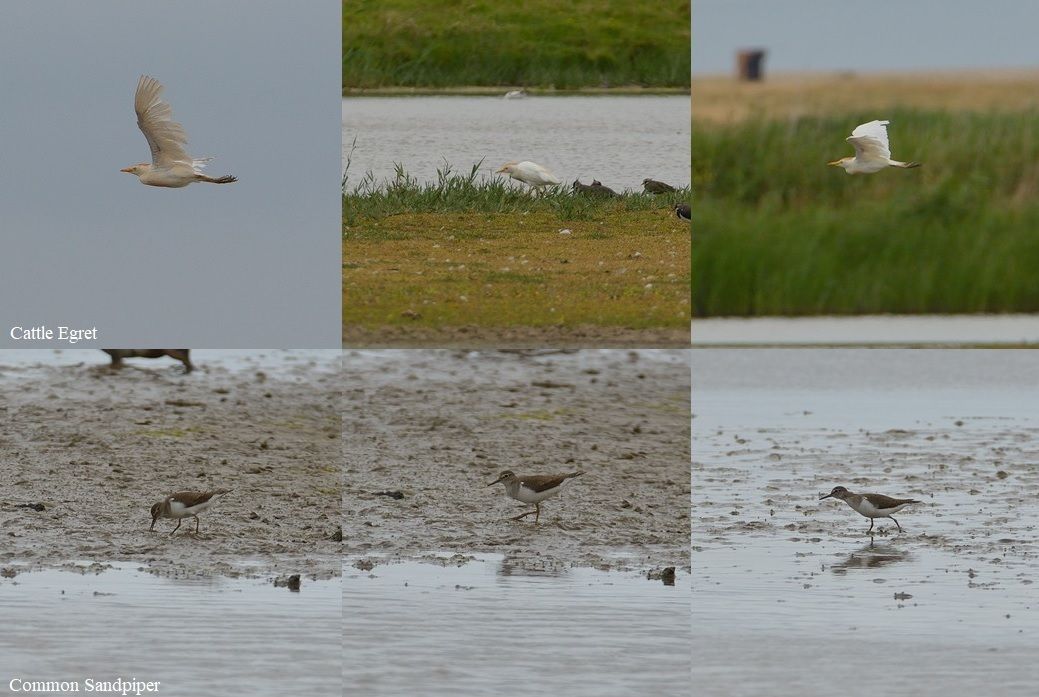

An Interesting Insect Day!
The first location of the day’s itinerary with Jason Nichols (18th) was at Beeston Common, where we looked for two specialist Bees; Yellow Loosestrife Bee and Red Bartsia Bee.
However, none were found although there was flowers on both plants, it was noticeable that other plants such as Fleabane were not in flower and maybe in this unpredictable year we were too early.
A few Butterflies were seen with Peacock, Small and Essex Skippers, Meadow Brown, Large and Small White and Ringlet recorded.
Other noteworthy animals were: Volucella bombylans and V. Pellucens, a male Emperor Dragonfly over the pond and a juvenile Green Woodpecker heard.
At Beach Road, Salthouse our first (unbelievably!?); Gannet was seen offshore and a Sandwich Tern also. A Reed Warbler was also heard singing.
Several Sandwich Terns were offshore at Cley Coastguards, a Little Egret and an Oystercatcher was the best at Morston and a Red Kite was of note at Wells Pools.
Heading slightly inland we visited Warham Fort and found several animals of interest at the beginning of the track, I found a female Andrena barbilabris Sandpit Mining Bee and a possible male of this species with damaged wings was also nearby. A probable female Sphecodes pellucidus Sandpit Blood Bee (a cleptoparasite of A. barbilabris) was also present either covering up a nest hole or trying to dig into it and nearby was a Solitary Wasp a female Lindenius albilabris.


The walk along the track to the fort was also productive, with a possible Summer Chafer Amphimallon solstiale, which flew across the path and then on my hat, but no one got a photo of it! Both female Andrena thoracica Cliff Mining Bee and female Andrena bicolor Gwynne’s Mining Bee was found and a Hylaeus Yellow-face Bee species on a Bramble flower.
A female Eristalis nemorum was found and a Volucella bombylans, a Hoverfly Bee-mimic was with a Longhorn Beetle Pseudovadonia livida Fairy-ring Longhorn Beetle and a female Black-tailed Skimmer were also found.
Evidence of Cynipid Wasps was found on the Dog Roses with Bedeguar Galls made by Diplolepis rosae and Smooth Pea Galls made by either Diplolepis eglanteriae or D. nervosa.
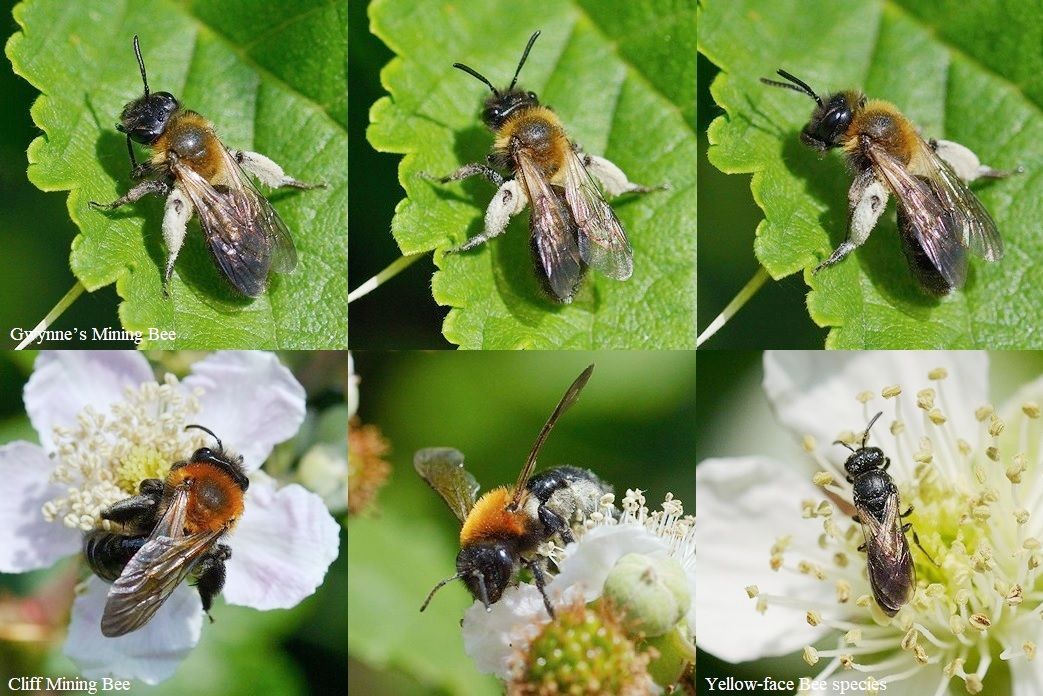

A female Tiphia femorata aka Beetle-killing Wasp was found on an Umbellifer in the meadow outside the fort and is said to particularly hunt Scarabaeidae (Scarab Beetles) especially Summer Chafer Amphimallon solstiale, which lends weight to the identity of the Chafer seen earlier. Also here was an Ichneumon Ichneumon sarcitorius (female) on an Umbellifer identified from ‘The Natural History Museum’s beginners guide to Ichneumons’ a very striking species!
There were no sign of any Chalkhill Blues, again maybe too early and only a handful of butterflies were seen: Essex and Small Skipper, Meadow Brown, Ringlet, Gatekeeper and Large White, but none in any significant numbers! A male Emperor was seen flying around the fort.
Many thanks to Dr. Nick Owens for his invaluable contribution to identifying the Bees and Wasps found at Warham.
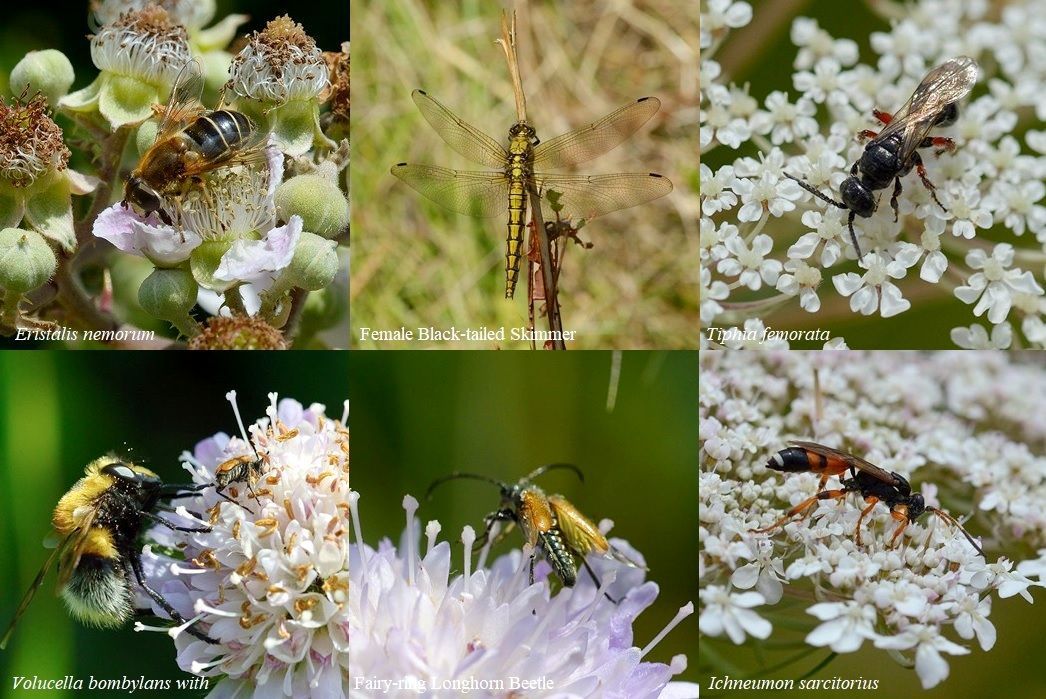
Dull day but a few birds of note......
The BBC Weather predicted sunny-ish weather (10th) but that was not the case; dull, overcast with light showers instead, typical Thursday weather!
However, Jason and I began our day out at Beach Road, Salthouse where the only animals of note were an Avocet and a Reed Bunting.
At Cley Coastguards we saw our first 2 Sandwich terns of the year (yes first ones!) and a Little and Common Tern.
We decided to drive straight to Thornham, as there had been a Spotted Redshank there (still not seen one of them for a long time!) and call in at our usual spots on the way back.
No Spotted Redshank but a Common Sandpiper flew up from some puddles and a flock of approximately 14 Spoonbills out on the edge of the Saltmarsh. A nicely plumaged Black-tailed Godwit was also present.

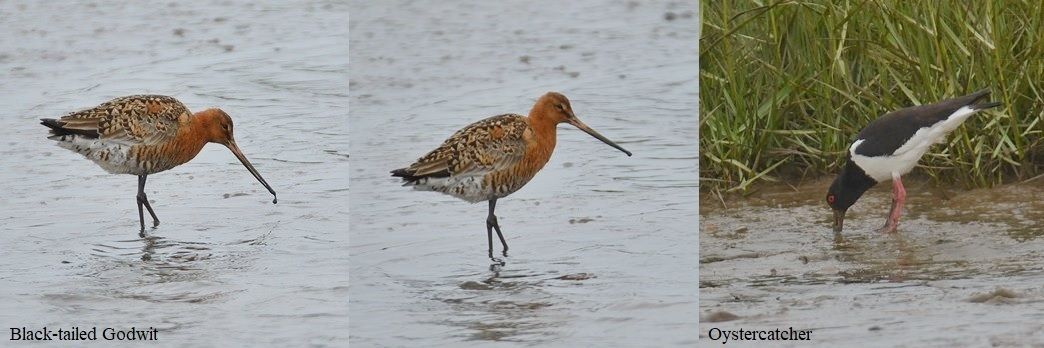

A drive around Choosley Barns was not very productive. However a Deer, probably a Chinese Water crossed the road and a male Yellowhammer was good to see.
A stop for lunch at Brancaster Harbour found 2 Common and a Sandwich Tern and a Greenshank. 8+ Oystercatcher, Ringed Plover, 2 Curlew, 3 Black-tailed Godwit and Redshank added to the small number and diversity of Waders present here.
From the ‘gate’ at Holkham Freshmarsh, 2 Spoonbill were seen flying west over the edge of the dunes and 2 Common Buzzards were initially perched in the trees, while at Wells Pools 2 Avocet were the highlight!

Life in the Undergrowth, Suffolk style......
Jason and I ventured into Suffolk (4th) and began the day at Dunwich Forest.
Eventually we found the ride, which I had been down on several occasions and where I had found White-letter Hairstreaks. No Hairstreaks today but a variety of other insects, in a year when insects are a scarce commodity!
A couple of Speckled Wood was seen before a Red Admiral was found at the start of the ride and then at least 6 White Admiral, 4 Comma, 5 Meadow Brown, 6 Speckled Wood, 3 Green-veined White, 3 Large White, a Silver-washed Fritillary and numerous Ringlets all the way down the ride, which was good to see, considering the paucity of butterflies this year.
A Brown Hawker and a Ruddy Darter were seen and several juvenile Speckled and Dark Bush Crickets and my first Stratiomys potamida Banded General (at least to the best of my knowledge).
Hoverflies included Volucella pellucens and V. Bombylans, Helophilus pendulus (aka the footballer) Myathropa florea (aka Batman Hoverfly), Sericomyia silentis (aka Bog Hoverfly) and a Xylota silvarum, a species only seen once before.
A Scorpion Fly probably Panorpa communis and 2 Dock Bugs Coreus marginatus and several Pentatoma rufipes Red-legged Shieldbug, which were probably final instars, a Sicus ferrugineus fly (waiting in ambush on a leaf for a Bee to come within range!) and a Rutpela maculata Black-and-yellow Longhorn Beetle were also seen.
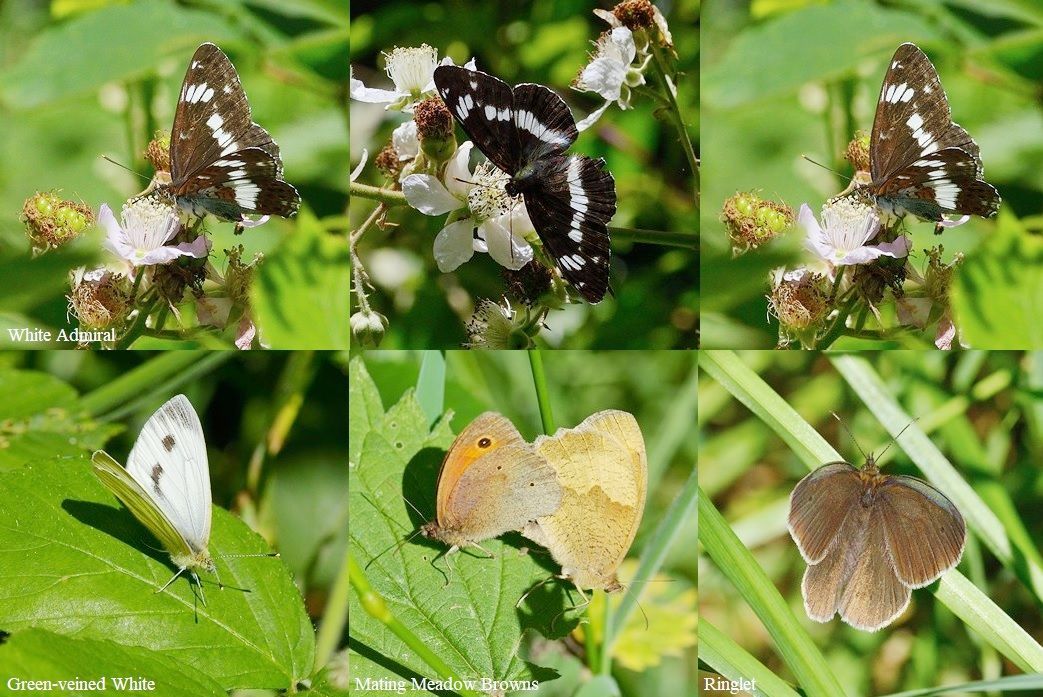
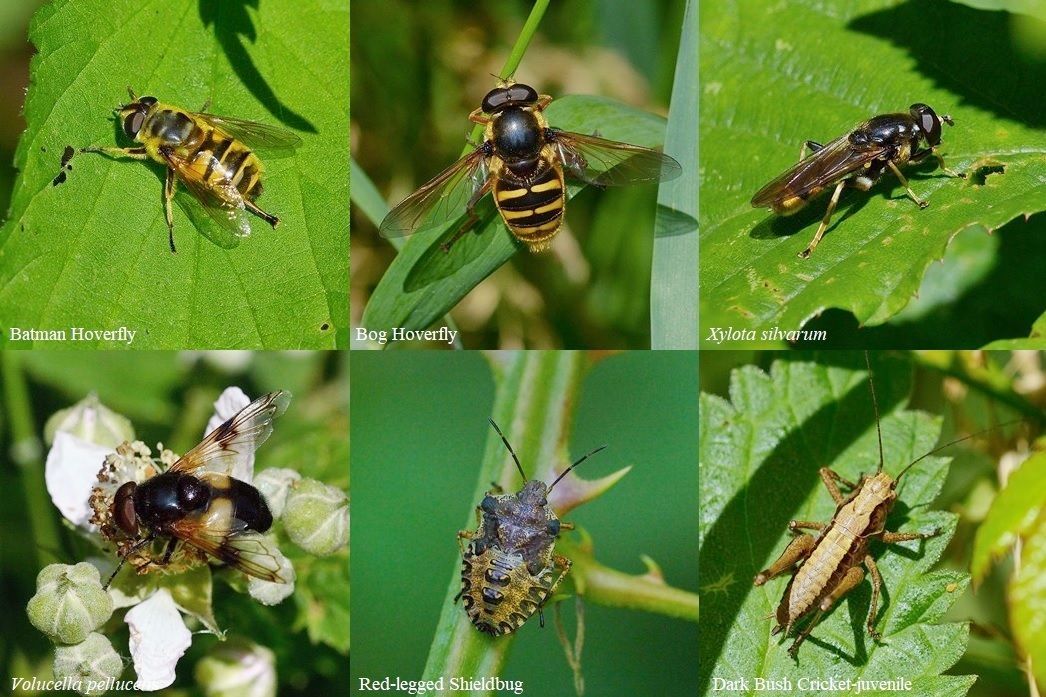

A visit to Westleton Heath followed, with for once the temperature beginning to rise and with bright sunshine, where we found at least 8 Silver-studded Blues, both males and females, 2 Small Heath, Comma and a Meadow Brown.
A Sand Wasp was found carrying a green moth larvae and judging by the wing cell details and a spur on the hind tibia looks to be an Ammophila sabulosa.
A small ‘swarm’ of Megachile leachella Silvery Leafcutter Bee were found going into nesting holes and a pair was photographed in a mating ‘tussle’.
Nearby to the Megachiles an insect was found resembling a parasitic fly I had seen before at Weybourne. However, Nick Owens informs me that: This was one of the Wasps, which predates flies, genus Oxybelus. ‘There are three British species and yours is Oxybelus argentatus (female), quite a scarce wasp. Your photos show that the mid femora are brown rather than black which is the case in Oxybelus uniglumis.’
The record of this scarce wasp has been sent to the Suffolk County Recorder, on the suggestion of Nick.



June 2024
A sunny day, but a lack of biodiversity......
Beach Road, Salthouse began Jason and my day out (27th) where a bit of a photo session with a Marsh Harrier took place and 2 Avocet, Meadow Pipit and a Reed Warbler were of note, as was my first Meadow Brown of the year.
New paragraph

A trip up Beach Road, Cley followed, but only 2 Oystercatcher were seen at the flash pool on the Eye Field and virtually nothing out at sea!
A look for Ravens in the Glaven Valley followed but we found none and only a Common Buzzard was of any note, along with the assembly of Rook, Carrion Crow and Jackdaw on the pig fields.
A look on the scrape at Bishop’s hide at Cley found a small variety of species including Avocets, Little Ringed Plover, 5 Redshank, Little Egret, Gadwall and a distant Great White Egret. A Sedge Warbler was photographed in the reeds along the path and several Red Admirals (6+) were seen as was a Ruddy Darter.
We called in at Potter Heigham Marshes on the way back and were encountered with good numbers of Norfolk Hawkers, several Black-tailed Skimmers and Four-spotted Chaser along the track. Marsh Harrier, Kestrel and a Hobby catching dragonflies over Sounds Plantation were good to see.

Ravens, but no Ospreys on a cryptic day out in Norfolk......
After last week’s absence of going out with Jason, due to illness, it was good to get out and about again (20th) on a very sunny and warm day (at last!).
We began at Potter Heigham Marshes where we saw and heard Reed Bunting, Reed, Cetti’s and Sedge Warblers and a Norfolk Hawker over the dyke. However, the highlight on the drive back along the track was a Cuckoo flying out from the trees lining the track.
Today was a bit of a ‘magical mystery tour’ based on some cryptic clues from internet scribbling for the whereabouts of two species of birds; Ravens and Ospreys!
With this in mind, we then headed for the Glaven Valley and began a search for pig farms! This was more difficult than first anticipated but finally we could see some. However, before reaching the pig fields a large Crow was seen perched in a roadside tree and we both agreed that this was a Raven; Jason suggesting a juvenile. Unfortunately it was not there for long and therefore no photo was obtained before it flew off over the hedge, but it was followed by an equally large crow, which was most probably another Raven but views of this were even shorter than the first one!
Viewing the pig fields complete with no entry signs reading biohazard area we were pretty sure we saw another Raven but it was distant and there was a very bad heat haze across the field. Plenty of other Corvids here with Jackdaws, Rooks and Carrion Crows and also seen were: 2 Red Kite, Common Buzzard, Marsh Harrier, Kestrel, a Skylark perched in a hedge and a Peacock butterfly the first seen for some considerable time!

A visit to Salhouse Broad was next in search of the next species; arising from the enigma scribbling. No Osprey nest or Ospreys here but Norfolk Hawker and Black-tailed Skimmer were welcome and some very nice Oak trees, fresh out of Fanghorn Forest!
Barton Broad followed but with nowhere to park we moved on to How Hill where a Norfolk Hawker was in the car park and 2 Common Buzzards were seen, whilst having a late lunch and concluding that the said scribbling must have meant Ranworth Broad, but the lack of any detail of any consequence, which began the travels was rather limited to say the least!
With Jason wanting to get back to see England play Serbia in the European Championship we made a last port of call along the Weaver’s Way at Hickling. The short walk along the path found a Swallowtail, which was not settling for photographs and several Four-spotted Chasers, so a worthwhile stop. Was the England match worth getting back for; I think definitely not!
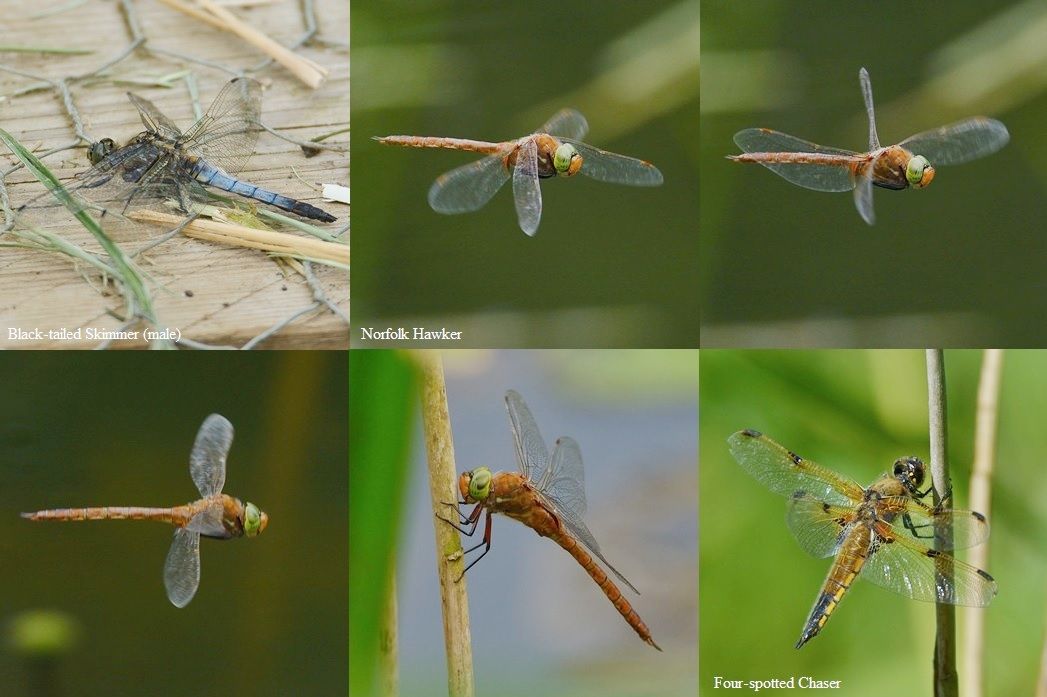
Tough-going but a hat-trick of Egrets and Great Crested Grebes at Ranworth......
Jason Nichols and my day (3rd) began (as normal) at Beach Road, Salthouse, where 4 Avocets were present as were 2 singing Reed Warblers and 4 Swift.
Cley Coastguards provided us with at least 10 Little Terns offshore and a Common Tern but very little else.
Morston Quay was also very thin on birds with only 2 Oystercatcher and 2 Redshank seen.
The first definite Large White was seen at Wells Pools and also here was a Marsh Harrier, 2 Red Kite and approximately 10 Avocet.
A stop for lunch at Brancaster Staithe saw a Great White Egret fly over and a Common Tern was over the channel briefly, but not a single wader.
A drive around Choosley Barn found a Brown Hare and a Chinese Water Deer and bird-wise 2 Marsh Harrier and a Common Whitethroat were of note.
A stop at the pull-in along the A 149 at Burnham Overy saw a Spoonbill fly over the dunes and a stop at ‘the gate’ at Holkham a Little Egret was the only thing of note.
However, at the next pull-in (Holkham) I spotted a Cattle Egret with cattle, giving us an Egret hat-trick and a Muntjac was near the hedge. Still at Holkham the pools east of Lady Ann’s Drive gave us our second Great White Egret of the day.
Deciding to head nearer home, we visited Ranworth Broad with the chance of seeing Ospreys, amongst other things.
Great Crested Grebes were nesting, with one nest seen with an adult still bringing in nest material. At least another 10 were seen as we also watched Common Terns over the broad and at the nest rafts. 2 Great Spotted Woodpeckers were seen, with one flying across to another one already in a tree. A Willow and Reed Warbler were also heard singing, but no sign of any Ospreys but 2 Common Buzzards were seen.




We walked back towards the car and at the end of the boardwalk spent a few minutes looking for birds in the edge of the wood. Here we found a Blackcap singing and 2 Song Thrushes were heard too as was another Great Spotted Woodpecker. A Chiffchaff was seen and also what looked like several juvenile Chiffchaff and a Long-tailed Tit.
Spotted Flycatchers used to breed in the Ivy-covered trees alongside the road, but no more with the trees having been felled long since for reasons unknown.

May 2024
Shrike, Terns and Insects......
A male Red-backed Shrike was seen at distance started the day (27th) out with Jason at Horsey.
6 Swift were over the sea at Cley and 9 Avocet were the highlight at Wells Pools.
Brancaster Staithe produced our first Terns of the year with 3 Common and 2 Little Terns feeding along the channel and 3 Little Egrets were also here, but not a single wader! Hopefully they are all away breeding, but the number of birds here in general depends on the human presence and their interactions with the area much of the time.

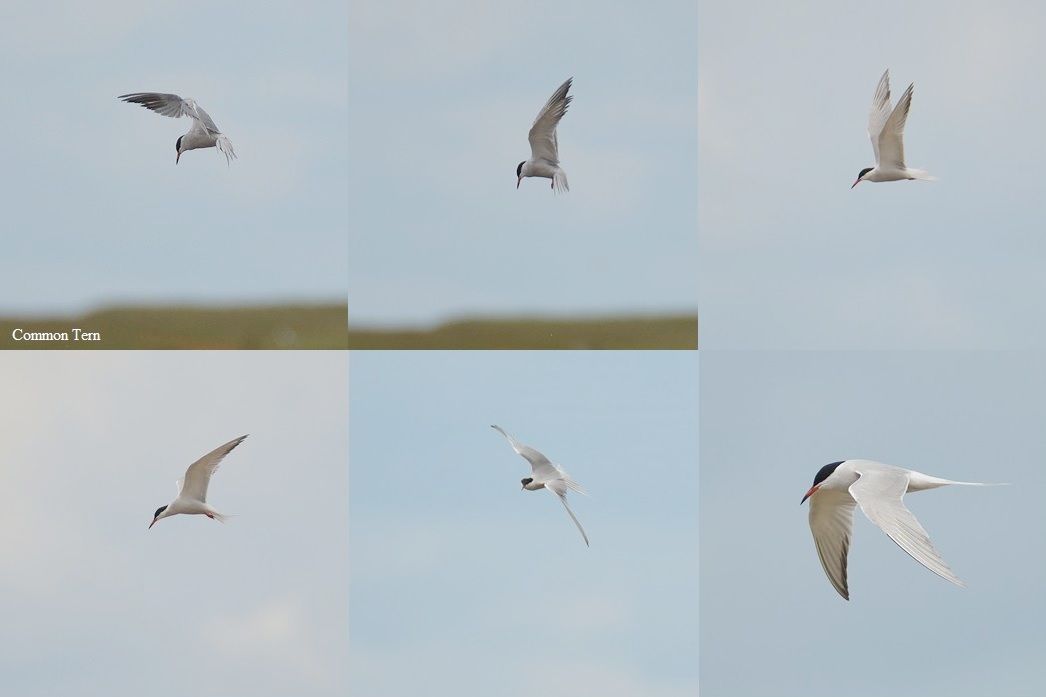

A drive around Choosley found 3 birds of prey within a few minutes: Marsh Harrier, Red Kite and Common Buzzard. Goldfinches and Linnets were bathing in a puddle at the barn and a Swallow was preening on the door ledge of the barn. A Corn Bunting was on a telegraph wire, a scarce bird in Norfolk now, so a good find.



We headed inland next to Alderford Common, which we had visited before but were rained-off.
Bullfinch, Blackcap and Chiffchaff were all heard, a Blue Tit was feeding a juvenile but again no Turtle Doves and a Muntjac was also seen.

The first real insect find was a female Osmia bicolor Red-tailed Mason Bee, a species that interestingly nests in empty Snail shells. A female Nomada flava was found next, followed by a Green Nettle Weevil Phyllobius pomaceus and a Red-headed Cardinal Beetle Pyrochroa serraticornis.
The first Bombus hypnorum of the year were found, along with Volucella pellucens Great Pied Hoverfly, a male Swollen-thighed Beetle Oedemera nobilis and an Azure Damselfly Coenagrion puella.
Alderford Common is an SSSI, so it was not good to find a motorcycle track in the middle of the wood!


First Dragons and Wall......
The day out with Jason Nichols (9th) began at Beach Road, Salthouse where a Reed Warbler was heard singing for the first time this year. At least 2 possibly 3 male Reed Buntings were seen, with two in song. 6 Swallows flew west, 3 Avocet were on the pools and a Spoonbill flew over westwards.
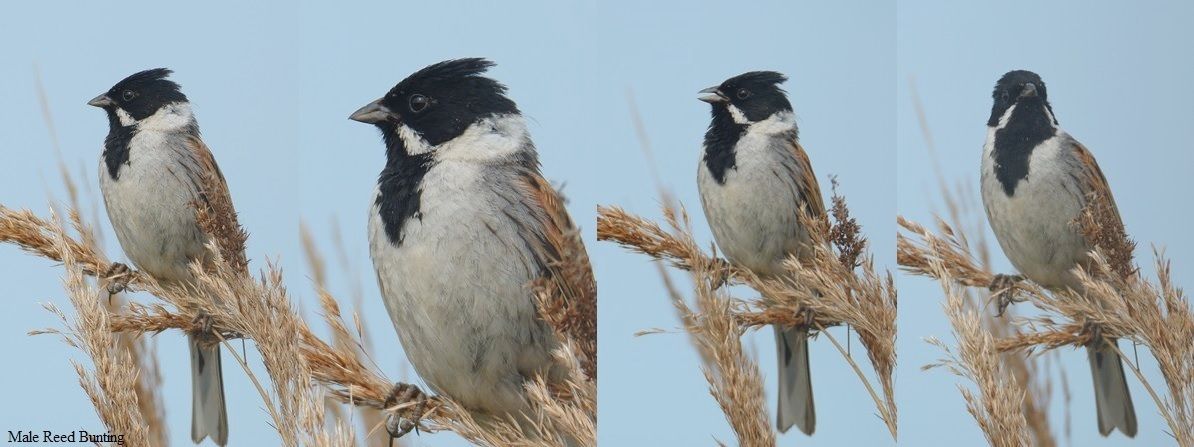
Whilst at Walsey Hills pond Jason saw a Common Whitethroat near the east bank car park but despite parking there it was not seen again but another Reed Warbler was heard singing.
The pool along Beach Road, Cley on the Eye field held 2 Avocet, pair of Gadwall and a summer-plumaged Golden Plover and driving through Blakeney 6 Swift were seen.
The flooded area at Stiffkey produced a Great White Egret, but attempts to get passing shots from this busy road turned out not worthy of inclusion. Another Common Whitethroat was heard singing nearby.
At Wells Pools 2 Red Kite were seen along with 10+ Avocet, 19 Black-tailed Godwit, Common Buzzard and a Lesser Whitethroat heard singing in the hedgerow at the entrance track. Male Brimstone was also seen here as were 2 Brown Hares.
A partial drive (road closed along Chalk Pit Lane) around at Choosley heard a Lesser Whitethroat singing and approximately 10 Common Whitethroats. A Chiffchaff perched up on the hedge for photographs and 2 Chinese Water Deer were seen.

A stop at Brancaster Staithe was fairly uneventful but a stop in the A149 pull-in at Burnham Overy saw a Spoonbill, Red Kite and Marsh Harrier in flight.
The ‘gate’ at Holkham saw Spoonbills at distance and a Common Whitethroat and Little Egret were noteworthy.
6 Swift were seen over Wells town and 10+ Brent Geese were at Morston, but very little else; the constant human presence and boat trips now making this site, now a place to avoid, for now!
Probably the best stop of the day was a walk along the ‘Iron Road’ at Salthouse. Here we found our first Dragonflies; several Blue-tailed Damselflies, a Hairy Dragonfly and a teneral Four-spotted Chaser.
6 Brown Hares were chasing each other across the fields and our first spring Wall was seen. Birds seen were: 5 Avocet, 2 Redshank and a Little Egret.
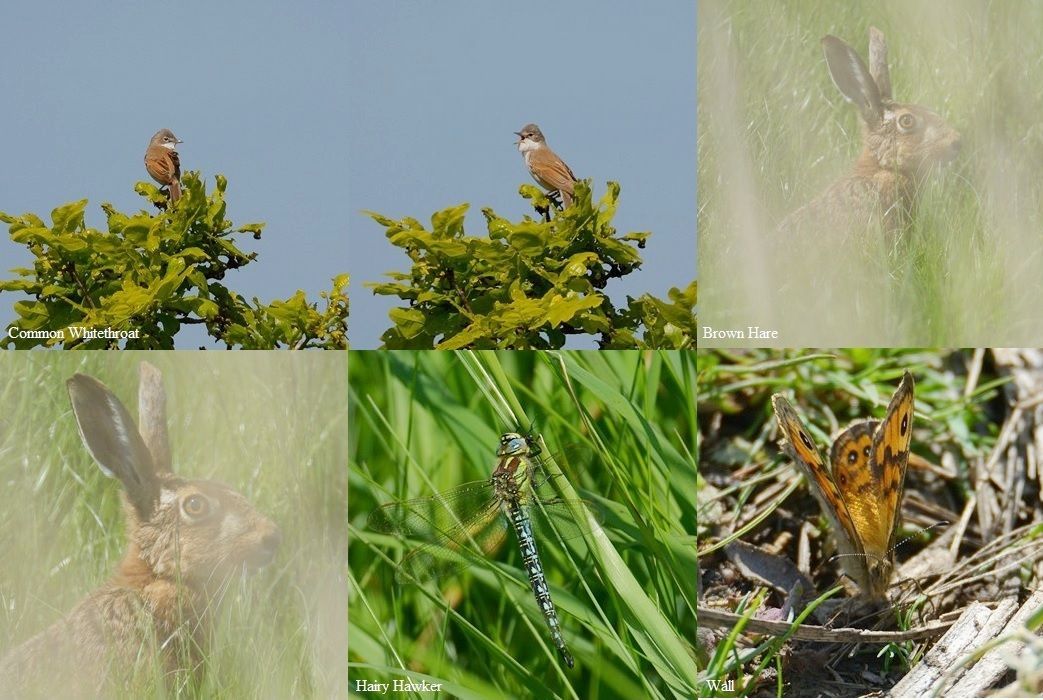

April 2024
A new site, Wheatears, Spoonbills, Herring Gull fight and Med' Gulls......
Today (23rd) we decided to go and visit a new site in interior Norfolk called Alderford Common, brought to my notice by Ken Saul who had heard a Turtle Dove there. Now this site would not have been mentioned if it was not for the fact that this is a well known (not to me!) site for Turtle Doves (further highlighted by two different people we met there who both asked were we here for the Turtle Doves!) as Turtle Doves are a very threatened species now and indeed for some considerable time!
Anyway, the long and short of it was; we ventured out on this SSSI, which we hope to return to (and not just for the Doves), but due to the amount of water seeking gravity from the clouds we were not there long as it was pointless. We didn’t hear a Turtle Dove but on the walk back we did hear our first Willow Warbler and also heard Chiffchaff and Blackcap singing.
Heading towards the Norfolk coast from an unfamiliar route we came across 2 Red Kite just south of Wiveton and passing through Salthouse Heath heard our first Lesser Whitethroat and 2 Willow Warbler and Chiffchaff singing.
In a visit to Beach Road, Salthouse we found 2 male Wheatear, 4 Sand Martin and 4 Avocet.

Along Beach Road, Cley tolerating the cold northerly wind through the open window returned results with a Sedge Warbler singing; at least I think it was worth it!
A Greenshank was once again at Morston but a more disturbing sight was of further construction work along the channel, presumably for Seal tours! The colonies of Seals along the Norfolk coast, both here and at Horsey have seen far too much development and taking back of natural resources for increased tourism and indeed wealth. A Little Egret, Brent Geese and several Redshanks were also here and 2 Swallows were seen as we left the village heading west.

2 Red Kites were seen from the A149 just before Wells Pools, where 3 Avocet, 2 Black-tailed Godwit, 2 Mediterranean Gull, Brown Hare, 3 Marsh Harrier and a fly-over Spoonbill were also recorded.
Another Spoonbill fly-past was encountered as we stopped for lunch at Brancaster Staithe. A Grey Plover was also seen and some fighting amongst two of the Herring Gulls, was quite a confrontation, resulting in what appeared to be the loser walking off with presumably the female! But how much do we really know about what is a so-called common bird’s intraspecific behaviour?
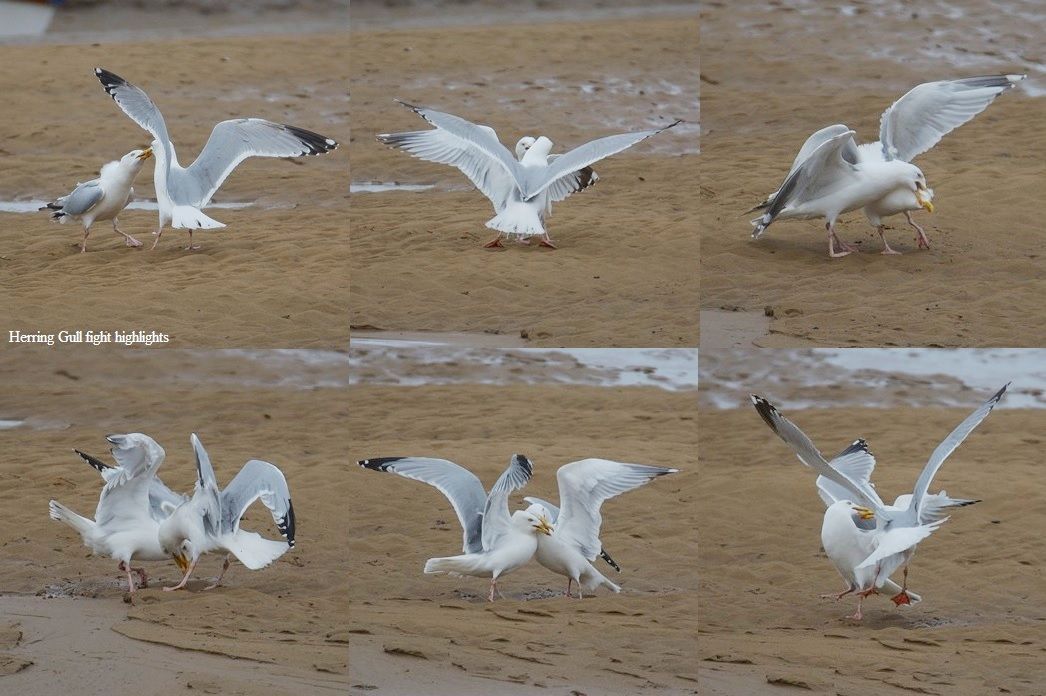

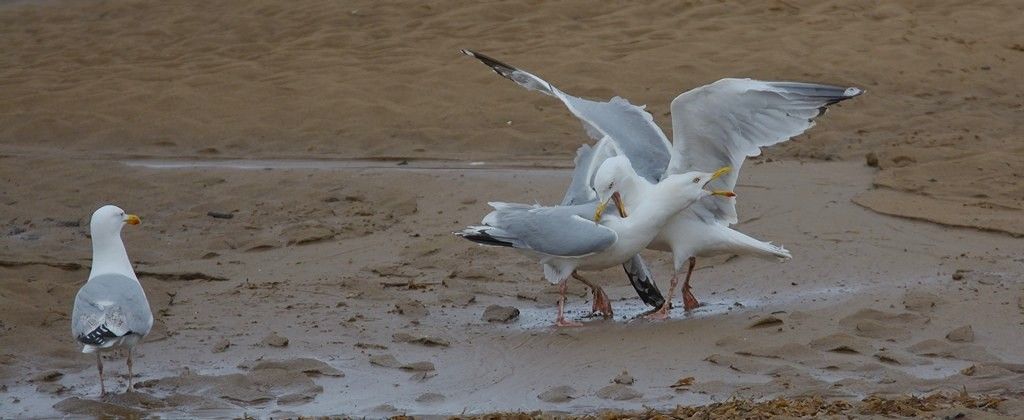
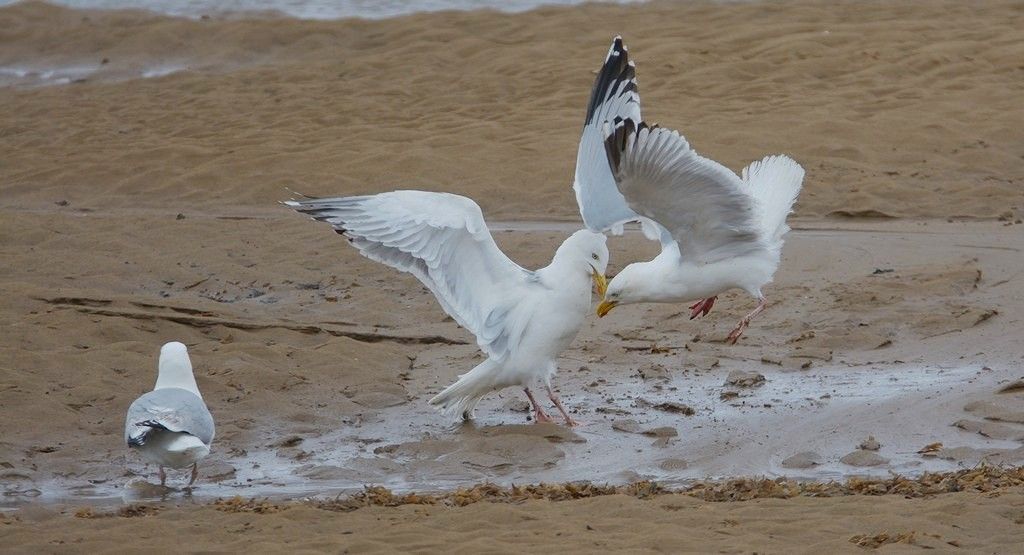
A drive around ‘the block’ at Choosley found at least 18 Mediterranean Gulls; all adults except for 2 immatures. 5 Brown Hare, 2 Common Buzzard and 3 Yellowhammer were also noteworthy here.
We stopped off at Burnham Overy Staithe, hoping for another encounter with the Red-breasted Goose but there were only a few Brent Geese here. The Red-breasted had not been reported but we like to have a look anyway. Sometimes it pays dividends and today was no exception with another fly-past Spoonbill; as Jase said at the time always a great bird to photograph in flight! 2 Avocet were also here as were 2 Little Egret.
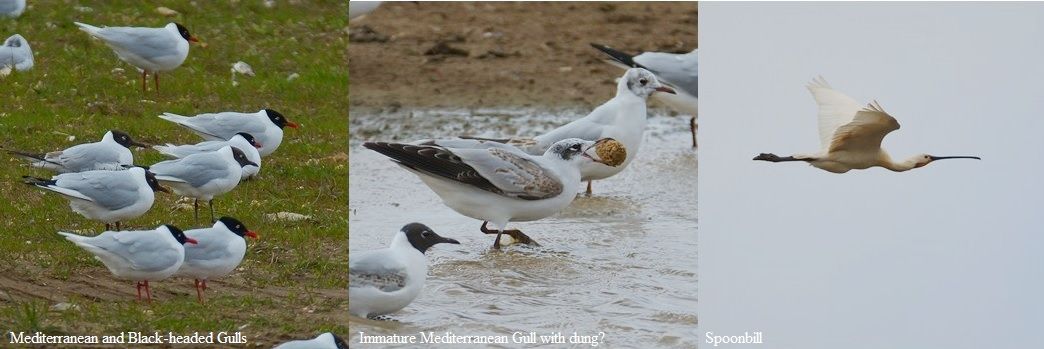
At Holkham Freshmarsh Cattle Egrets were seen again with 5 with one herd of cattle and another one with some more cattle further to the east. 2-3 Spoonbills were also seen, along with 2 Common Buzzard and 3 Muntjac.
A little further along the Freshmarsh 3 more Cattle Egrets flew past and 2 Barnacle Geese remained.
A look along Lady Ann’s Drive saw 2 more Spoonbill flyovers and several House Martins and Swallows were hunting insects over the field’s pools.
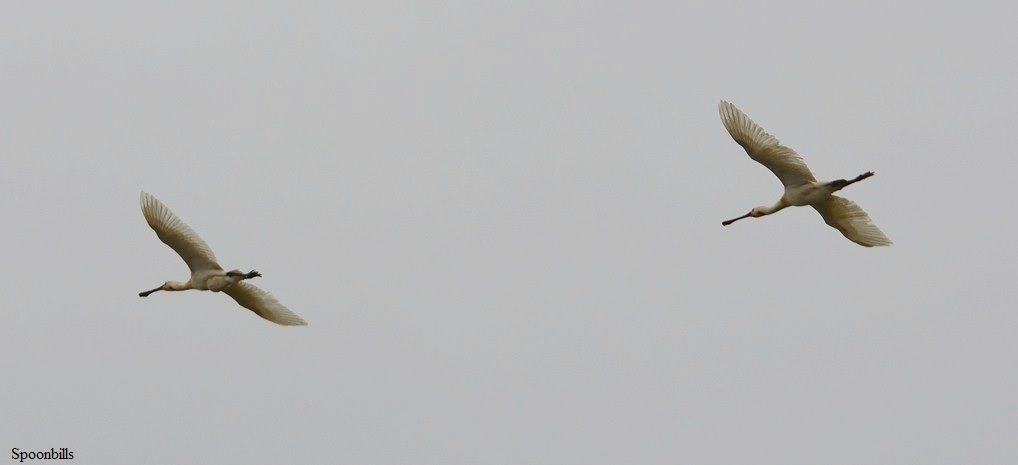
Red-breasted Goose, Ring Ouzel find and a picturesque Little Egret......
3 Sand Martins and a Swallow flying over at Beach Road, Salthouse (18th), began Jason Nichols and my day along the North Norfolk coast.
At Morston Harbour we found a Spoonbill asleep out in the saltmarsh and a Little Egret in front of that and then a Greenshank in the channel in front of the egret! Brent Geese were once again present here.
En-route we passed a Swallow on a wire near Warham, after a traffic diversion; again!
The Red-breasted Goose had been reported with Brent Geese at Burnham Overy Staithe and we had distant view of it amongst the Brents in the channel. However, the Brents began to take flight, but despite scrutinising every departing goose we could not find the Red-breasted in their midst. Even when they headed back again there was no sign of the R-BG, so any chance of capturing an image of this goose in flight was thwarted. Also here was a Great White Egret flying past, Little Egret, Mediterranean Gull and Red Kite.
Brancaster Staithe was next but the only real highlight here was 4 Avocet.

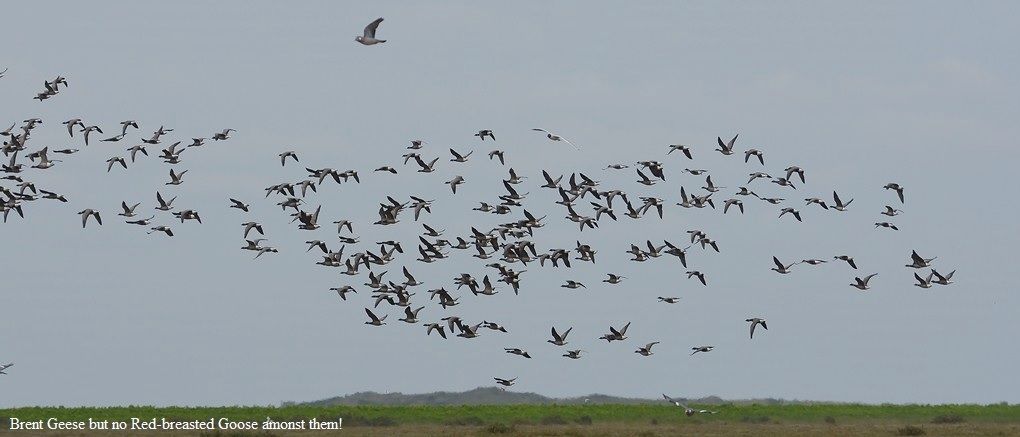
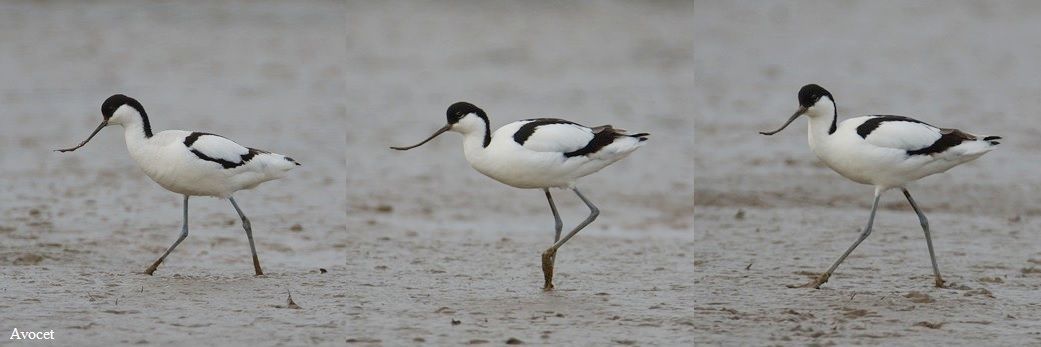
However, at Choosley, Jason spotted a male Ring Ouzel and Mediterranean Gulls, Muntjac 5 Chinese Water Deer, 12 Yellowhammer, 2 Oystercatcher, 2 Shelduck, Red Kite, Common Buzzard, several Stock Doves and 4 Brown Hare followed.

Travelling back through Burnham Overy, just before the bridge at the mill stood a Little Egret on a tree stump. Somewhat predictably we stopped to photograph this very scenic image.
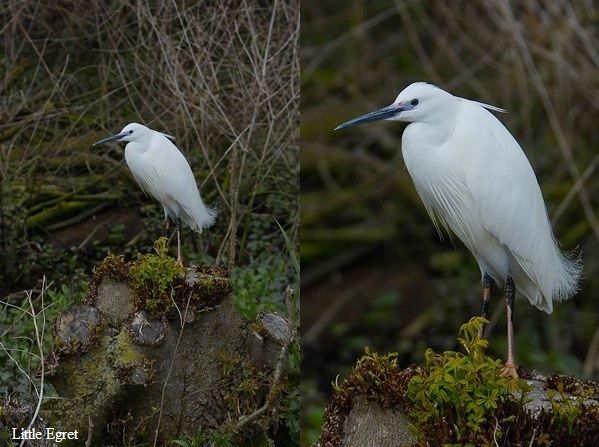
Travelling back through Morston I saw my first House Martin of the year and a Swallow. Unfortunately, Jase did not see the martin as he was ‘concentrating’ on the road!
A Glossy Ibis had been reported at Cley from Beach Road, but despite standing on a very cold and windy flood bank we could not find it so 3 Golden Plover had to suffice!

Wheatears, Garganey, Bee on the leg and a large flock of Cattle Egrets......
5 Wheatear were a welcome start to Jason’s and my day out in Norfolk (11th) on the Eye Field at Cley. Also here were Meadow Pipits and Skylarks, which gave the opportunity for some relatively close up photography.
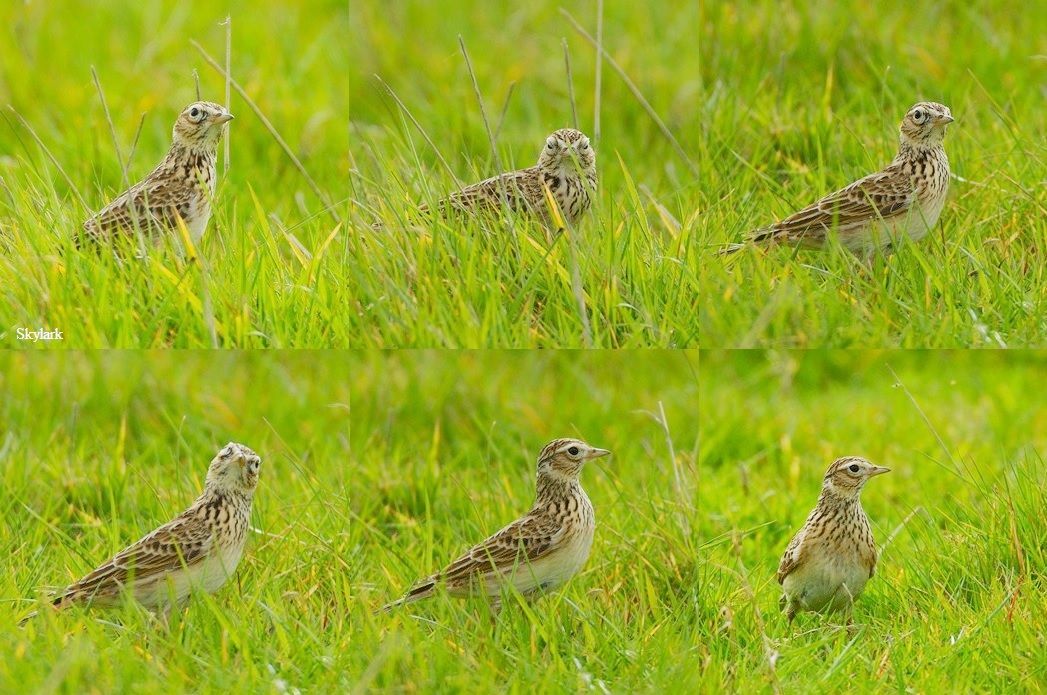
We decided to head straight to Thornham, as 2 Spoonbill and 2 Garganey had been reported (always great birds to see) and call in at our usual stops on the way back down the coast. No Spoonbills here but after working out where the pools were, where the Garganey were reported, from the flood bank we found a nice pair of Garganey, just below us. Also here were Gadwall and Teal and the drake Garganey constantly chased off any drake Teal near him.


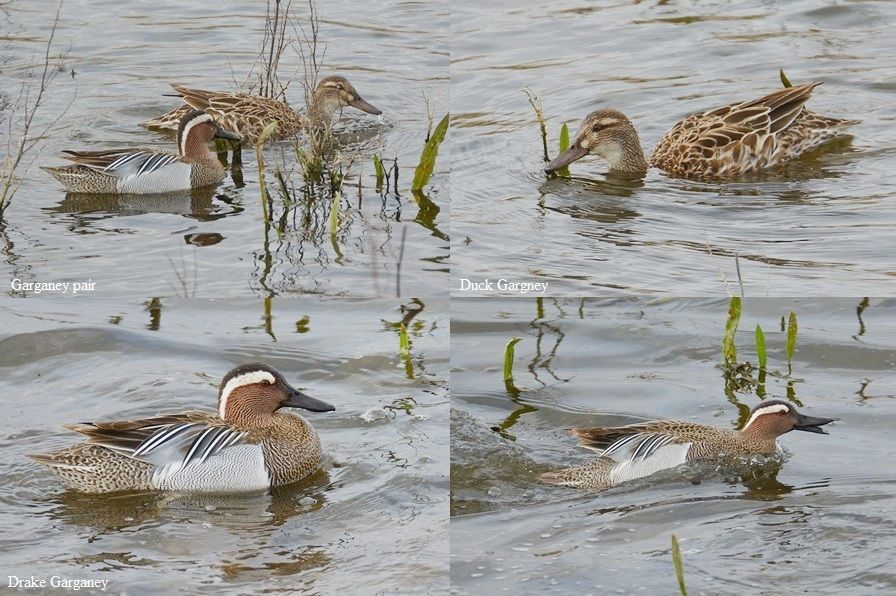

A drive around Choosley Barns followed and here we found a collection of spring Butterflies, including our first Orange-tips and also Holly Blue, Peacock and Small Tortoiseshell.
2 Chinese Water Deer were present plus one Brown Hare and bird wise we found 3 Red Kite, 2 Common Buzzard, approximately 12 Yellowhammer, a Corn Bunting and a pair of Grey Partridge near to the road on the grassy verge.
Whilst here, Jason noticed I had a Bee on my trouser leg and so I did! It was a female Andrena nitida Grey-patched Mining Bee. After a photo session with the said bee I encouraged her out of the car again.

At Brancaster Staithe 9 Black-tailed Godwit and 150+ Brent Geese were the highlights before stopping off at the pull-in at Burnham Overy to view the marshes. Here we found Red Kite, Common Buzzard, Marsh Harrier and in the distance towards the West 3-4 white birds in amongst the cattle, indicating Cattle Egrets.
Further along we stopped at ‘the gate’ at Holkham Freshmarsh and to our surprise found many more ‘white dots’ amongst, what was probably the same herd of cattle seen from the pull-in at Burnham Overy. Further scrutiny found these to be Cattle Egrets and when they flew up Jase estimated there were at least 25! Certainly, from the photos later at least 18 were visible in one image but I have no doubt there was more than that and certainly the biggest flock we have seen in the UK.
Also here we saw 3 Spoonbill, 2 Marsh Harrier, 2 Chinese Water Deer, a Blackcap heard singing and another male Orange-tip. Further along from the other pull-in we found 10 Barnacle Geese.

At Morston a Swallow was on the telegraph wires and Brent Geese were the highlight from the harbour.
We looked for a reported Ring Ouzel near Bodham on the return journey home but didn’t succeed in finding it.
Raptor photography, Egyptian family and finally, a Night Heron......
With a Night Heron a possibility, Jase and I set off along the North Norfolk coast (4th) seeing a very pale phase Common Buzzard perched on a tree guard at Felbrigg Park en-route.
With very little along Beach Road, Salthouse we headed for Cley and parked up at the pond at Walsey Hills as the car park (where we really wanted to be) was full at the start of the East Bank. However a pair of Pochard was on the pond and Little Grebes could be heard calling, or should that be singing!

The reason (on this occasion) for the East Bank car park being full was just west of the car park was where the wood was being viewed from, where a Night Heron (now named-Black-crowned Night Heron) had been seen.
The first thing than caught our attention was the sounds coming from the Heronry, which were somewhat indescribable and presumed to be emanating from the Little Egrets nesting there,; gurgling and gargling etc at best described!
Whilst stood there we heard our first Sedge Warbler of the year and also the tones of Chiffchaff and Cetti’s Warbler, but it was becoming clear that spotting this heron was no easy task, as there were very few gaps through the wood and its interior being quite dark and where there were visible ‘gaps’ these were thwarted by branches. In fact it was some time before we actually saw a Little Egret in there and when these sat down in their barely visible nests they too couldn’t be seen.
There had been one report of the Night Heron earlier in the morning but none since and the small group assembled there could not see it, as couldn’t Jase and me, so with us and equipment getting very wet we decided to leave and come back later.
With only a pair of Oystercatchers along Beach Road, Cley we headed to Blakeney and from the harbour looked for the recently reported Red-breasted Goose, but despite there being a good number of Brent Geese here there was no sign of the red-breasted and a few shots of a close in Little Egret had to suffice the visit.

Further along the road we stopped and looked over Blakeney Freshmarsh but apart from a few species of Duck there was very little else so we pressed on.
At the Horse Paddock at Morston (privately named ‘Thrush Corner’) a Common Buzzard was perched on a post and turning around and driving slowly past and parking up near the paddocks I managed to get some fairly nice portraits; unfortunately it flew onto the stable before Jase could point his camera at it! A Magpie was also photographed on another post and there was a facially ‘scarred’ Rabbit in the bottom of the hedge, keeping an eye on the buzzard!
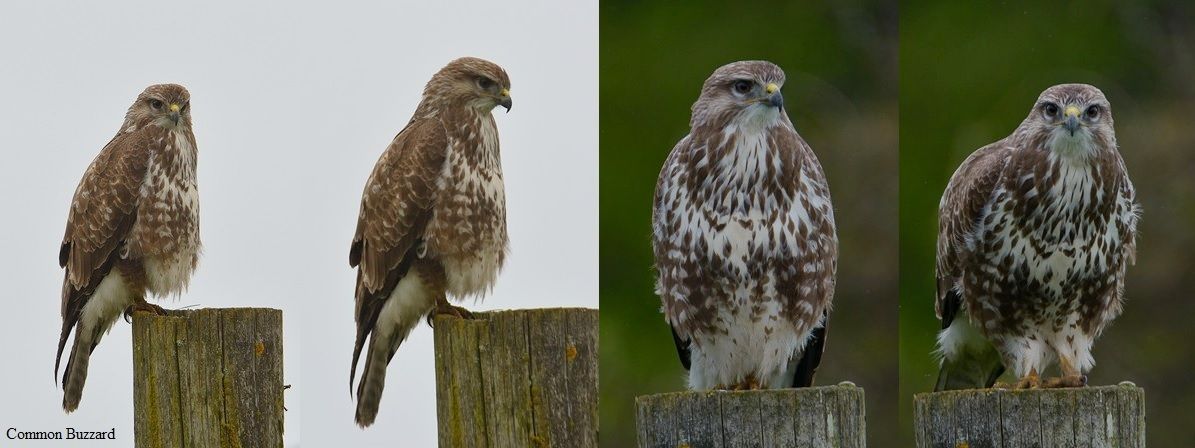

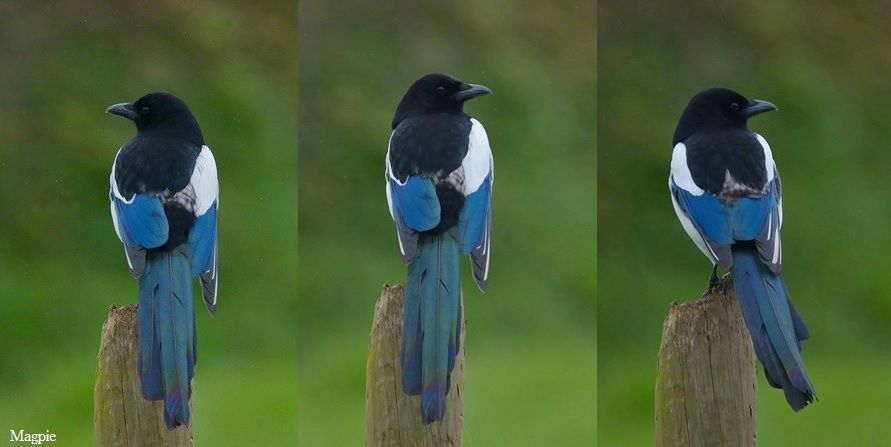
Calling in at Morston Harbour was rather uneventful but at least 10 Redshank, Curlew and 4 Oystercatcher were of note.
On to Wells Pools where more bird of prey photography was had when a Red Kite (one of two ultimately) hanging around over the adjacent field and also perching on a fence post, before using the combination of its wings and tail to keep it position, whilst scouring the field below it. A Common Buzzard was also here as was a potential pair of Marsh Harriers; at one point one of the harriers came to close to a Brown Hare and the hare chased it off and also reared up towards the potential threat. I have seen this kind of behaviour before between the same two species. A fully grown Hare would most likely be too much for a Marsh Harrier but the Leverets certainly wouldn’t be!
At least 7 Brown Hares were seen in total as was a Chinese Water Deer. 50+ Black-tailed Godwits were seen as well as several Avocets.
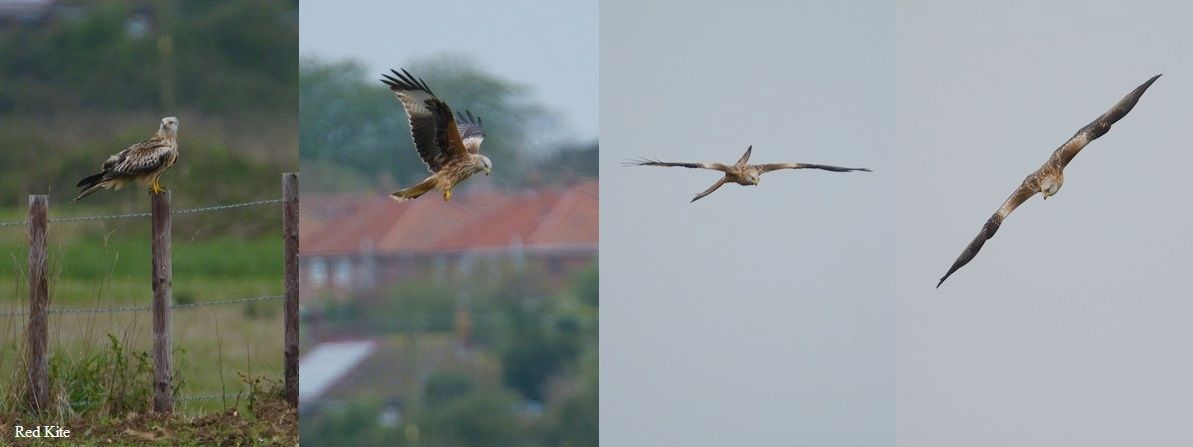


Instead of venturing further west I suggested it might be better to head back to Cley, visit the ‘middle’ hides and also be in the area in case the Night Heron was reported again. So, back towards Cley it was.
With the Long-billed Dowitcher being reported again we first looked for it from the eastern-most hide, but despite a few Black-tailed Godwits, which it often frequents with there was no sign. Plenty of Avocets though and a single Ruff, but two Little Ringed Plovers were our first for 2024. Also here was a family of Egyptian Geese with 5 goslings, which proved irresistible to the camera!
Entering the adjacent hide, we ‘bumped’ into Guy and Tim Oxborough who told us where the Dowitcher was and so after a brief conversation we view the American visitor briefly before it disappeared again before coming out again briefly later. Another Ruff was here along with more Black-tailed Godwits and Avocets and a Bittern was heard booming.
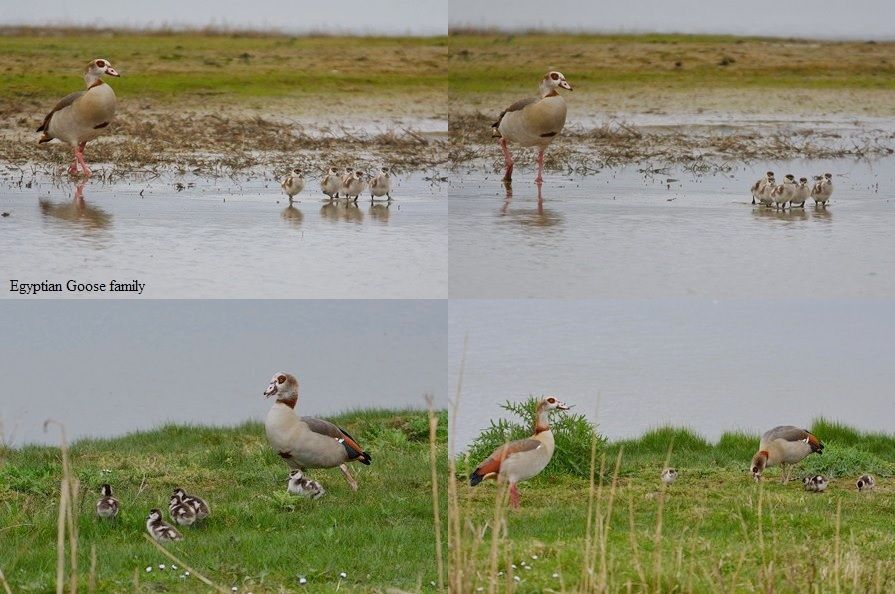

There had been no reports of the Black-crowned Night Heron since the solitary morning report, but we returned there nonetheless.
The small Heron had still not been seen according to the 3 people stood there and they eventually left and we continued to look for the heron, seeing several Little Egrets come and go and once again those sounds emanating from the wood!
We were then joined by another individual who we later found out to be Gary, who ironically had seen and reported the bird in the single morning report. He stood to the left of us and somewhat surprisingly after a few moments said he could see it preening! Gary was good enough to let us have a look through his scope and then we set about trying to find it for ourselves in the near impenetrable, dark ‘wildwood’ with its peculiar audio!
This was my first Night Heron in the UK (not that that really matters nowadays) but I was very pleased to finally see it and then set about the nigh impossible task of at least capturing a worthwhile distant and dull image.
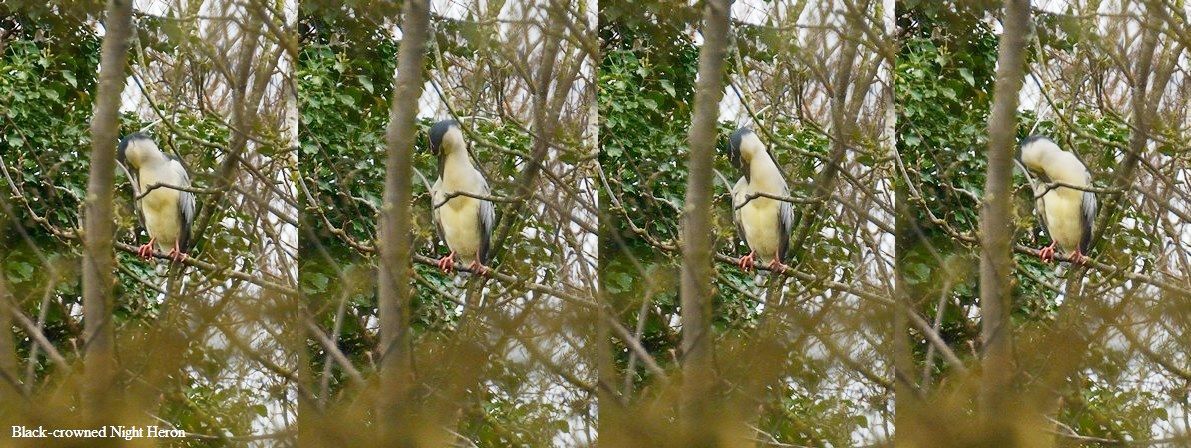
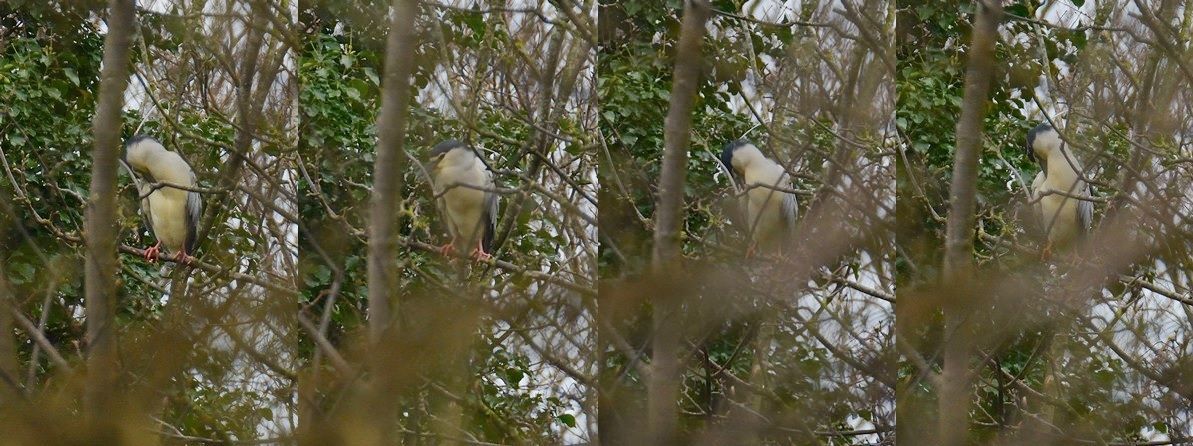
Whilst I was going about this I noticed that Gary had got a sketchbook out and was drawing and indeed painting in watercolours. Now you do not see this way of recording animals only rarely nowadays and I was impressed and asked him about his artwork and if he would send an image from his sketchbook to use on the website.
Meanwhile, photographing the Night Heron was proving rather tricky and was one time I could have done with a tripod as using auto-focus was a no no, with all the branches, big and small in front of the preening heron! However, I persevered manually focussing whilst trying to hold what is a rather heavy lens still and in focus, at least what I could see to be in focus in the gloom and only using 800 ISO, f.8 1000 shutter speed.
Eventually Jase saw the heron fly to the left somewhere out of sight (of which there was multiple opportunities!), but before we left I spotted 2 Swallows flying west over the reedbed; the first of the year.
A really good day despite the rain, dull skies with the odd bit of sunshine and I can report that Gary Wright did send me a small image of his sketchbook (right-copyright Gary Wright), with work that almost emulates stuff you would see by Tunnicliffe!
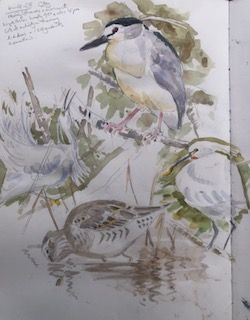
March 2024
Shags, Scoters and Cattle Egrets start the day......
Today (28th), with Jason began at Winterton where we looked for recently reported Velvet Scoters. However, the first ‘dark birds’ on the sea turned out to be 3 Shags not Scoter but then 2 Scoter flew past and landed and both had white wing panels so we had eventually found Velvet Scoters, along with a fly-past Red-throated Diver and several Grey Seals.
A drive along the coast road found very little but turning off towards Hickling at Sea Palling produced 2 Cattle Egrets in a field with cattle and nearby a Chiffchaff was singing.

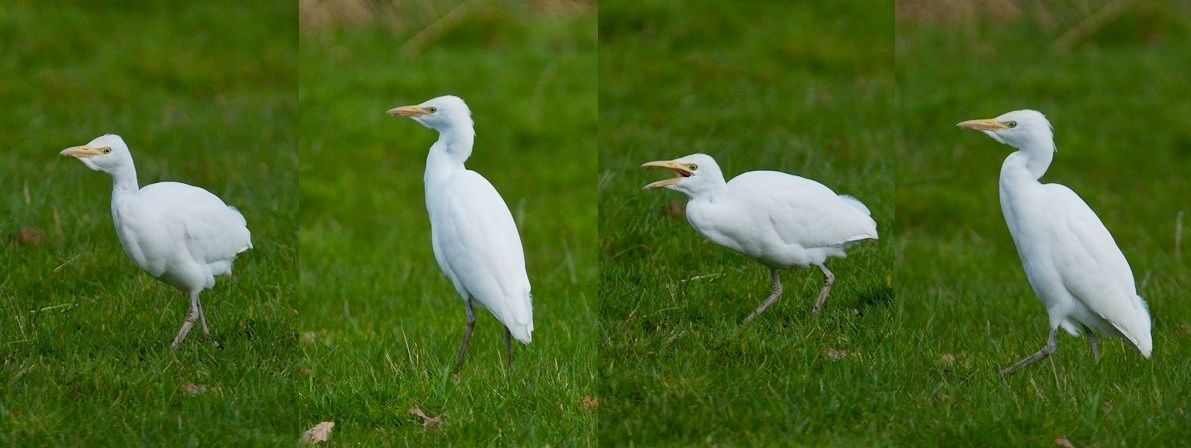
Heading along the Stalham By-pass, Jase said he had just seen a black and grey Crow, so with a little encouragement from me we turned around for what turned out to be three passes to try and see what this Crow was. On the second pass I saw the crow from above as it was just in from the road on a field and saw that the grey and black upperparts were very ‘clean’ and suggested a Hooded Crow and not a Carrion/Hooded hybrid. However, on the third pass to try and get photos the crow had disappeared!
Moving further along the coast a Red Kite was seen at Weybourne and then another at Beach Road, Salthouse where there was also a Little Egret and 10 Curlew.
A walk along the ‘Iron Road’ at Salthouse in search of a charm of Twite seen at the end of the road was unsuccessful. Nevertheless, birds seen from along the track were: 5 Ringed Plover, 3 Ruff, 6 Avocet, Common Snipe, 2 Canada Geese, Marsh Harrier and yet another Red Kite.
At Morston 6 Redshank, 2 Curlew, 4 Oystercatcher, Marsh Harrier and at least 10 Brent Geese were recorded, before moving on to Wells Pools where the 4th Red Kite of the day was seen along with 13+ Avocet and 30+ Black-tailed Godwit.
Despite stops at Holkham we found very little else and decided to head back with a one last unsuccessful attempt to find the ‘Crow’ again!
First Sand Martins and Wheatears!
The day (21st) began along the North Norfolk coast at Beach Road, Salthouse with Jason Nichols and it was here we saw our first two Sand Martins of the year.
We decided to head for Titchwell in search of Waxwings, seeing 4 Brown Hares and 2 Red Kites, whilst passing Holkham. However, there was no sign of any Waxwings along the approach road at Titchwell only a singing Chiffchaff was worthy of note.
A bit of information revealed that the 5 Waxwings had just been seen in a dead tree at Choosley, but again no Waxwings here either, so we continued with our ‘round the block’ drive at Choosley where we found at least 6 summer plumaged Mediterranean Gulls, Red Kite and 4 Common Buzzard together, 6 Brown Hare and 2 Chinese Water Deer.
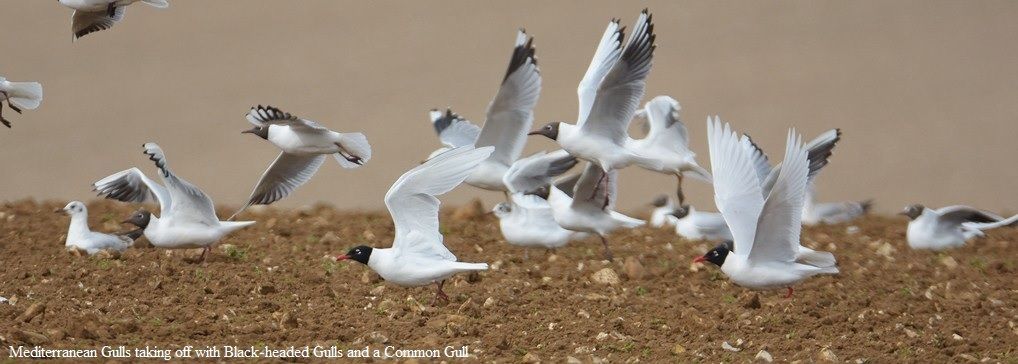

At Brancaster Staithe we found another Red Kite and a few waders, represented by Curlew, Redshank, Oystercatcher and Turnstone.
A view from ‘the gate’ at Holkham found at least 7 Spoonbill (hopefully there for a successful breeding season), 3 Marsh Harrier, Red Kite and further along in the next pull-in; 3 Barnacle Geese, Brown Hare and a Chinese Water Deer.
The highlight at Wells Pools were 21 Avocet, but just before Morston a doe Roe Deer was seen and then whilst watching the deer 2 Mistle Thrushes were also seen.
A return to Cley Beach Road was very worthwhile were we (Jason!) spotted a female Wheatear followed by a male. Our first Wheatears of 2024 and opposite on Blakeney Freshmarsh there was a male Stonechat.


Another stop along Beach Road, Salthouse 2 Ringed Plover was seen and a pair of Linnets perched on the wires provided a spot of photography to finish the day with.
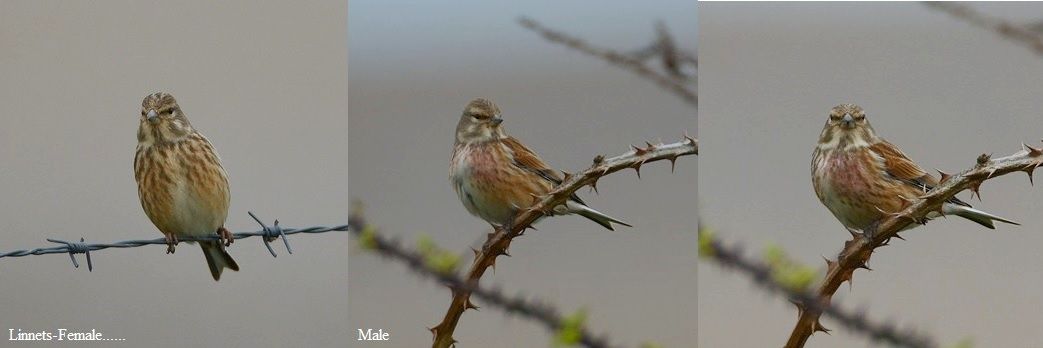
A wet day in the Brecks, but Hawfinch saves the day......
With Jason now back from his successful trip to Florida to see Manatees it was back to the usual (12th) and the first combined fieldtrip of March.
Heading to Norfolk’s interior (The Brecks) it became very clear as we travelled we were going to get wet! And so it was to be as we began walking towards the site for the reported Great Grey Shrike near Weeting. However, a short way down the track Jason checked the details of where the shrike was meant to be and with the conditions what they were and the distance involved, we decided to try somewhere else.
The rain and gloomy conditions continued and according to the BBC weather forecast would continue to do so all over Norfolk, but we drove to Lynford Arboretum in search of anything we could find!
We walked down to the ‘gate’ and looked down the tunnel of trees where food had been provided as well as a depression for water (not that, that was needed today!) and found several birds coming down for seed. These were mainly Chaffinches and Blue Tits but it was a start.
Nuthatch, Bramblings, Dunnock and Yellowhammer added to the variety and then I saw a Hawfinch on the ground. The male Hawfinch was feeding amongst Chaffinch and Brambling and the size comparison was there for all to see! Later Jase saw a female Hawfinch as well and despite the terrible photographic conditions we managed to get some images with some far from normal camera settings!
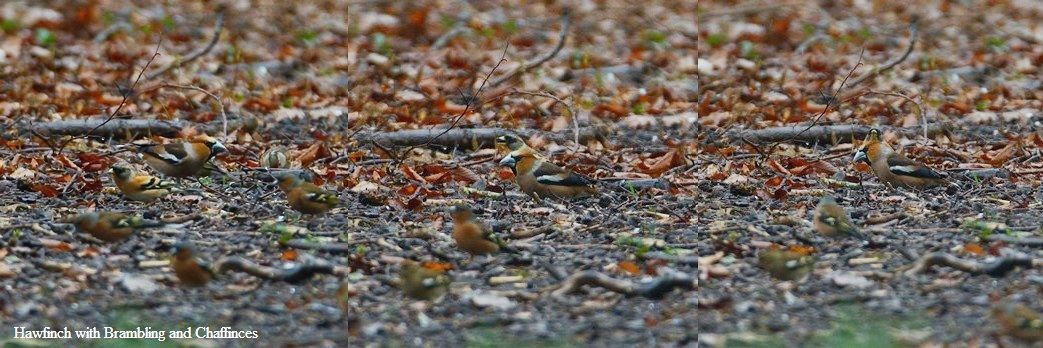
Deciding the camera equipment had enough of the conditions (let alone us!) we headed back to the car and then drove to Cockley Clay for lunch and in search of Goshawks that wouldn’t be there; and they weren’t!
So, we decided to head back closer to home and thus adding to the animal RTA’s seen already along the A11 with 2 Badger, 2 Fox and 3 Muntjac; approximate totals both ways.
First port of call was the area around Clippesby where we found 10 Cranes including two juveniles. A bit of displaying ensued, always nice to see the Crane dance and 2 Common Buzzards and a Sparrowhawk were also of note here along with several Stock Doves.
The road from Hickling to Sea Palling came up trumps (not to be confused with that idiot yank!) with a total of 4 Cattle Egrets feeing amidst the ‘large white cattle’ at Sea Palling. A Brown Hare was also seen in a field and a Common Buzzard perched on a nearby fence post avoided my photography albeit in still very dull un-photogenic light, so never mind!
A damp but still enjoyable day with my partner in crime back and we still came up with the goods!
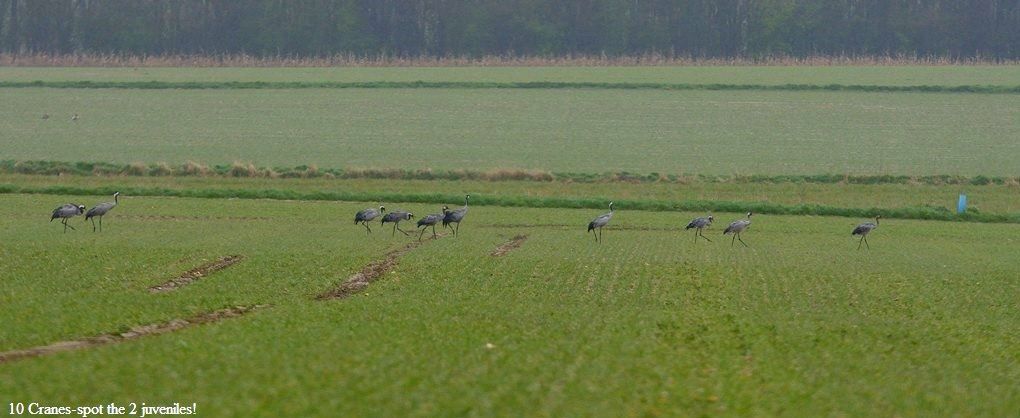

February 2024
First Bumble, Spoonbill and Grey Partridge of the year......
The day out (15th) with Jason got started at Beach Road, Salthouse with a male Stonechat perched on the fence wires and a Little Egret was also of note.
With very little along Beach Road, Cley we stopped at Morston on the corner opposite the church where we found 4 Redshank, approximately 80 Curlew and our first Buff-tailed Bumblebee of the year. At the quay 30 + Brent Geese were the only birds of note due mainly to the high tide.
En-route to Wells we came across a Red Kite at Stiffkey and at Wells Pools our first Grey Partridge calling as it walked across the path. Another one was heard and Red Kite, 3 Marsh Harrier (males calling), Common Buzzard were the birds of prey present along with the Wigeon and Teal they made to feel very uneasy!

Various Duck species were found along Lady Ann’s Drive at Holkham but the area did not yield the biodiversity as it did last Thursday.
A stop for lunch at Brancaster Staithe found a few waders, which included Curlew, Turnstone and Oystercatcher and ducks but not too much of note due to the high water level.
We had already passed a few Brown Hares along the drive, which seemed to be quite active and here at Choosley we saw at least 10, along with 2 Chinese Water Deer. Birds here were: Red Kite, Marsh Harrier, Common Buzzard, 4 Yellowhammer, 12 Stock Dove and a mixed charm of finches containing Chaffinch, Goldfinch, Linnet and a few Bramblings.
The pull-in along the A149 at Burnham Overy found our first Spoonbills of the year with 2 present on the distant pools and a Great White Egret was also seen here.
With work going on at Holkham from ‘the gate’ there wasn’t much to see so we travelled a short distance to the second pull-in where we found 3 Barnacle Geese of uncertain origin with Grey-lag Geese, 3 Common Buzzard and a flock of Spoonbills in flight numbering about 12, which set down out of sight somewhere on the distant Freshmarsh.
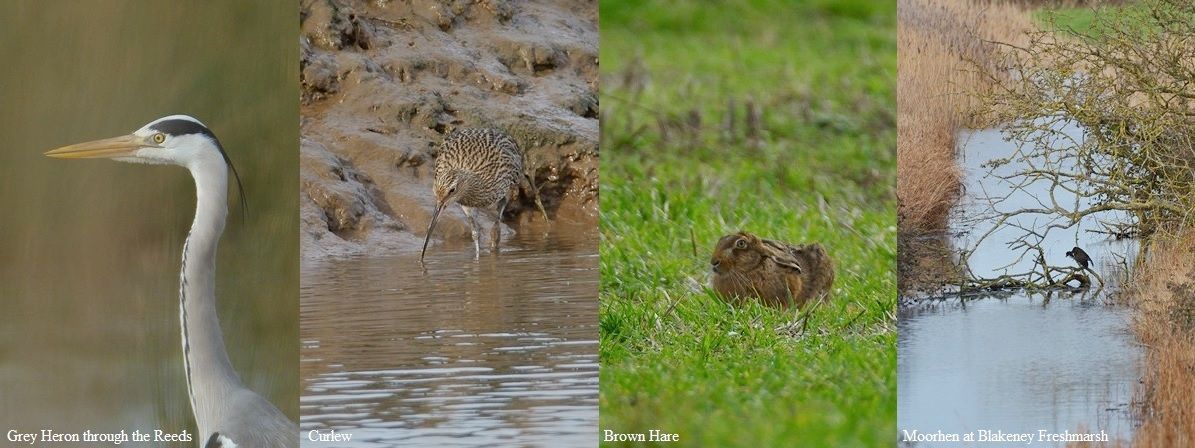
On the way home we visited the flooded potato field at Sutton where we found 30+ swans still present. This time there were mainly Whooper Swans with several Mute and 1 Bewick’s Swan. With reports of Bewick’s seen flying east in the past week or so, no doubt heading back to their breeding grounds it was very worthwhile to stop and get some more images of ‘wild swans’ as an opportunity like this at such close quarters doesn’t come around often, if at all!

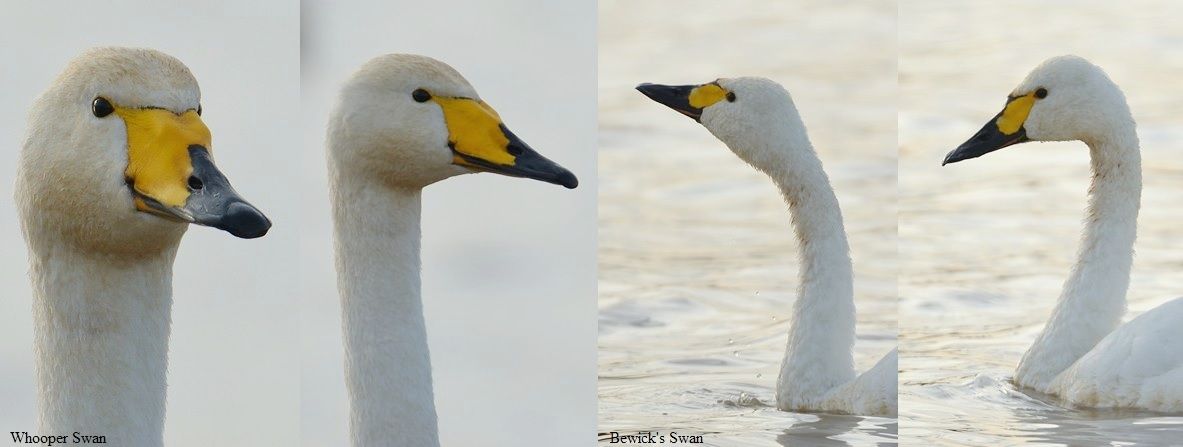
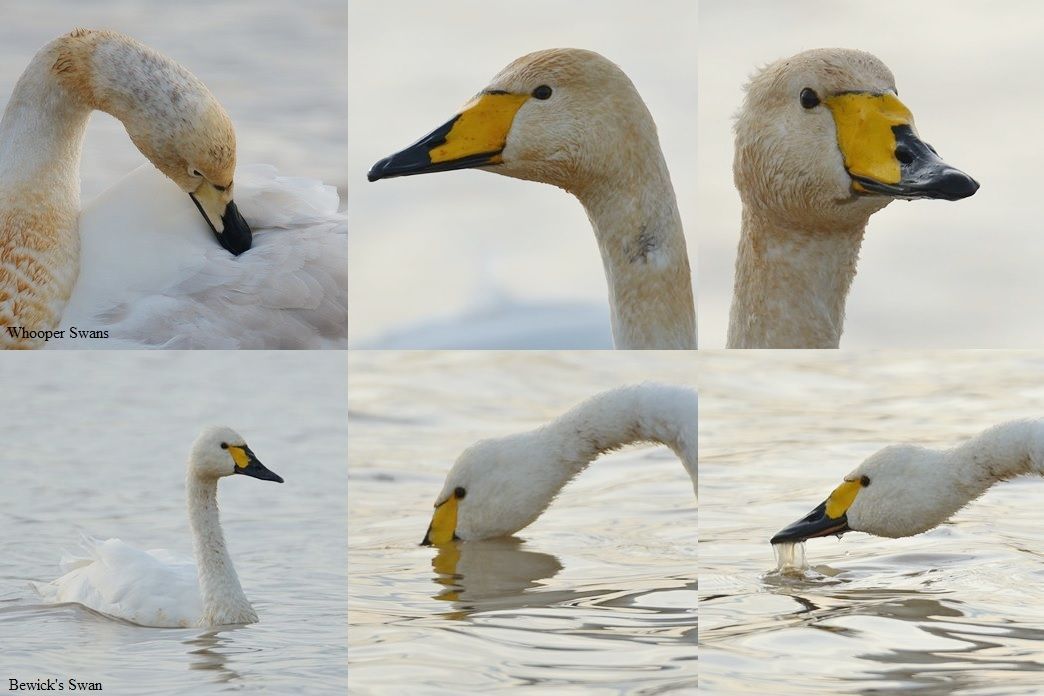
Birds utilising wet and flooded grassland on a murky, cold and precipitating day......
Another overcast, precipitating, murky Thursday (8th) with Jason Nichols began at Beach Road, Salthouse, where a male Stonechat was the only bird of any significance, or any degree of significance!
A flock of approximately 300 Brent Geese were on the field adjacent to the Cley visitor centre (but no Red-breasted Goose amongst them) and the Eye Field from Beach Road, Cley provided us with a few waders in the gloom, notably; Golden Plover, Lapwing, Oystercatcher and Turnstone. A Great White Egret was on the field where it had been seen on two previous occasions just outside Cley village.
Another Great White Egret flew in at Blakeney Freshmarsh, where there was also a Marsh Harrier making the Wigeon and other birds present very nervous!
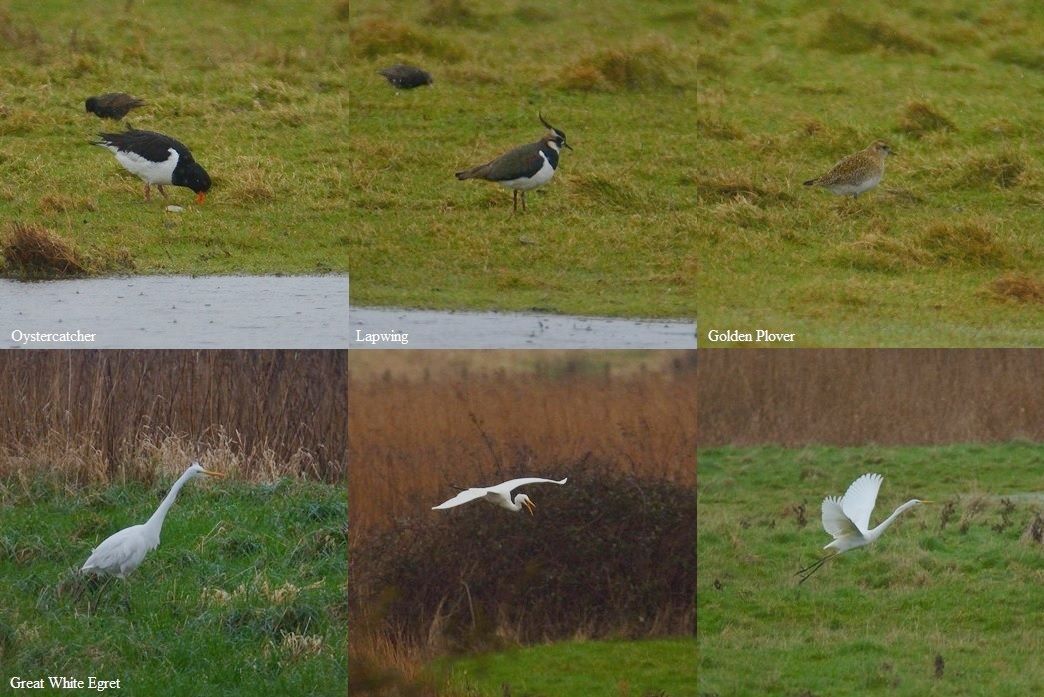
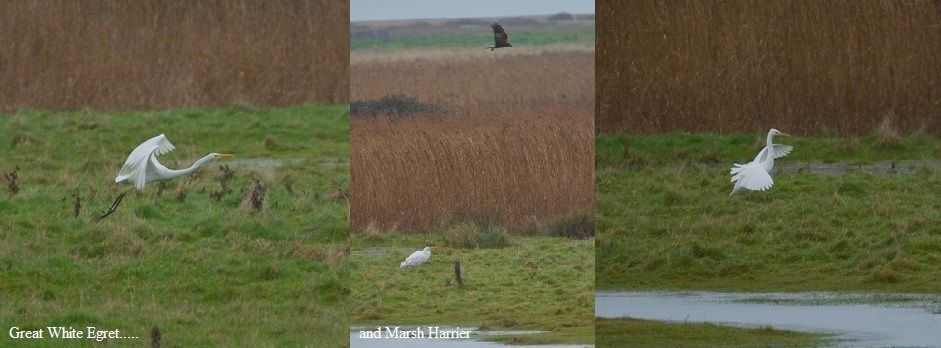
The Horse paddock opposite Morston church (which we named ‘Thrush Corner’ some time ago) lived up to its name with a 30+ flock of thrushes containing both Fieldfares and Redwings, but also very notable here were a count of 52 Curlew also. A Little Egret was on an adjacent field and it did seem that the recent and today’s weather was providing food on wet and flooded grassland for birds.


At Morston Quay we eventually found a Greenshank again and also here were 14 Dunlin, 6+ Redshank, 2 Grey Plover and a Little Egret.
Driving past the flooded area just before Stiffkey Village we saw some duck there, in passing and decided to turn around and go back for another look. Stopping along the bendy road here is very difficult but a very brief stop allowed a few images of what was a pair of Pintail and Egyptian Geese.
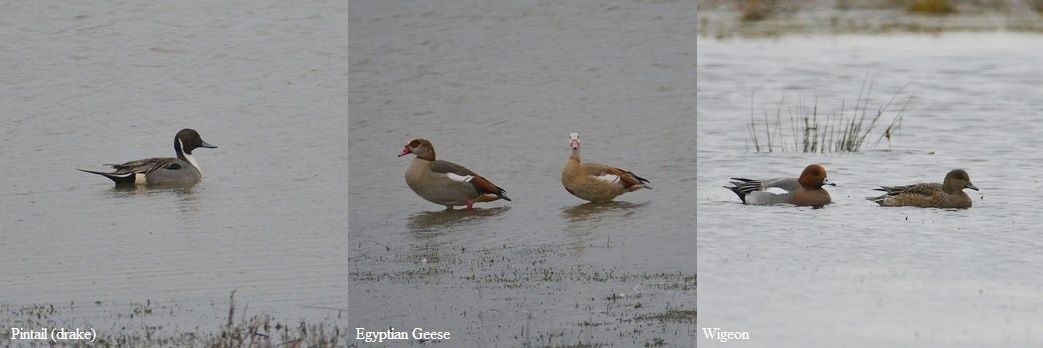
With no sign of the recently reported Glossy Ibis on the flooded fields at the end of Stiffkey village we continued to Wells Pools where there were good numbers of Wigeon but very little else, but gunfire heard may have been the reason!
More wet meadow watching continued along Lady Ann’s Drive at Holkham and we were rewarded with our first Ruff (3) of the year, alongside 5 Common Snipe, 8+ Black-tailed Godwit, Lapwings, Teal, Wigeon, Shoveler and Mallard. 2 Common Buzzard were seen to the east of the drive, one being a pale individual perched on a fence post in the distance. But the dark-morph Buzzard was on the ground alongside 2 Marsh Harriers and a Red Kite repeatedly flying over the same area. It was obvious there was carrion to be had and a Marsh Harrier flying off with something and later via images confirmed this; the object of the birds of prey attention was a dead bird, possibly a duck species.
There was no sign of any Cattle Egrets this time at Burnham Norton, but there were at least 1000 Pink-footed Geese in fields opposite the turn-off for Burnham Norton and 9 Muntjac in one field along the lane.
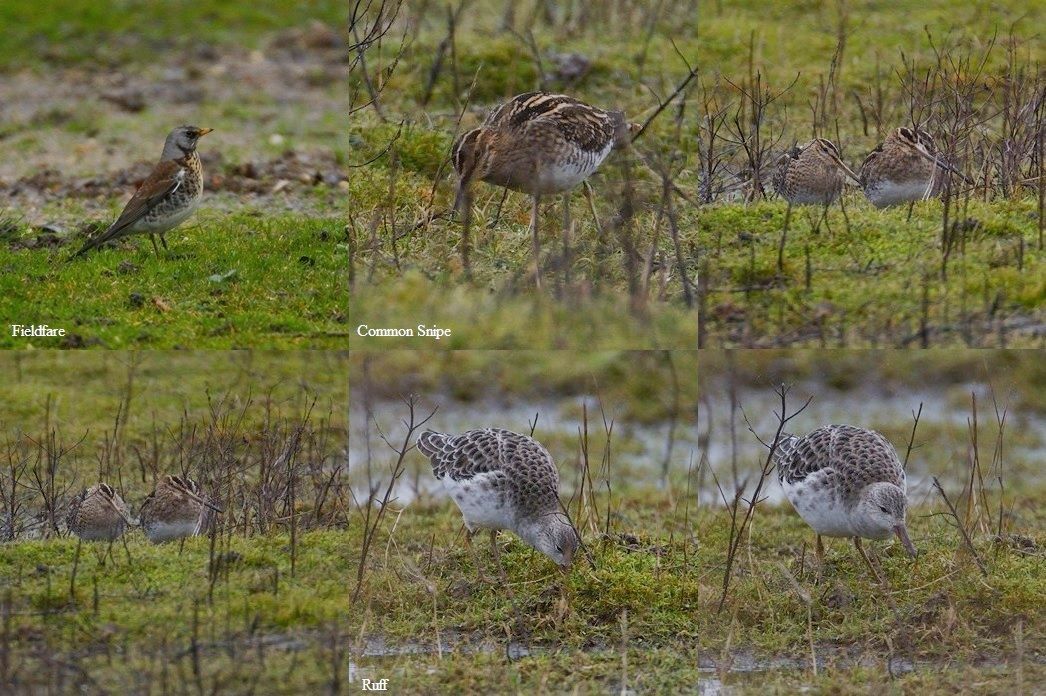

Just a misty landscape was found from ‘the gate’ overlooking Holkham Freshmarsh and Jason mentioned that the temperature had dropped to 2 degrees according to the car and this was also underlined by the rain now turning into sleet!
A stop at the second pull-in found at least 100 White-fronted Geese, before hearing that a charm of Twite had been found at Cley, so we continued back along the coast to Cley.


Parking-up near the sluice along Beach Road, Cley we foolishly decided to get out of the car and go up onto the flood bank, overlooking Blakeney Freshmarsh. The weather was atrocious; saturating rain with a bitter icy wind and overcast skies! We saw a few Goldfinches and then led by Jason, decided enough was enough and headed back to the steps, but I then saw a Pipit along the channel and although it did not stay still (at least not in view- on the mud behind a fence panel) I saw enough to confirm it as a Water Pipit. However, with the skies darkening further and both of us very damp and ‘chilled to the bone’ we headed home after a productive day despite the weather!
January 2024
'Swan Lake' and three Egret species......
The day (25th) with Jason started out at Sutton where we hoped that the ‘wild swans’ would still be present. Yes they were with roughly 60 swans present containing both Whooper and Bewick’s on this flooded potato field where presumably they were feeding on potatoes
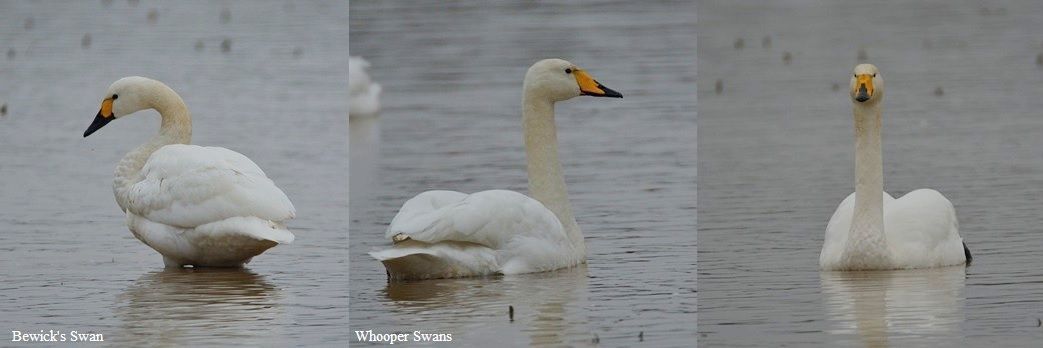
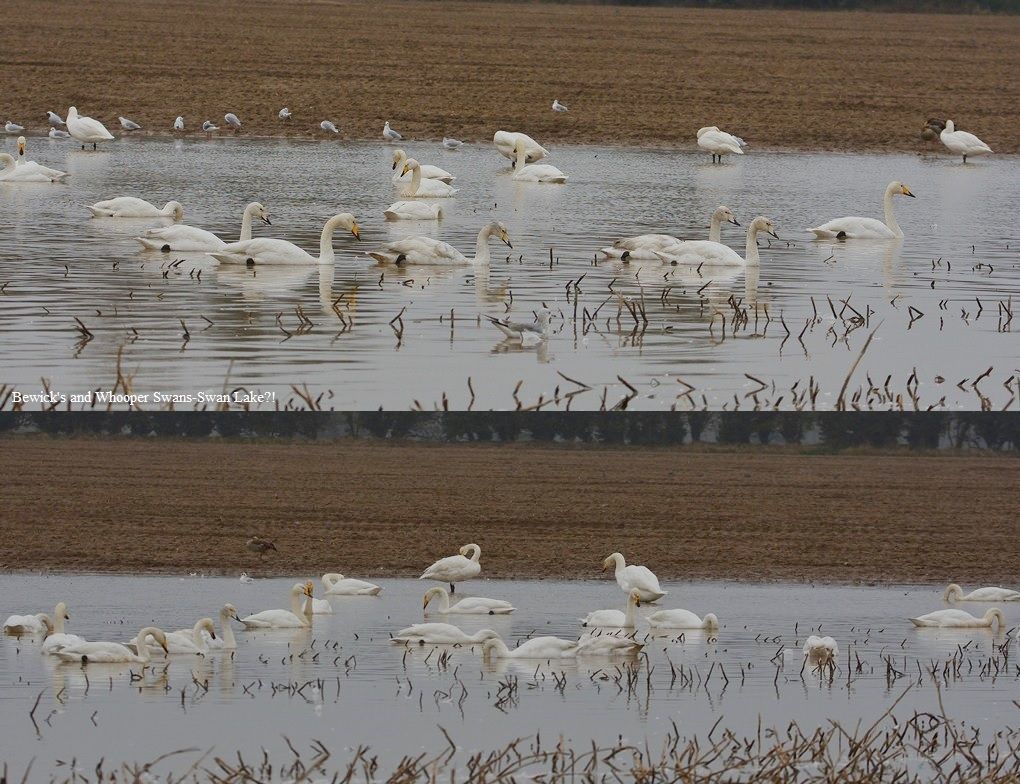
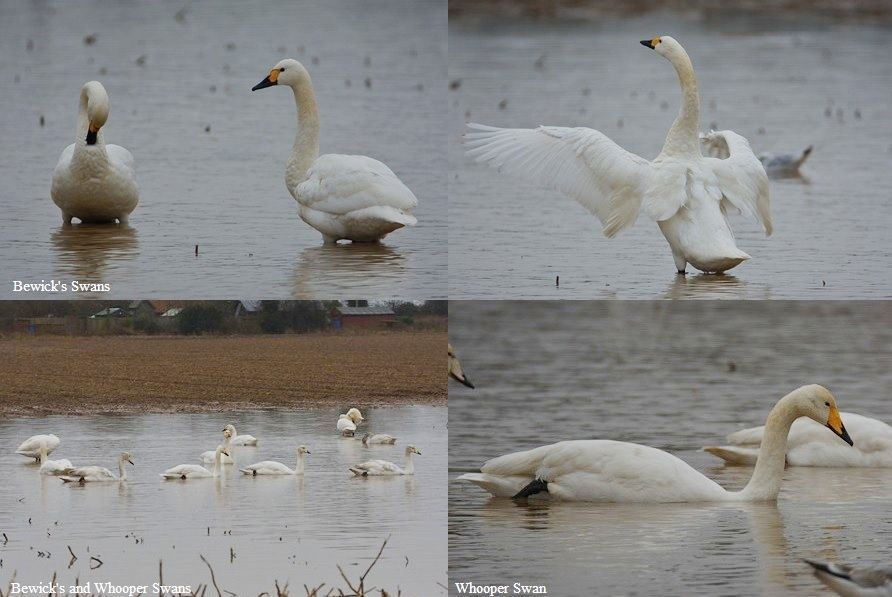
The first stop along the North Norfolk coast was at Beach Road, Salthouse where we found a male Stonechat on the fence wires.
At Beach Road, Cley we found both Brent and Pink-footed Geese but nothing else in their midst. Just leaving Cley Village a Cattle Egret was seen on a field and behind it in the distance was a Great White Egret.
At Morston Quay 2 Greenshanks were found along with, Grey Plover, 2 Curlew, 6 Redshank and 2 Little Egret.
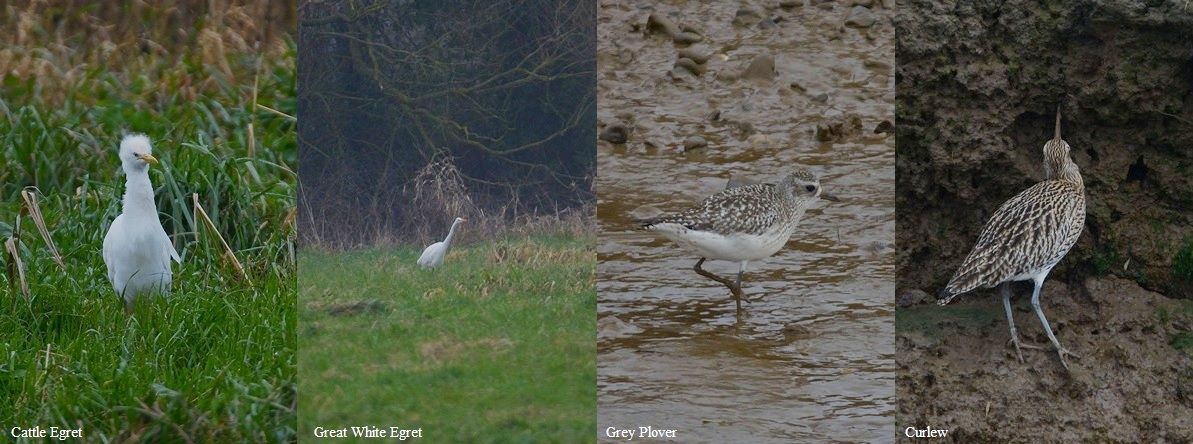
En-route to Holkham we saw 2 of both Red Kite and Common Buzzard, before a drive down Lady Ann’s Drive to have a look to see if we could find the Green-winged Teal, which had been present in recent days but not reported today. No sign of the American Teal but a nice collection of ducks; Wigeon, Teal and Shoveler were on the flooded fields and a Common Buzzard was seen some distance away.
Just before the village sign of Burnham Norton we found 4 Cattle Egrets in a field with 4 white blazed Horses and a little further along the road we found 4 more!
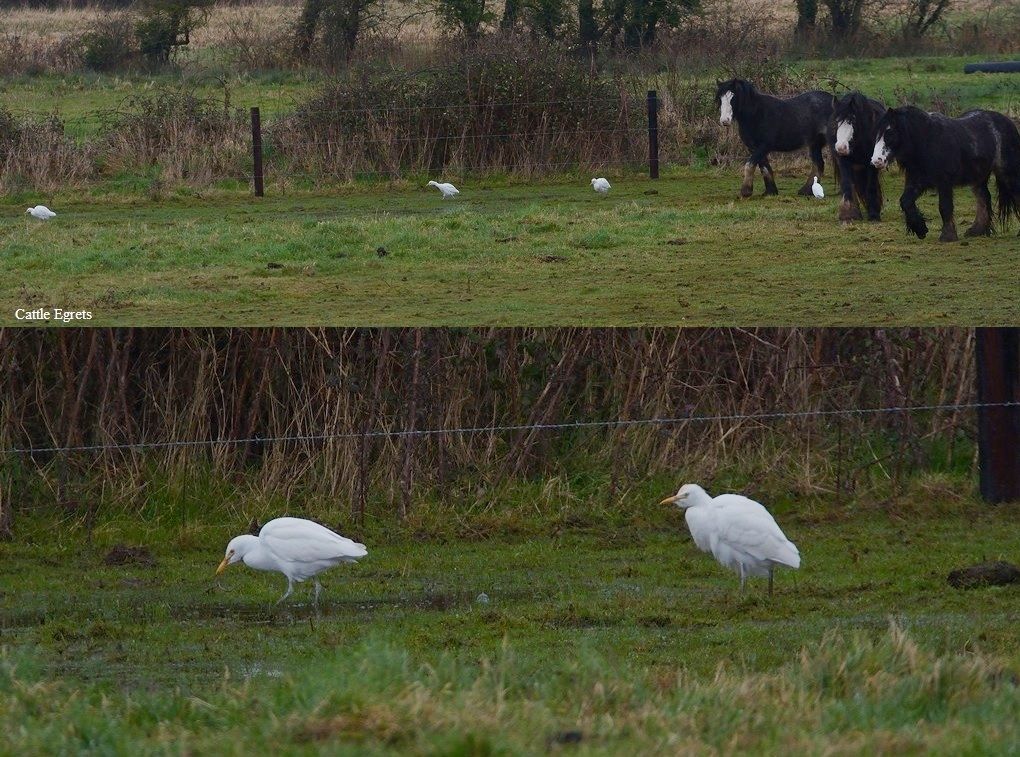
A stop for lunch at Brancaster Staithe found our first Avocet and other waders present included 6 Black-tailed Godwit, 10+ Ringed Plover, 12+ Dunlin, Redshank, Oystercatcher, Bar-tailed Godwit, 2 Curlew and 3 Little Egret.
Travelling back through Holkham we spotted a pale Common Buzzard and not far away a dark-phase individual. At Stiffkey there were 5 Red Kites in close proximity to each other.
A look for 2 Waxwings reported earlier at Cley drew a blank and with still no sign of any of the recent rarer geese (Red-breasted and Ruddy Shelduck), from Beach Road we headed home.
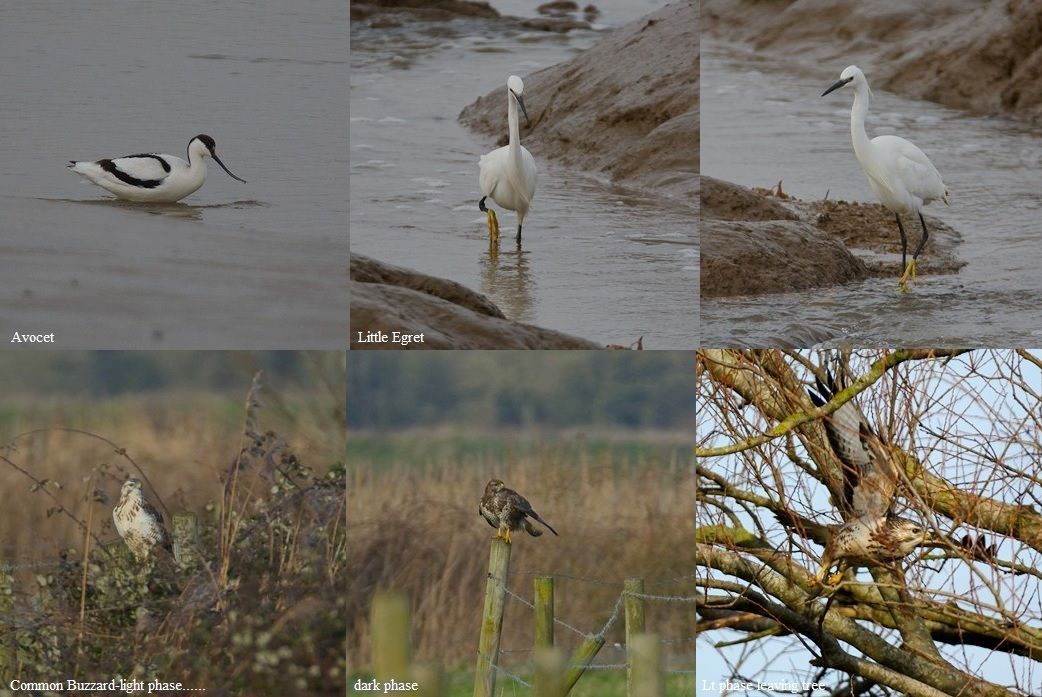
Cold weather brings birds closer......
Out along the Norfolk coast again with Jason Nichols (18th) began with the intentions of going to Holkham to look for Surf and Velvet Scoter and Shore Larks. However, as we approached Holkham a significant snowfall occurred and along with the icy wind it was decided to change our plans, so we decided to go to Brancaster Staithe first!
On our journey from Martham to Brancaster we saw 4 Common Buzzard, 2 Red Kite and a Fieldfare flying across the road, whilst Blackbirds along the hedgerows were notable.
So arriving to a deserted Brancaster Staithe (for once!) in the snow we saw Black-tailed and Bar-tailed Godwits, Oystercatchers, Turnstones, Curlew, Redshank, 2 Ringed Plover and Dunlin. Teal, Wigeon and Shelduck were also present along with several Brent Geese and 2 Little Egrets. I suddenly noticed on the far side diving ducks and eventually (when they surfaced!) we had our first Red Breasted Mergansers of the year; 2 drakes and 2 ducks.
Further on at Thornham Point a Rock Pipit perched on a boat was a bonus, before we decided to drive ‘around the block’ at Choosley.
Red Kites were immediately noticeable with one over the road and another over the fields. A very obliging Kestrel was perched in the hedge and remained there as we photographed it before carrying on, leaving the Kestrel in the same place. Snowy icy days can make birds come closer as they try to find a hunting opportunity or an unfrozen food source and this was panning out to be very much the case.
2 Common Buzzards were seen and a mixed flock of Finches numbering 500 or more contained Linnet, Chaffinch, Goldfinch and I picked out at least 2 Brambling when the birds settled on a hedgerow.
On the Mammal front; 2 Brown Hares hunkered down in a field and 3 Chinese Water Deer were seen.
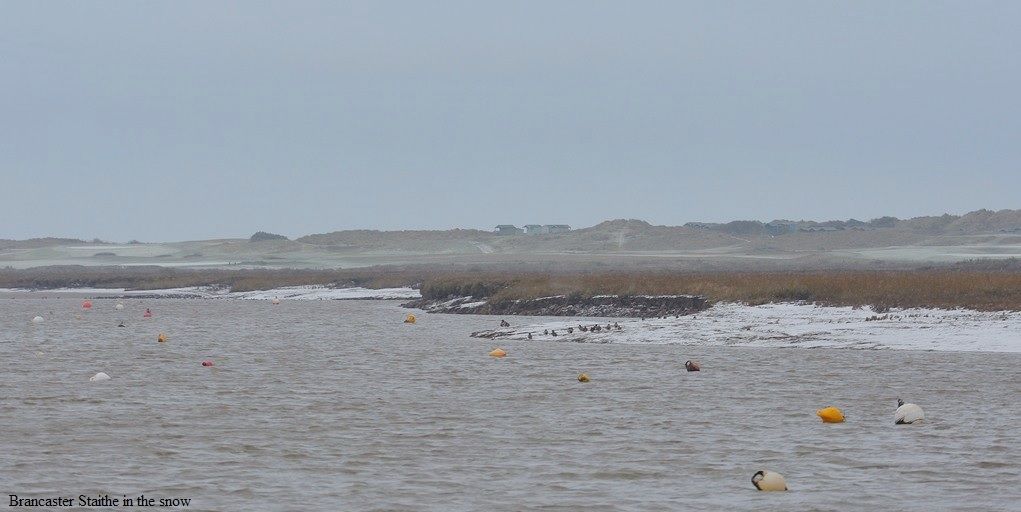


A look over Holkham Freshmarsh from ‘the gate’ found very little, not surprisingly in the frozen conditions and also heightened by the hides in a field containing shooters! No admittance to birdwatchers on this ‘nature reserve’ (and rightly too!) but not to paying gentry for the ‘thrill’ of killing something!
The second ‘lay-by’ was far more productive with 50+ White-fronted Geese, and Greylag and Egyptian Geese present, with Pink-feet flying over. Whilst photographing the white-fronts a Common Snipe walked passed a goose and scanning further it became apparent that there were far more seeking food in the freezing conditions, now lessened by a spot of sunshine and at least 30 snipe were counted, maybe more than that! Dunlin was also here and a veritable ‘flock’ of Moorhens were near the hedgerow and a very pale Common Buzzard was spotted before it flew off low over the marsh. Possibly the same one we photographed on a post last year.
I saw a Mistle Thrush fly into the nearby trees and disappear but then Jason said he could see it in the tree, but better was to come when it and another flew down amidst the Mole hills in the sunlight as they both searched for food; fantastic!
2 Muntjac were seen en-route as we headed for Wells, where we had lunch, but that was about it as very little of note here with the lagoons iced up.

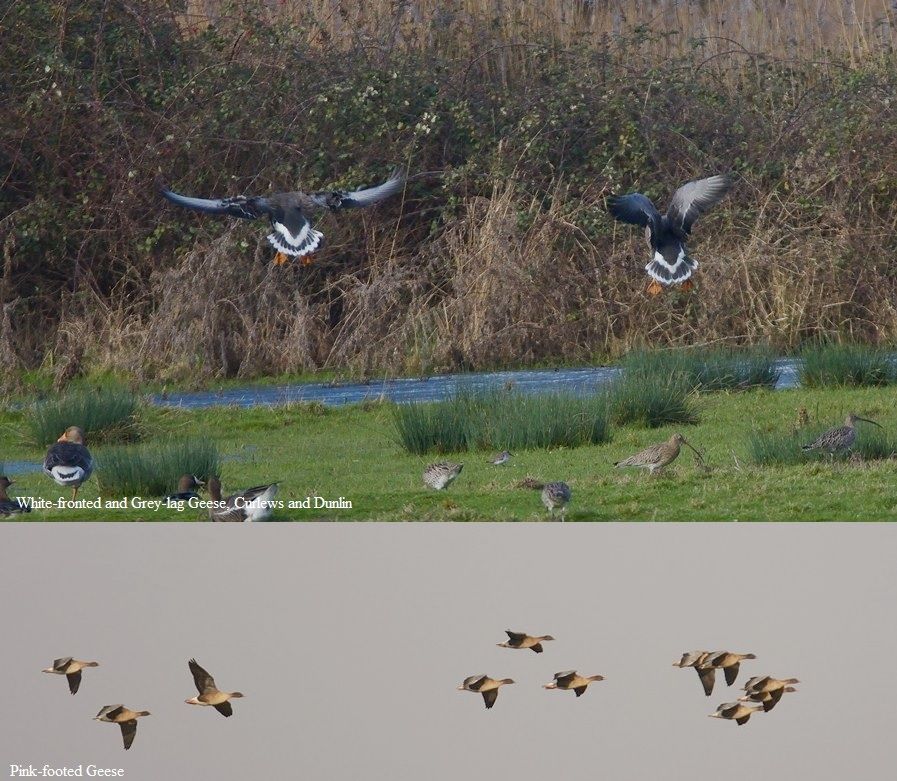
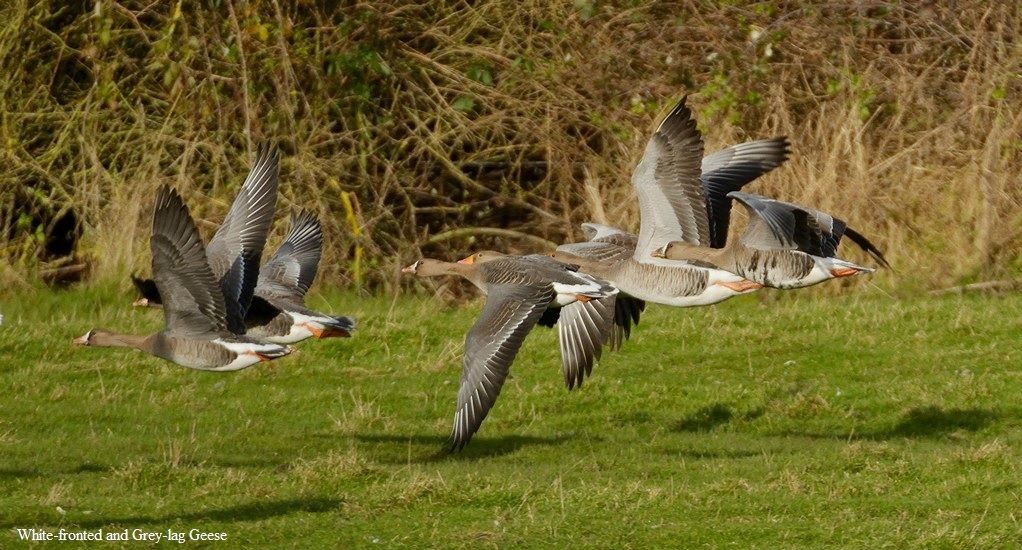
At Morston Quay there were approximately 200 Brent Geese were on the field, just before the entrance to the car park. High tide limited any waders present but we saw a Redshank swim to the bank (one of 4 seen) and at the top of the car park 16 Teal were on the water. Then a Short-eared Owl flew passed followed by another, then yet another! With a Greenshank at the edge of the pool to the south, a very worthwhile stop although the Brent Geese seen earlier had gone!
There had been a Glaucous Gull reported at Blakeney Quay, but we later found out that it was more near Blakeney Point! With nothing except 3 Herring Gulls along the channel we ventured a short distance to look over Blakeney Freshmarsh and here we found approximately 300 Brent Geese and the first Canada Geese of the year (19 in fact)! After looking through the Brents for something different we then moved on to Wiveton where we eventually found both the reported Cattle Egrets along with 2 Little Egrets.

At Cley’s Beach Road we found more Geese, with approximately 1000 Pink-feet and 200+ Brents. Whilst here a message came through to say that the recently seen Red-breasted Goose was on Blakeney Freshmarsh so we returned, but despite duel scrutiny we couldn’t find it. The same dead end was just before Cley village looking from the bank overlooking Blakeney Freshmarsh, where according to some that was where it had been seen from?
Back to Cley, Beach Road where the Brents were relocating but the Pink-feet were leaving the area. With nothing of note at Coastguards we left on another ‘wild goose chase’ at Weybourne!
A Ruddy Shelduck had been reported with the Pink-feet, just before the railway bridge. We found some Pink-feet but no Ruddy Shelduck. A Common Buzzard was seen here and on the opposite side of the road approximately 100 Brent Geese, but by the time we got anywhere near to look through them (thanks to some very selfish parking by a camouflaged ‘birder’) they had gone.
We made our way towards home but looked for the Bewick’s Swans reported earlier on a flooded field at Sutton, but from the Stalham By-pass there was no sign of a flooded field, let alone swans! So, we stopped and Jase checked the details on his phone to find that they were not by the A149. We followed the sat-nav to a field between Sutton and Hickling and found what could only be called ‘swan lake’! A pool in the field was full of Swans and not far from the road, once again highlighting how birds will trade off safety in order to get essential life-saving resources. Here I roughly counted (may have missed some) 71 Swans with the vast majority being Whoopers but there were at least 4 Bewick’s. Bewick’s are the only ‘wild swans’ to get reported nowadays and I don’t understand why. Are Whooper Swans really that ‘common’ (interpret the word as you wish, everyone else does)?!
With the sun setting behind one of the Mills in Hickling and the swans in the foreground I tried to capture the scene but by the time I had got in position most of the sunset had gone. Still, an awesome sight to end what was a very productive day.

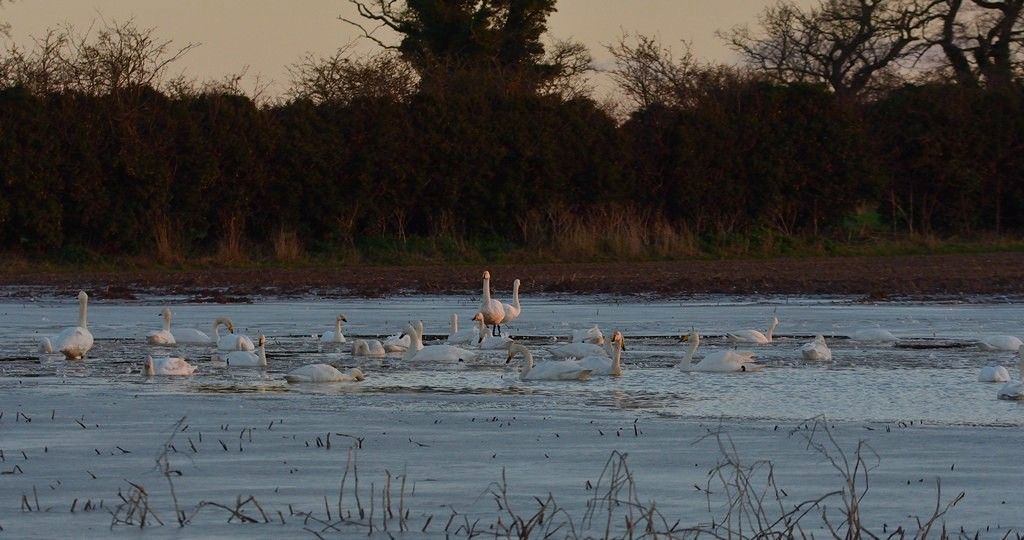
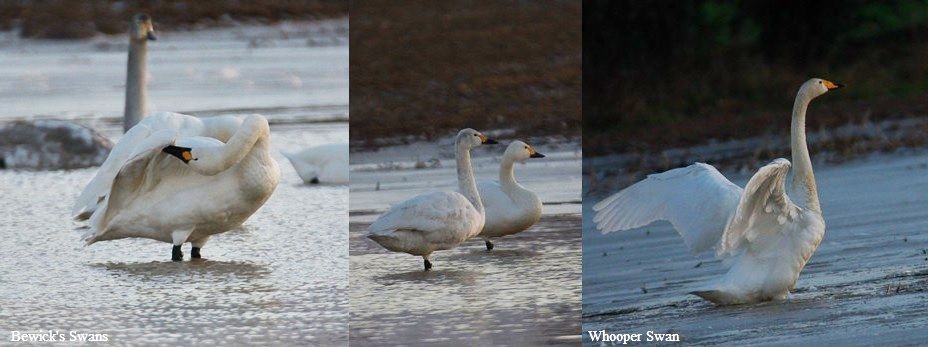
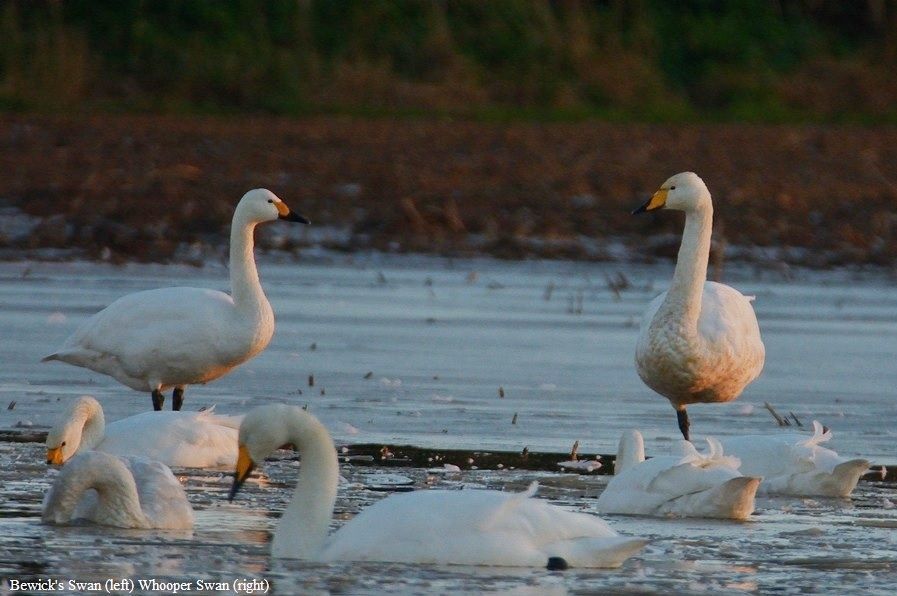
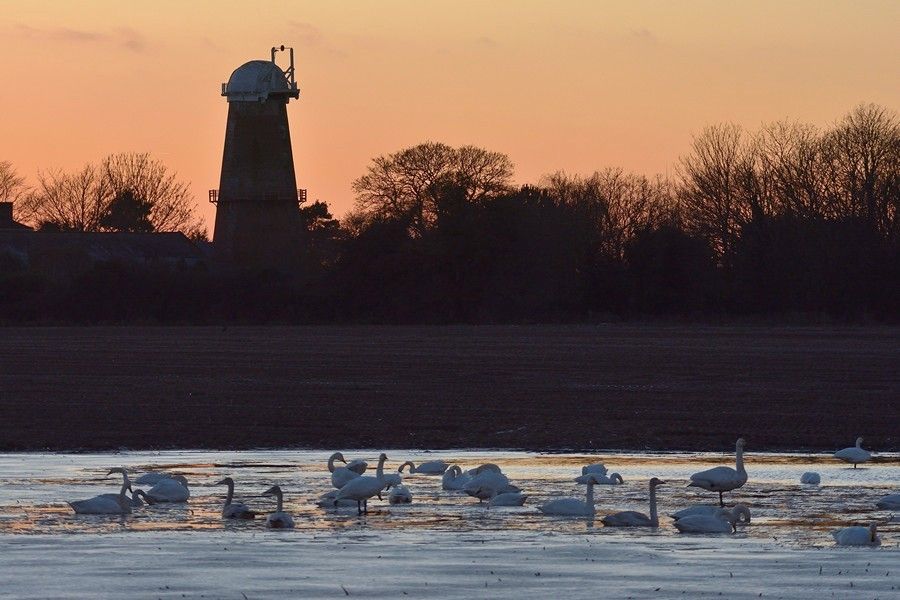
Round the block Birds......
A drive around ‘the block’ (14th) found a few nice sightings, as well as putting some charge into the depleted car battery!
The area around Clippesby eventually yielded some Cranes. It was a good thing I looked in a wide area from where they usually favour because in doing so I found approximately 10 largely concealed by a dip in the field. Two more Cranes flew in so I am guessing there were now at least 12 birds, but couldn’t be sure. Both a Marsh Harrier and a Common Buzzard were also of note here as were a flock of approximately 150 Lapwings.

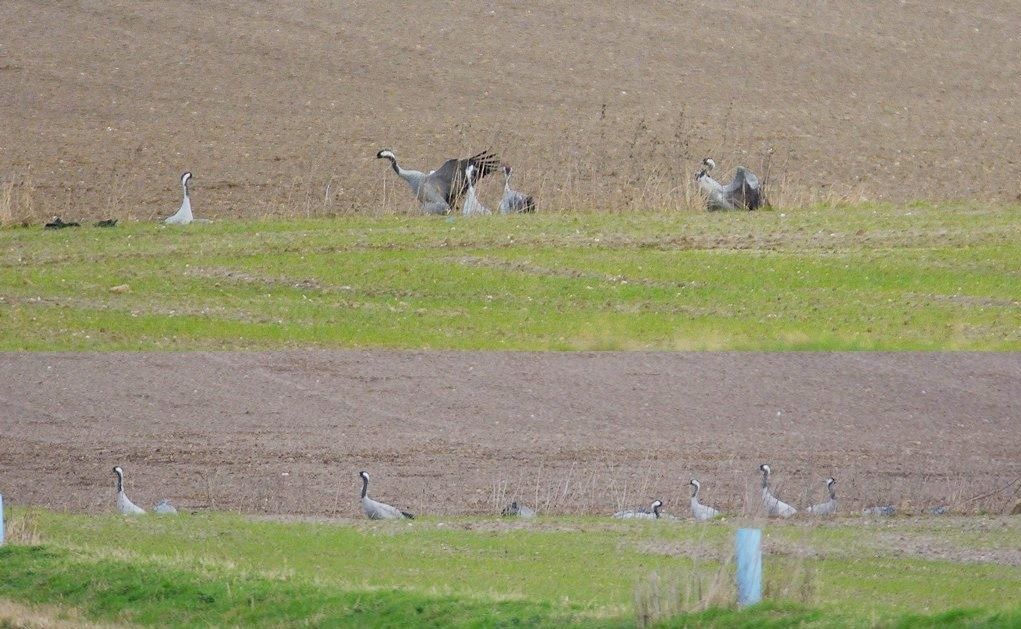
Not too much else was seen as I neared the end of ‘the block’ and driving past Ludham Airfield did not find any ‘white birds’ indicating Swans.
Turning towards Hickling the drive up until the end of the village when a Song Thrush flew across the road was fairly uneventful, but driving along the narrow winding road towards Sea Palling I stopped to look at a ‘white bird’ next to a cow. As suspected it was a Cattle Egret and this was then joined by another one flying in.

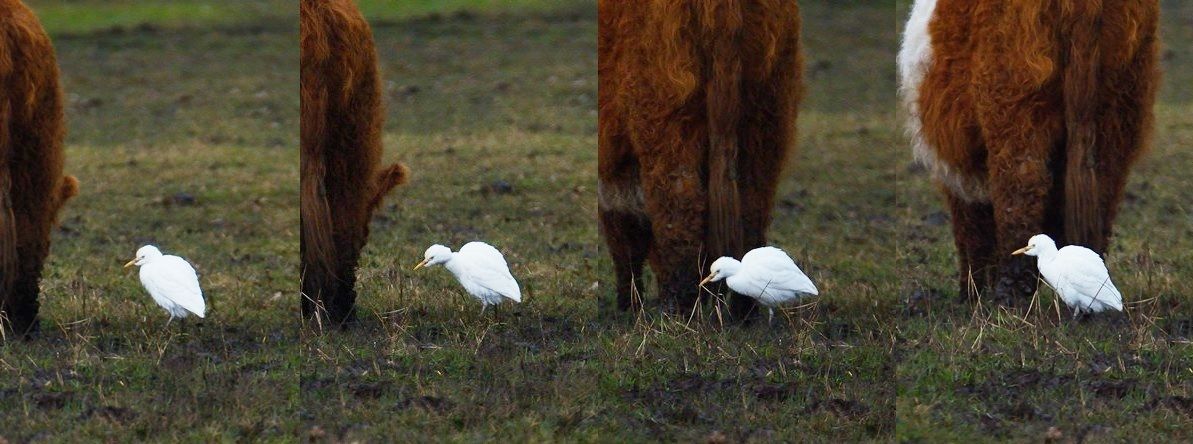
A Common Buzzard was seen just before Waxham on a field but refused to have its photo took as they often do when you stop!
I stopped in the ‘lay-by’ at Horsey and scanned around, initially just seeing a few Lapwings and hearing a Redshank call. But scanning along the flood bank I came across 2 Red Kites perched in the bushes. A few Pink-footed Geese flew over before heading home again.

'The only way is Essex'? Maybe not!
It is not very often that Jason and I travel a considerable distance for a species of bird, but today (11th) with the potential of seeing a North American visitor, neither of us had seen before was an exception to the rule.
For about a week now a Northern Waterthrush had been found in someone’s garden at Heybridge near Maldon and had been present on and off for just over a week at Heybridge Creek. I saw it reported on BBC Breakfast 10th and later that day Jason emailed me to ask if I was interested in going to see it, despite having recently having an abscess on a tooth and his car going in the garage! So at 05.30 we left for Essex!
Eventually we reached the car park just after 08.00, designated as the place to park to avoid upsetting the residents and set off on the path alongside the River Blackwater.
The river was iced up and Moorhens were walking across it, which gave rise to a brief spot of photography. Also here were Cetti’s Warblers with two flying across the river and landing in the short reed fringe close to us, but typical of this warbler it never revealed itself, except when it flew off. There was also a very strong smell of Fox but one was not seen.

After a long walk alongside the river we crossed a bridge and then walked through a housing estate until we reached the area where the Waterthrush had been seen, along a dyke near an industrial estate. At least 25-30 people were already there and it became very clear they had not parked in the car park where we had parked and had parked somewhat closer, which in hindsight we also could have done!
So we stood on the bank at the end of the line of other attendees and waited. The bird had been reported earlier at approximately 07.30 so presumably at the least it was still here.
There were several Song Thrushes around and House Sparrows were coming down to the water’s edge to drink. A Muntjac crossed the far end of the dyke and 10 Brent Geese, and 2 Mute Swans flew over, but there was no sign of the Northern Waterthrush, but as is typical on such occasions not very many of the audience were actually looking for it, instead waiting for someone else to find it, but that is the way of ‘twitches’ nowadays!
Time went by and there was no sign as we stood there in the cold, questioning what the hell we were doing! So, just before 11.00 we decided to start the long way back to the car.
A stop at a nearby fast food takeaway on the drive back is where Jase found out that the Waterthrush had reappeared around midday! Later, we found out it had again reappeared twice in the afternoon but nothing we could do about it; all a bit of a lottery, for which we didn’t have the winning ticket!
On the drive back we saw several RTA’s. These consisted of 2 Badger, 3 Muntjac, 3 Chinese Water Deer, Hare, Rabbit and several Pheasants. The last Badger RTA was between Thwaite and Stoke Ash in Suffolk.
We decided to go and spend an hour or so with the Short-eared Owls at Ludham Marshes before calling it a day. We saw one plus 2 Chinese Water Deer (alive this time!) from the road leading to St. Benet’s Abbey but no more than that.
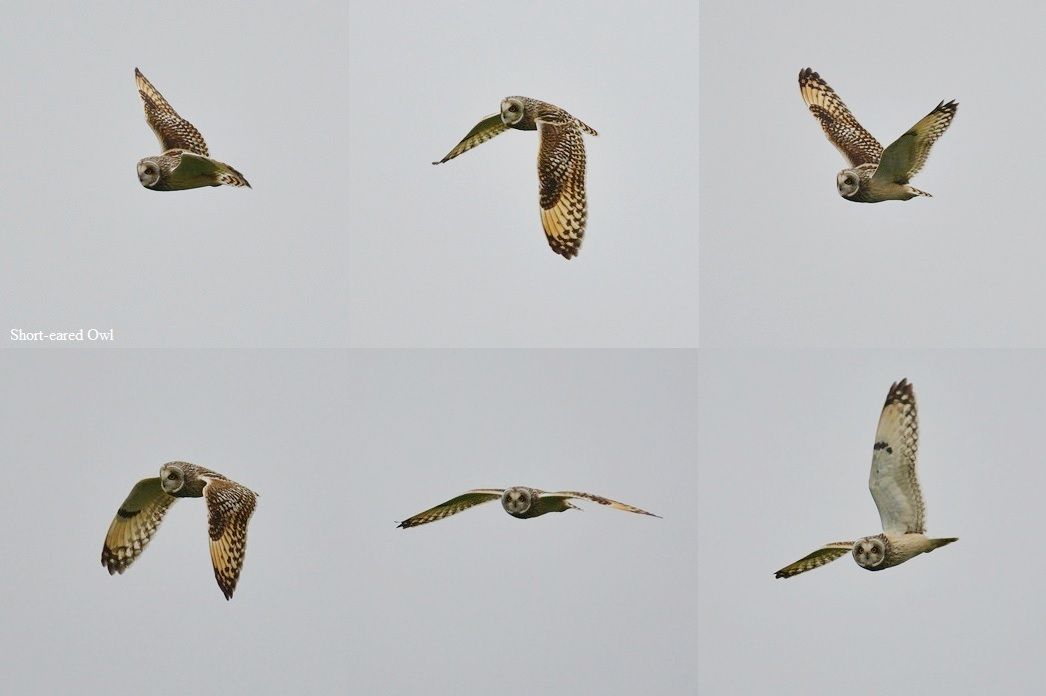
We then ventured down the other road leading to the river bank and Jase had a look from the top of the bank and saw 2 distant Cranes, 2 Short-eared Owls and a Marsh Harrier back towards St. Benet’s.
As Arkwright would have said: ‘ It’s been a funny ol’ day’!
Happy New Year! The Bird and Mammal count......
At 05.30 Jason arrived to pick me up to make our usual New Year’s Day bird count and for that matter anything else we might see.
The morning began with dead animals, unfortunately with a Red Deer RTA between Martham and Repps followed by a Barn Owl on the road near Dilham. It wasn’t until we approached a roundabout at Fakenham that we saw our first live animal. Firstly a shadow was seen made by the street lights of an Owl, which on seeing what had made the shadow, not surprisingly turned out to be a Barn Owl.
On the way to Holkham Park a Rabbit crossed the road my first mammal (rather fittingly!) although Jase had had seen a ‘Mouse’ earlier. We parked in the car park at Holkham Park in the hope we might hear a Tawny Owl calling, but not too be. However, a couple of Fallow Deer were seen and Pink-footed Geese were heard.
Just outside Holkham we had a Little Owl fly low across the road. It had obviously been on the ground looking for prey before flying, which was a total surprise as we had never seen a Little Owl at this location and for that matter nowhere near the spot!
Red-legged Partridge is notoriously difficult to find on New Year’s Day probably because they have been shot at, so we were grateful for two flying over some houses at Brancaster.
We arrived at Titchwell and in the half light saw Blackbird, Mistle Thrush and Robin along the approach road before taking up residence in the car park for coffee and to watch and listen for anything we could record before embarking on the walk to the beach.
Wood Pigeon, Black-headed Gull, Blue Tit and Starling were added to the day’s count before walking along the path towards the hides and beach, where we saw yet another notoriously difficult bird to see on this day, a Pheasant! At least 4 Marsh Harrier came out of their roost to begin hunting and a Bearded Reedling flying high above the reedbed was fortuitous.
From the path we scanned the pools and surrounding area picking up Curlew, Little Egret, Teal, Mallard, Grey-lag Goose, Brent Goose, Cetti’s Warbler, Shoveler, Lapwing, Linnet, Redshank, Golden Plover, Shelduck, Pintail, Black-tailed Godwit, Common Gull and Wigeon before arriving at the beach.
Scouring the shoreline and sea we found Herring Gull, Oystercatcher, Goldeneye, Common Scoter, Dunlin and a flock of Bar-tailed Godwits, exceeding 200 birds. Turnstone followed, as did Grey Plover, Ringed Plover (again sometimes difficult to find), Lesser Black-backed Gull and Sanderling.
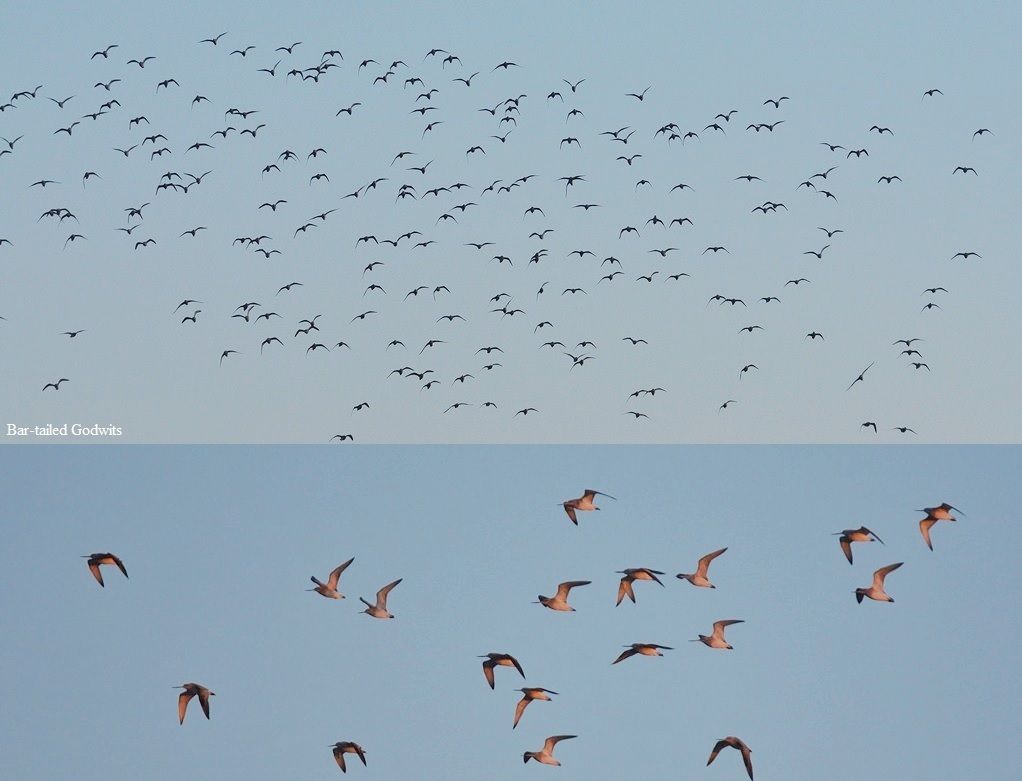
At Thornham; Jackdaw, Greenfinch and Kestrel were added and at the harbour area a Greenshank (50th bird) was a nice surprise roosting on the bank with Redshank and a Little Egret. Also here were Great Black-backed Gull, Skylark and Meadow Pipit, but sadly no Rock Pipit seen in previous visits and nothing in the channel as the tide was high.

A drive around Choosley Barns followed and here we saw Chaffinch, Pied Wagtail, Red Kite, Common Buzzard, Brambling (at least 3 with Chaffinch and Goldfinch), Collared Dove, Carrion Crow, and a welcome Sparrowhawk.
Brancaster Harbour found our first Cormorant (flying over) but not much else due to the high tide.
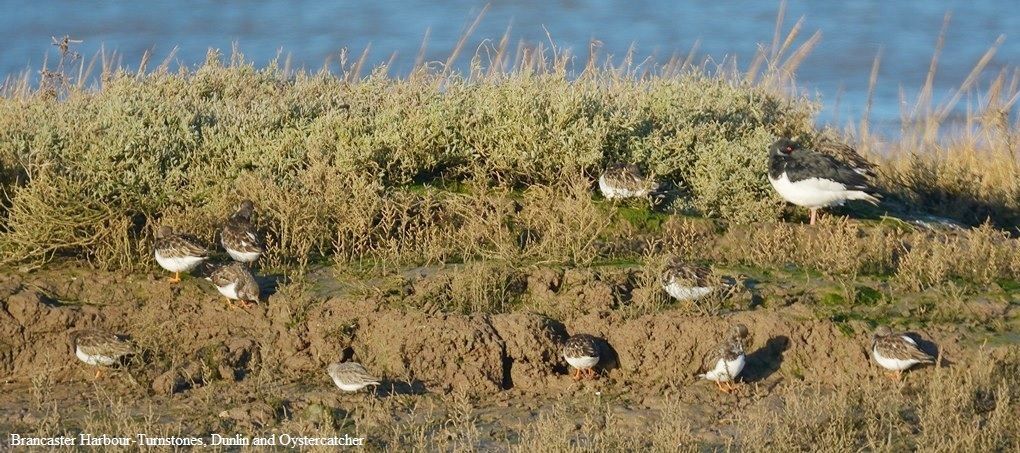
En-route a Stock Dove was seen followed by Mute Swan from the A149 lay-by at Burnham Overy and Feral Pigeon.
Egyptian Goose was found at Holkham and parking at ‘the gate’ a surprise was in store when Jase saw a Raven (his first in Norfolk) and I heard the classic ‘cronk’ call from the open window of the car. At least 3 Chinese Water Deer were here and a Great White Egret was also present.
A little further along the road we parked in the pull-in and found a family of White-fronted Geese on the field before returning to the car park at Holkham Park.

Walking into Holkham Park a Jay was heard and later seen, along with Great Tit, Nuthatch and Long-tailed Tit before arriving at the lake.
Here, Tufted Duck, Coot (finally!), Great Crested Grebe (not expected here), Pochard, Grey Heron, Little Grebe and what looked like a Scaup, although we couldn’t be sure and more Fallow Deer were on the other side of the lake.
A couple of Grey Squirrels joined the mammal list, before from the end of the path near the gates a garden bird table provided a Coal Tit, before we set off again back along the coast.
The Glossy Ibis had obligingly remained on the flooded field at Stiffkey and here too we saw our first Rooks!
We looked for a reported Cattle Egret at Morston but couldn’t find it. However, the paddocks (we once named ‘Thrush Corner’) provided 2 Redwing in amongst the Blackbirds.
Beach Road, Cley found no Canada Geese (where do they all go on New Year’s Day?) but the Red-breasted Goose was found amongst the Brent Geese; a bonus for the 1st of the year!

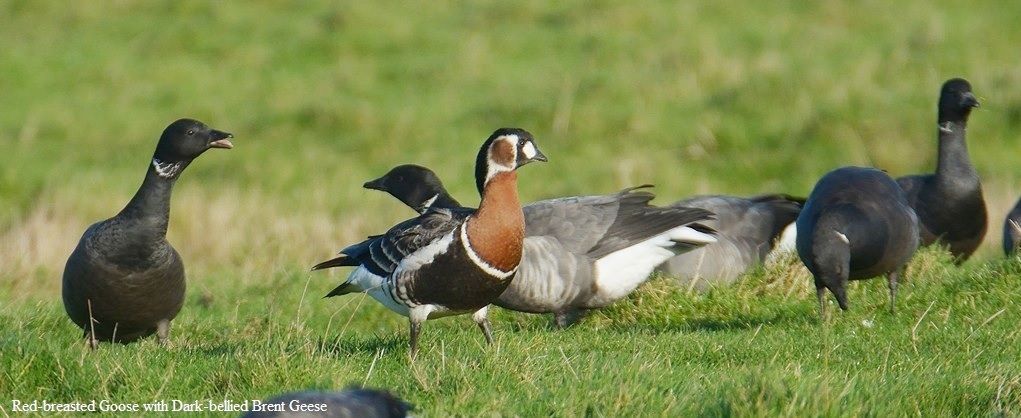
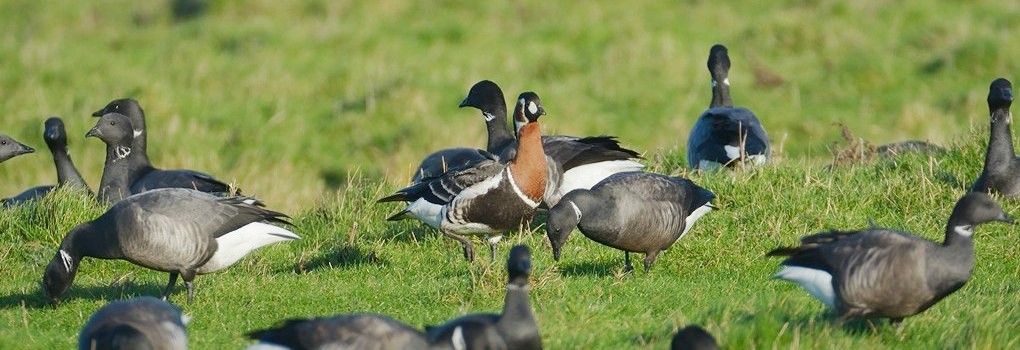
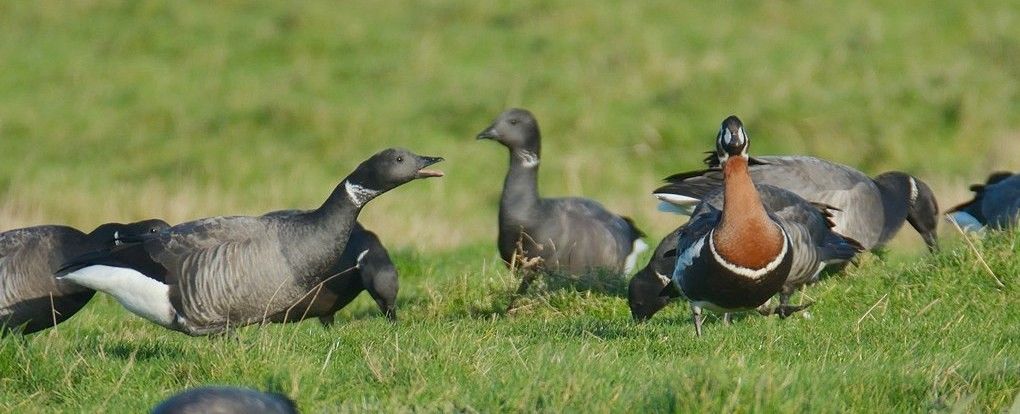
House Sparrows (finally!) at Cley village were our 85th bird before seeing our first Moorhen on Salthouse duck pond-where else!’
A stop at Weybourne found a Red-throated Diver and a Guillemot (also Common Scoter) on the sea from the wind-blown shingle ridge and a Water Rail was heard calling from the reedbed just before getting back in the car.
It was now a matter of deciding where else we could go to get a few more birds before the light went, so we decided to go to Ludham marshes near St. Benet’s Abbey.
The first new bird for the day we saw here was a Short-eared Owl, one of at least 5 seen, although there may have been more.
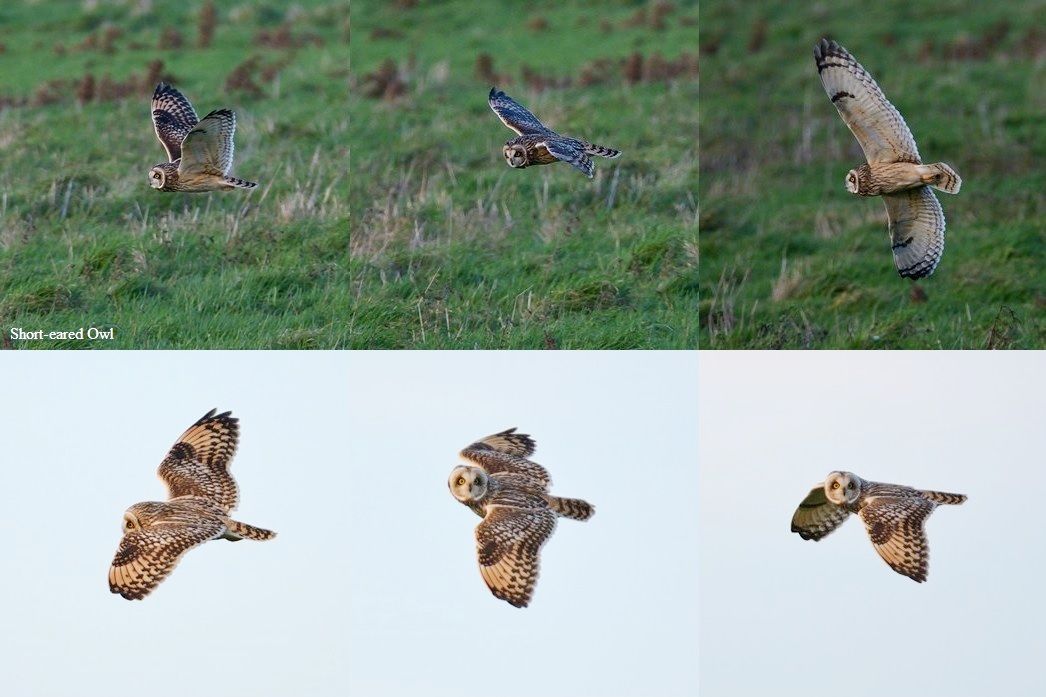
Whilst photographing a Short-eared a Chinese Water Deer shot out onto the road a few feet in front of me. It skidded on the road, falling on its side before quickly ‘picking itself up’ and ran off across the opposite field. Just a few seconds after a Short eared Owl flew over the road in the same direction. Whether it was the owl that spooked the deer is unclear and certainly not a prey species for a shorty!!
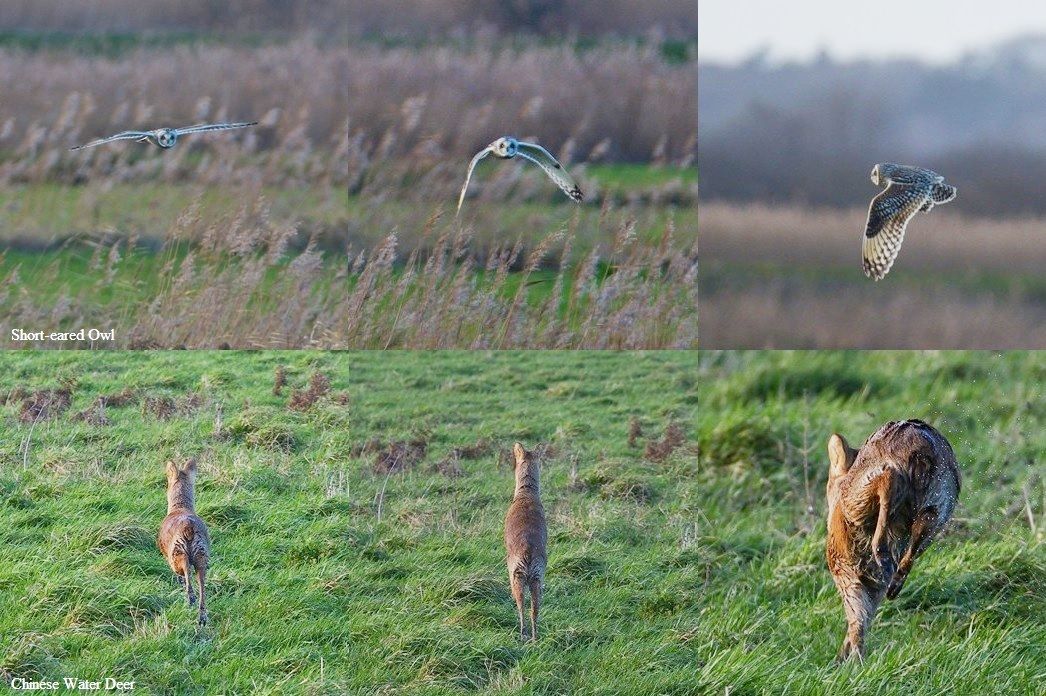
3 Cranes were seen and a Barn Owl appeared. Finally we saw a Dunnock, Jason identified some distant Whooper Swans and then another bird missing from our list appeared in front of us; a Wren!
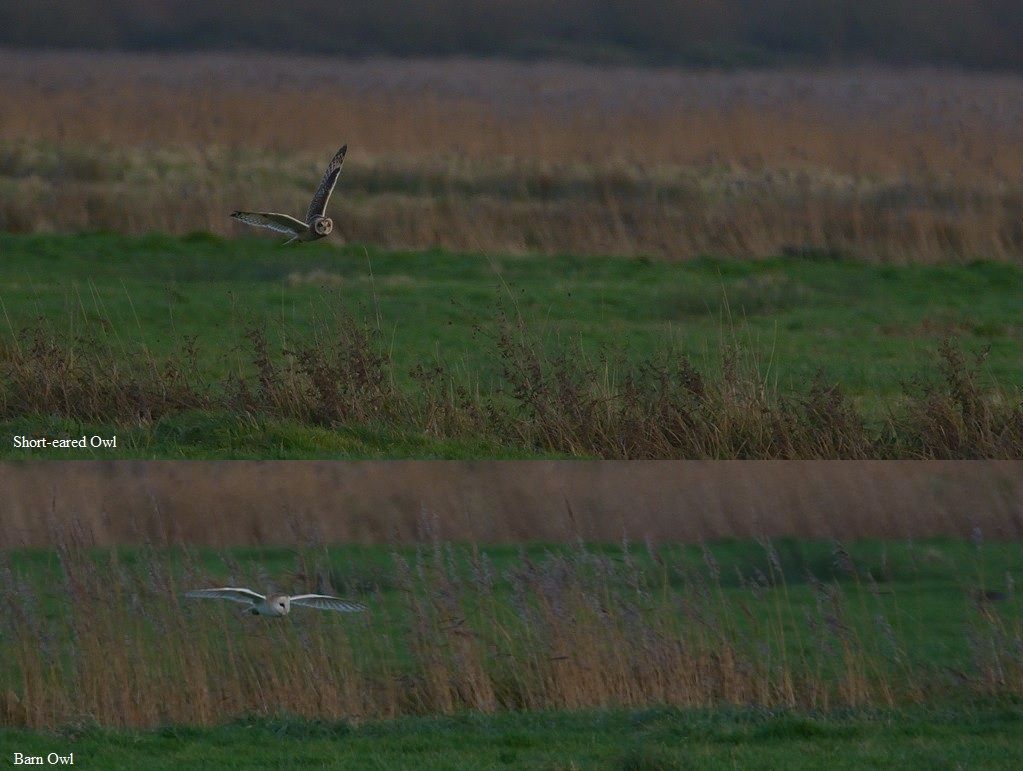

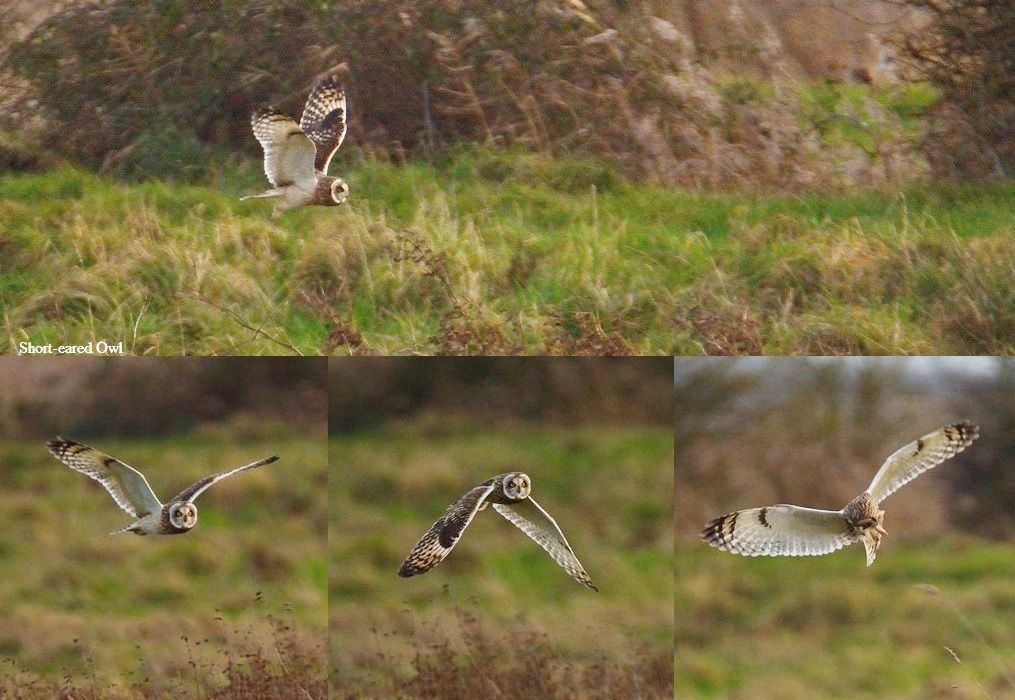
Finally, at the end of the road before turning towards Ludham village we saw a flock of Fieldfares; our final sighting of the day and after a very long day (05.30-approx 16.00) we headed home.
We managed to see 95 species of birds and 4 species of Mammals. Thanks are due to Jase for doing the driving and his contributions to a very enjoyable day.
All Rights Reserved | Perry Fairman, Ecological Experiences